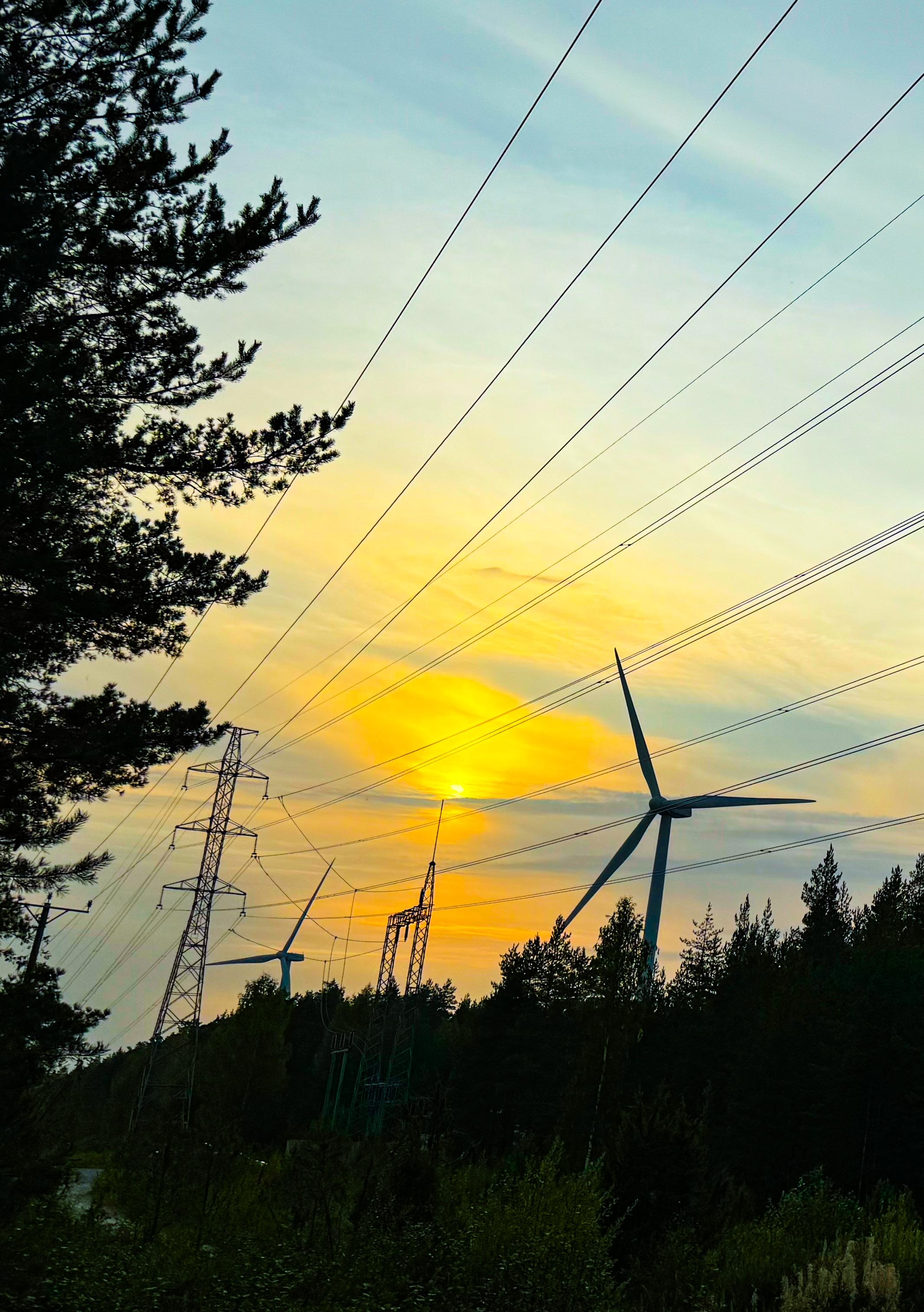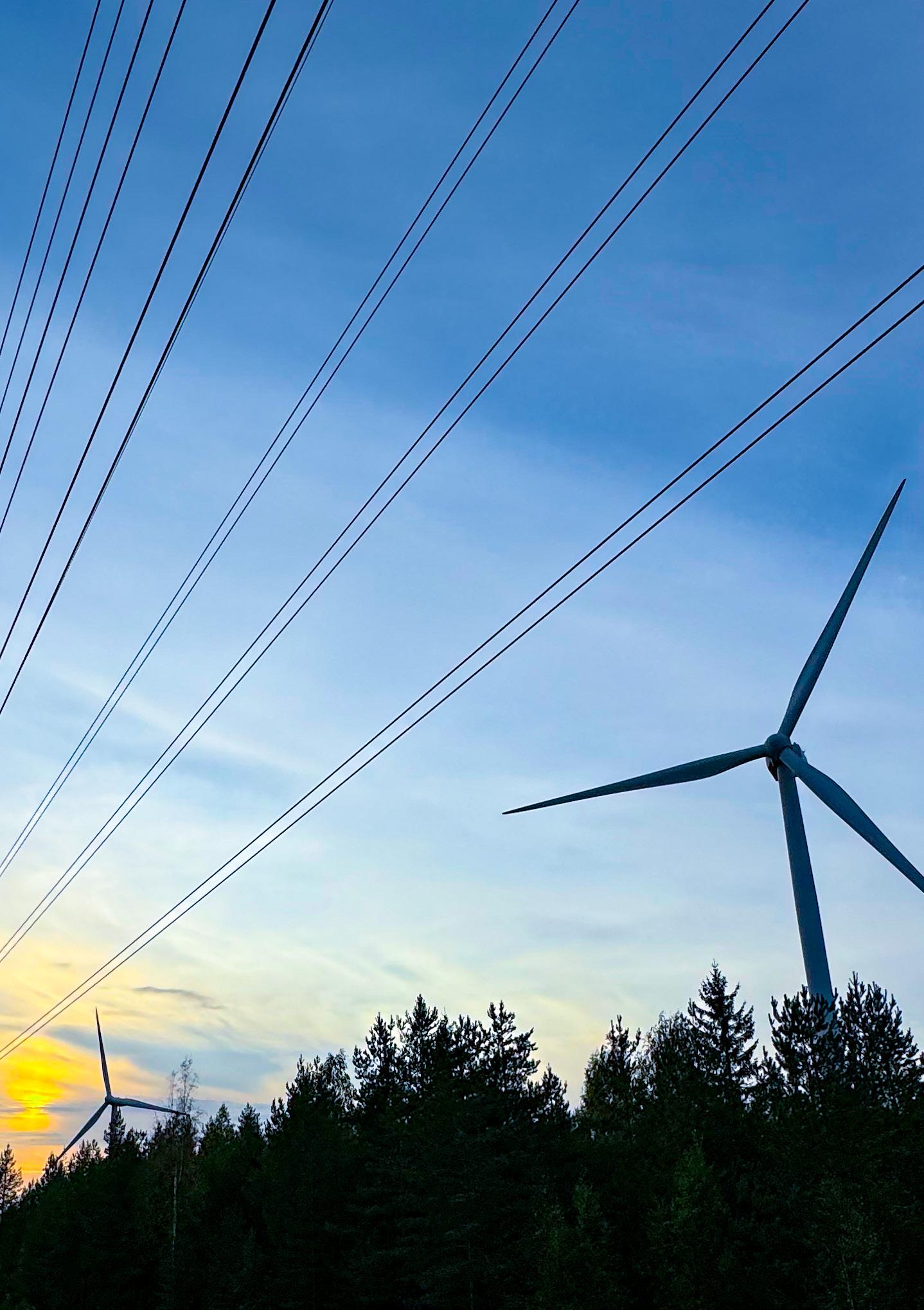
LUT University’s


LUT University’s
2024 | Secure, sustainable and affordable energy

Secure, sustainable and affordable energy 9/2024
Editors: Eeva-Lotta Apajalahti, Timo Hyppänen
Subeditor: Janina Jokimies
Writers:
Esa Vakkilainen
Christian Bryer
Tero Tynjälä
Hannu Karjunen
Salla Annala
Jasmin Jaanto
Jouni Havukainen
Samuli Honkapuro
Jani Sillman
Risto Soukka
Ayesha Sadiqa
Alicja Dankowska
Roosa Talala
Hanna Paulomäki
Svetlana Proskurina
Clara Mendoza Martinez
Katja Kuparinen
Tapio Ranta
Juhani Hyvärinen
Heikki suikkanen
Olli Pyrhönen
Katja Hynynen
Petteri Laaksonen
Antti Kosonen
Teemu Turunen-Saaresti
Pertti Kauranen
Jero Ahola
Aki Grönman
Jukka Lassila
MORE INFORMATION: media@lut.fi firstname.lastname@lut.fi lut.fi/energyoutlook
LUT Scientific and Expertise Publications / Reports
Series number: 132
ISSN-L 2243-3384, ISSN 2243-3384
Printed publication: ISBN 978-952-412-142-2
Online publication: ISBN 978-952-412-143-9 (PDF)
Layout: Mirkka Vaherkylä
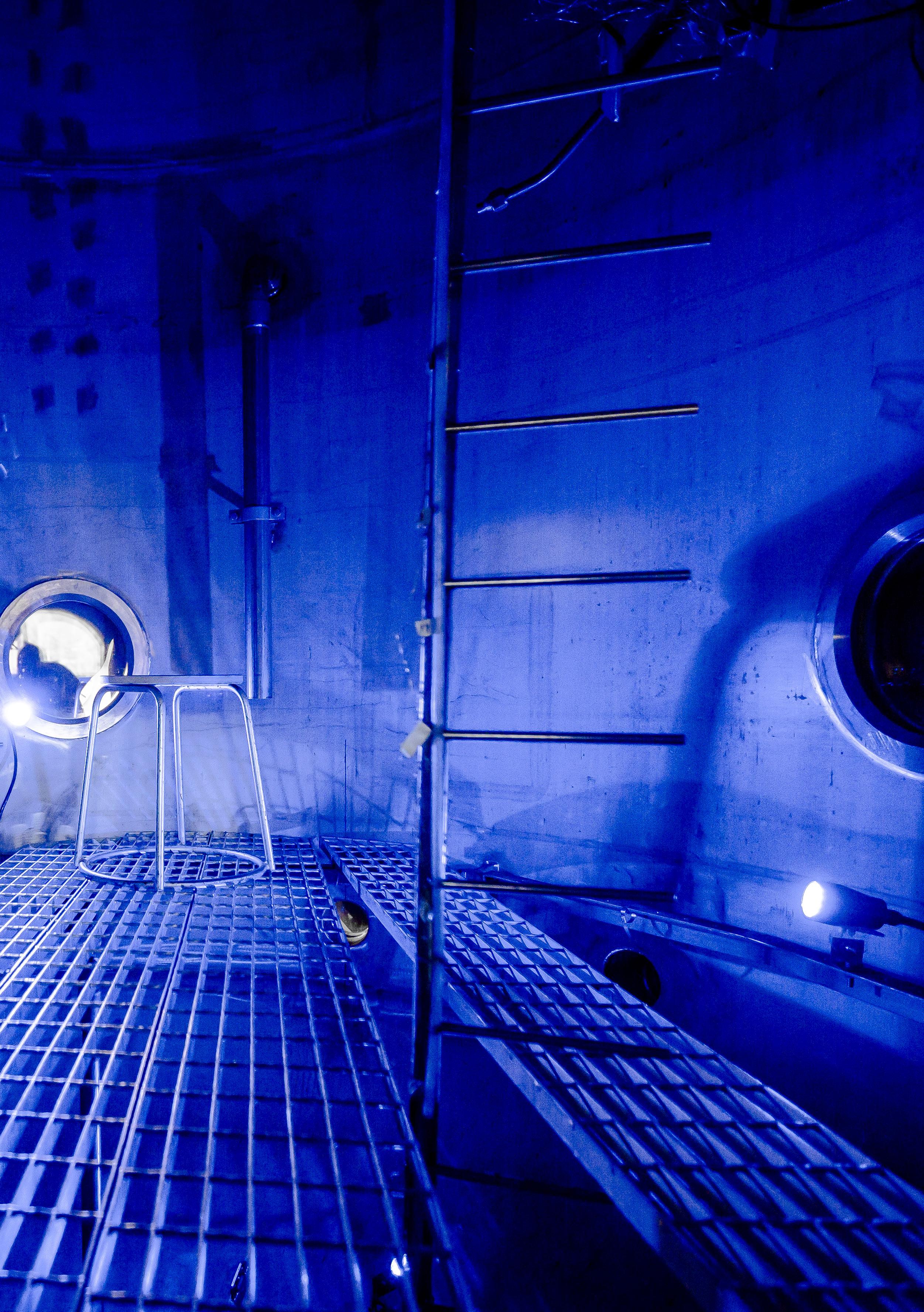
Text: Eeva-Lotta Apajalahti, Timo Hyppänen, Ayesha Sadiqa, Roosa Talala, Hanna Paulomäki
2.1

3.1
3.2
3.3
Hannu Karjunen, Tero Tynjälä
3.5
Text: Esa Vakkilainen
3.6
Text: Tero Tynjälä, Hannu Karjunen
4. ENERGY
Text: Samuli Honkapuro, Salla Annala and Jasmin Jaanto
4.3
4.4

Text: Eeva-Lotta Apajalahti, Alicja Dankowska, Jouni Havukainen, Clara Mendoza Martinez, Hanna Paulomäki, Jani Sillman, Risto Soukka, Ayesha Sadiqa, Roosa Talala
5.1 Sustainability targets and aims in Finland 41
5.2 Opportunities and risks for Finland in the sustainability transition of energy systems 43
5.3 The increasing role of citizens and communities in energy systems 50
6.1
6.1.1 Bioenergy
Text: Esa Vakkilainen, Katja Kuparinen, Clara Mendoza Martinez, Svetlana Proskurina, Tapio Ranta
6.1.2 Nuclear energy 54
Text: Juhani Hyvärinen, Heikki Suikkanen
6.1.3 Wind power ....................................................................................... 56
Text: Olli Pyrhönen, Katja Hynynen, Petteri Laaksonen
6.1.4
Text: Antti Kosonen
6.1.5 Heat pumps (and geothermal) 59
Text: Teemu Turunen-Saaresti
6.2 Other energy technology, energy saving and energy communities 60
6.2.1 Hydrogen solutions 60
Text: Tero Tynjälä, Jero Ahola, Pertti Kauranen, Petteri Laaksonen
6.2.2 Carbon management ........................................................................ 62
Text: Hannu Karjunen, Tero Tynjälä
6.2.3 Energy storage 63
Text: Pertti Kauranen, Aki Grönman, Jukka Lassila, Teemu Turunen-Saaresti
6.2.4 Energy saving and energy efficiency 65
Text: Jero Ahola, Esa Vakkilainen, Teemu Turunen-Saaresti
6.2.5 Energy communities 67
Text: Eeva-Lotta Apajalahti, Alicja Dankowska
LUT University has a long tradition in energy engineering research, and it is one of the university’s key focus areas. Energy systems are developing fast at the moment, and ongoing energy transition has created the need to produce societally relevant and reliable information about energy systems changes.
The third important task of universities, in addition to teaching and research, is to provide understandable expert knowledge to civil society and decision-makers. LUT University’s versatile expertise in the energy field provides a good opportunity to report on the development prospects of energy systems for the needs of society.
The development of the energy system affects the everyday life of all citizens. The system’s reliability and cost-effectiveness have a significant impact on the performance of companies and the national economy and thus indirectly on the financing of public services. In particular, the concentration of wind power investments in Western Finland shows how the energy system also affects Finland’s regional development. The importance of energy in international crises cannot be overemphasized. Russia’s invasion of Ukraine and the resulting energy crisis in Europe are the most recent examples of this.
LUT University published its first energy report in 2022. As did the first report, the second report aims to produce up-to-date, expert-level information on the development outlook, challenges and opportunities of the energy system for both experts and ordinary citizens. This time, an English version of the report is also available to serve an international readership interested in Finland’s energy system.


Olli Pyrhönen Dean LUT School of Energy Systems

You are reading the LUT Energy Outlook 2024. This is the second publication from the School of Energy Systems and a joint effort by our researchers to provide updates and basic information on our constantly evolving energy systems.
In this Outlook, LUT experts in the field of energy systems provide popularized information on energy-related topics based on LUT’s most recent research and other up-to-date sources. The Outlook aims for an explanatory, clear tone providing references that we consider reliable. The Outlook is directed towards anyone interested to know more about energy systems including policymakers, officials, educators and associations, and serves the following purposes:
» To fulfil the so called “third mission” of universities to generate and share knowledge and output to the benefit of society and its development
» To address energy system-related challenges faced by society and the national economy
» To support the development of Finland’s carbon neutral strategy and the national low-carbon energy transition.
» To support the actors of society in their energy decisions and investments.
» To provide information to anyone interested in energy systems, the energy transition in Finland and globally, the key elements of energy systems, and updates on different energy technologies.
» To function as a common platform for LUT researchers to contribute to societal development
The current LUT Energy Outlook builds upon the previous Outlook, Towards carbon neutral Finland, published in 2022 (LUT 2022a). These two publications form a continuum for describing the ongoing energy transition in Finland and how Finland is pursuing carbon neutrality. Both Outlooks also intend to provide an up-to-date general overview of the EU-level
and global events and circumstances that have implications for Finland. The current Outlook offers updates on the developments in different energy technologies but does not repeat their individual descriptions which are available in the 2022 Outlook.
While compiling and finalizing the previous Outlook in 2022, the signs of the emerging energy crisis were becoming clearer. However, the 2022 Outlook focused on describing the essential concepts and technologies of the energy system and providing three pathways to carbon neutrality. It was too early to determine what changes Russia’s invasion of Ukraine and the ensuing economic sanctions would bring and what the longer-term consequences would be. We now know that the energy crisis had immediate and medium-term effects on issues such as increasing electricity prices throughout Europe, the security of energy systems, and geopolitical risks.
In addition to the recent challenges of the energy crisis, the energy transition is changing the energy system rapidly due to several factors, including emergence of high shares of variable renewable energy, the need for faster development of infrastructures, flexibility and storage, the fluctuations of electricity prices, the need to accelerate the carbon phase-out, the pressure to use biomass and land sustainably to reach biodiversity targets and maintain carbon sinks, the development of small modular reactors and required legislative changes, and various developments in hydrogen and powerto-x solutions. When confronted with a crisis, people tend to rely on something familiar, resorting to the basic building blocks of their life. In this Outlook, we also return to the basic building blocks of our energy systems and to the most fundamental societal question: how to secure clean, sustainable and affordable energy in the future.
We are on the verge of changes brought by the above-mentioned factors. However, the basic
building blocks with which we are building our energy future remain the same. Therefore, we are focusing on three core dimensions of a healthy energy system and dedicating three main sections (4-6) of the Energy Outlook to them. These three core dimensions are energy security, energy equity and environmental sustainability – also known as the Energy Trilemma (See Figure 1) (WEC 2022).
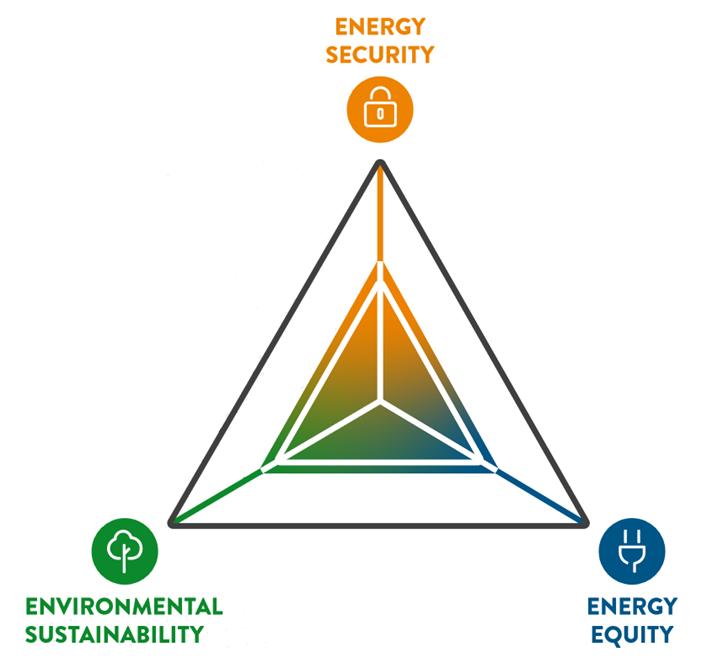
The World Energy Council (2022) defines these three core elements as a means to achieve “stable, affordable and environmentally sensitive energy systems”. WEC calls it a trilemma because it is a combination of socio-technical elements “entailing complex interwoven links between public and private actors, governments and regulators, economic and social factors, national resources, environmental
concerns, and individual behaviours” (WEC 2022). Sections 4-6 of this Outlook deviate slightly from WEC’s categorization as it focuses on energy security, energy pricing including descriptions of market price formations and energy end-users’ contract models, and energy sustainability, which combines both environmental and societal implications of energy system changes.

Climate change mitigation and the ongoing energy transition will bring significant structural changes to energy systems. Recent events, most notably Russia’s war of aggression in Ukraine, have caused further rapid changes and in many places an energy crisis, affecting energy systems in different ways in different regions depending on their structures. In Finland, these changes have been particularly visible in the form of periodic increases in electricity prices and uncertainties about energy availability.
The development of energy systems in line with societal objectives requires a wide range of decision-making in terms of investment, development and governance. However, the evolving new structures and technologies in the energy system easily make the situation complex and opaque. To enable decision-making in a constantly changing environment, good and reliable information on the state of the energy system and the various options is needed. LUT University supports the development of the energy system by providing information on the state of the energy system and its technologies, compiled by its energy experts.
The first report, published in 2022, focused on providing basic general information on the energy system and giving an overview of the basic factors related to its development and the different paths towards a carbon-neutral Finland. This second report, to be published in 2024, will focus in particular on the three key pillars of the energy system, as well as on the consequences of the energy crisis and its impact on the energy system. The three key pillars addressed in the report are: security of energy supply, electricity price formation and sustainability of energy systems. While the main energy technologies and their characteristics have already been described in the first energy review, recent developments in all key energy technologies and other factors have been included in this second energy outlook.
The security of Finland’s energy system is good thanks to its diversity, low emissions, technology and political stability. More recently, energy availability and self-sufficiency have improved, with investments in wind power increasing lowemission capacity and the commissioning of a new nuclear power plant at Olkiluoto.
Although the security of Finland’s electricity system is relatively good, it is important to make contingency plans. Especially during peak demand in winter, it is important to ensure that consumption and production are in balance and that the necessary amount of electricity can be supplied. Solutions must also be developed to maintain the stability of the electricity grid, considering the decline of conventional stability power plants and the rapid growth of wind power, which poses a challenge to stability. Energy turbulence is constantly changing the system, highlighting the need to develop a resilient energy system, its infrastructure, reserve markets and back-up stocks.
The global availability of the components and mineral raw materials needed for the energy transition, and the associated geopolitical risks, is one of the major concerns for energy security today. These challenges can be addressed by, among other things, recycling materials, developing more secure supply chains and using alternative technologies that reduce dependence on critical raw materials and individual countries.
Electricity market and electricity pricing Finland is an integral part of the wider European electricity market, which aims to meet the Lisbon Treaty’s objective of creating a single internal market. Europe has similar market models based on similar zonal pricing.
The energy crisis sparked a broad debate on the current functioning of European electricity market models, which are constantly being monitored and improved. However, existing

market models have long been developed to adapt to technological, political and social changes and will continue to evolve as our energy systems continue to develop. For example, the increasing share of renewable energy, the decentralisation of the generation structure and the growing need for demand response will require the adaptation of existing market models.
The main task of an open, competitive electricity market is to ensure that the market is efficient, that electricity is distributed efficiently and that prices reflect demand and the cost of electricity generation. Electricity prices are set in a number of different marketplaces with different purposes and actors.
Motivated by the energy crisis, the European Commission has put together the REPowerEU legislative package to make electricity markets more resilient and crisis-proof. After lengthy discussions, the Commission finally decided to keep the electricity market model almost unchanged, as the current marginal pricing has proven to work. However, the package reformed and promoted renewable energy production by improving price contracts and supporting energy consumers with more flexible contract models.
The main drivers of energy sector sustainability and CO2 emission reduction in Finland today are the transition from fossil fuels to lowcarbon energy production and electrification, biodiversity conservation, land use impacts, and other natural impacts related to changes in energy systems. The social sustainability and social impacts of energy systems have also become a key element of a just energy transition and are increasingly considered in energy system development.
The energy transition offers many economic and social benefits for Finland, as well as important handprint effects through technological
development, new business and high-quality education. However, the energy transition also brings new political, social, environmental and technological risks that need to be further explored. The growing role of citizens and energy communities across Europe is expected to lead to a more equitable distribution of income, more democratic decision-making in energy systems and increased energy flexibility and demand response solutions.
The most important energy sources in Finland are bioenergy, nuclear power and the rapidly increasing wind power. Bioenergy continues to play a key role in Finland’s energy system, thanks to the use of bioenergy and wood waste by the forest industry sector. Emerging bioenergy sources include liquid and gaseous biofuels for transport and, to a lesser extent, wood pellets, whose competitiveness is weakened by other cheaper biofuels. Nuclear power has traditionally been used in large units for baseload electricity generation, but can also be used more flexibly for electricity and heat generation. As an alternative to large nuclear plants, small modular reactors are being developed and are envisaged for future district heating in Finland.
A large number of wind power projects are under development in Finland, almost half of which would be located offshore. The height and size of wind turbines has been improved in the coming years, which will significantly increase their electricity production and reduce production costs. The growing share of wind power and the dependence of production on weather conditions will create challenges for electricity transmission and the electricity market, as the electricity system needs to balance production and consumption at all times. Moreover, wind power plants do not support the maintenance of grid frequency stability, so that, as the share increases, particular attention must also be paid to the dynamic control and stability of the electricity system. Wind power

in Finland is still concentrated in the Western part of the country. Wind power construction in Eastern Finland has been limited by the location of military bases, which has been the subject of a separate study in 2023, looking at possible ways to improve the situation.
The amount of solar energy has multiplied in recent years, but its share is still relatively small, around 1% of Finland’s electricity production. However, it is estimated that by 2030 it could be as much as 7 gigawatts (7 000 MW), up from around 635 MW in 2022. Although Finland does not yet have much solar power generation capacity, several large projects are planned. Nevertheless, Europe’s significant solar power generation has sometimes been reflected through the electricity market also in Finland in the form of favourable, even negative, afternoon hours. Technological developments in solar panels have taken significant steps forward, with increased efficiency and significantly reduced weight-to-power ratios.
The role of heat pumps has been identified as important in reducing the use of fossil energy sources and achieving future emission reductions related to heat production. In Finland, 40% of buildings are equipped with heat pumps, most of which are air-source heat pumps, air-to-water heat pumps and ground-source heat pumps. In addition to the growth in the use of heat pumps in buildings, the potential of heat pumps in large industrial scale installations has been identified. Heat pump technology development and research focuses on improving heat pump performance and components, and on achieving ever higher temperature levels. In addition, the refrigerants used in heat pumps are increasingly moving towards the use of natural refrigerants.
Other energy technologies, energy saving and energy communities
The role of low-emission hydrogen is expected to grow significantly in the future energy system.
In the energy system, hydrogen, on its own or mixed with natural gas or biogas, can replace fossil fuels for heat or power generation. Other uses of hydrogen include various power-to-x products such as chemicals, plastics and adhesives, which are currently made from fossil oil or gas. Globally, there is strong political momentum for low-carbon hydrogen production, but its growth has not taken off in the way required by the 1.5°C energy transition scenarios due to, among other things, its production costs and the lack of insufficient policy support and incentives. With its lowcarbon electricity generation structure and biobased carbon dioxide, Finland is well placed to become a major producer of competitive, electrically produced hydrogen and its refined products in Europe.
The report also briefly describes other elements related to the development of the energy system. As regards the capture, management and utilisation of carbon dioxide emissions, several initial projects have been launched in Finland, but their implementation is still unclear. In energy storage, lithium-ion batteries have been the fastest growing electricity storage technology, especially for the electrification of transport. Competitive solutions for seasonal energy storage have been difficult to find, with only a few recharging cycles per year, making economic viability a challenge in the current energy market. In terms of energy savings and energy efficiency, Finland’s achievements have often outperformed many other countries, which the EU Energy Efficiency Directive does not take into account and requires the same relative improvement in energy efficiency regardless of the starting point. Energy communities, such as housing associations, have become part of the evolution of the energy system by investing in their own decentralised energy production, energy efficiency, storage, consumption flexibility or other forms of smart energy solutions.
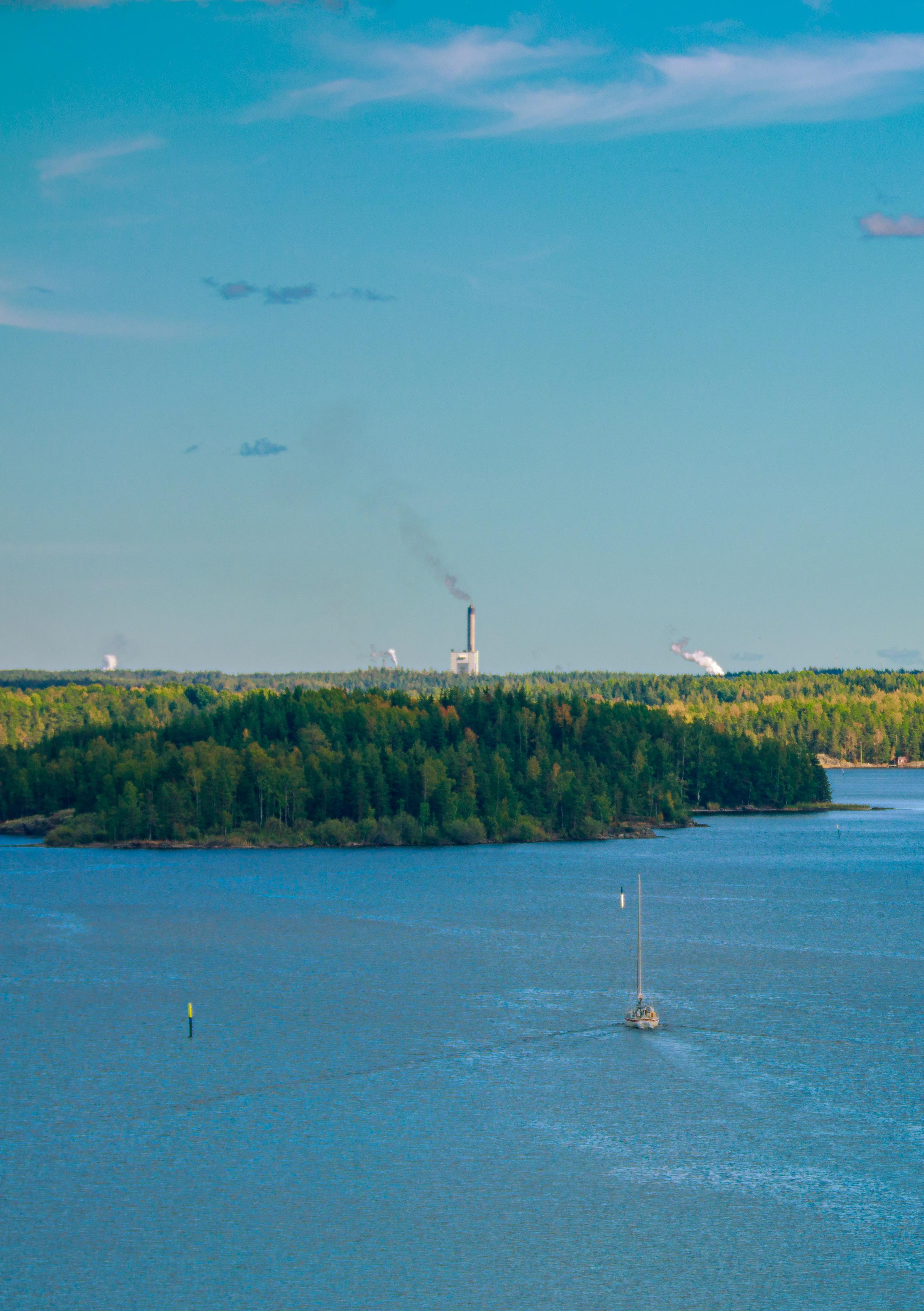
2.1.1. The background for energy transition
The main driver for energy transition is the reduction of greenhouse gas emissions to limit the global warming primarily caused by burning of fossil fuels that form almost 80% of global energy production (IEA 2023a). At the United Nations Climate Change Conference – commonly known as Conference of Parties (COP) – gathered in Paris in 2015 and agreed to pursue efforts to limit the global temperature increase to 1.5 degrees Celsius. In the following conferences, COP 22 – COP 28, progress has been reviewed and necessary decisions made to promote the effective implementation of the Convention. EU has adopted a set of policies to meet its international commitments under the Paris Agreement and for reducing net greenhouse gas emissions by at least 55% by 2030.
Finland’s National Climate and Energy Strategy is consistent with the EU targets and lists measures to reach the EU’s climate commitments for 2030 and offers an implementation strategy regarding how to reach the targets. In the strategy, also called as Carbon Neutral Finland by 2035, Finland commits to reducing greenhouse gas emissions by 60% by 2030 and 80% by 2040, as set out in the Climate Change Act, and achieving carbon neutrality by 2035 (Ministry of Economic Affairs and Employment of Finland 2022). In addition of covering emissions from the emissions trading, effort sharing and land use sectors, it aims to cover the carbon sinks of land use and other sectors. In the estimations of how Finland is reaching the emissions reduction targets, it is estimated to achieve higher levels of renewable energy shares but exceed the maximum energy consumption limits set for example in the EU’s Fit for 55 package (Ministry of Economic Affairs and Employment of Finland 2022).
In order to reach these targets, the strategy highlights areas such as promoting noncombustion-based heating, electrification of the energy system, and use of system integration in sectors where decarbonisation is challenging. The strategy furthermore incorporates national hydrogen strategy to increase different electrofuels and quantitative targets for hydrogen electrolysis capacity.
Energy transition is a wider ongoing societal change that reaches beyond technological changes. It is a long-term socio-technical change that involves several sectors and different societal actors, including policymakers and officials, regulators, industry and societal associations, companies, municipalities, and citizens. Therefore, in addition of decreasing CO2 and other greenhouse gas emissions to mitigate climate change, energy transition aims to reduce the other environmental impacts of energy production and consumption, enhance more socially and economically just energy systems, and improve energy security.
Energy transition is also closely linked to many other challenges of our time. Besides climate change and the war in Ukraine and its implication on energy security, there is also an urgent need to halt the accelerating loss of biodiversity. In the global risk ranking on the 10-year trajectory, risks related to changes to Earth systems, biodiversity loss and collapse of ecosystems as well as natural resources shortage are among the top four risks right after extreme weather events (WEF 2024). For these reasons, it is important to find synergies and trade-offs between climate change mitigation and protection and restoration of biodiversity that can include actions to protect and restore ecosystems, such as wetlands, that also contribute to climate change mitigation (Pörtner et al. 2021).

Climate policies are not the only legislative measures that guide sustainable energy transition, but it is also guided by a variety of different policies and regulations such as safety regulations, biodiversity targets, nature conservation and restoration act, and technology-specific regulations. For example, The Medium-term Climate Change Policy Plan (KAISU) defines policy measures for the so-called effort sharing sectors that are not part of the emissions trading scheme. Climate Change Plan for the Land Use Sector (MISU) on the other hand covers agriculture, forestry and other land use with the aim of enhancing overall sustainability and curbing greenhouse gas emissions resulting from activities in these sectors.
In this Energy Outlook 2024, we intend to go beyond technical systems descriptions and approach energy transition comprehensively. However, as our expertise in LUT School of Energy systems is on the development of energy technologies, we will also give an extensive overview of the most recent developments of energy technologies.
In the quest to mitigate climate change through energy technology, a comprehensive strategy encompasses a range of measures aimed at revolutionizing energy production, consumption, and management. This topic has been addressed extensively in the first LUT Energy Outlook published in 2022 (LUT 2022a). In this section, we shortly present the main contemporary technological means to tackle climate change.
Increasing end-use energy efficiency involves deploying technologies and practices to minimize energy waste across various sectors, including buildings, transportation, and industry. By optimizing energy usage, we can substantially curb greenhouse gas emissions while simultaneously reducing energy costs and enhancing energy security.
Concurrently, significant increases in the use of low-carbon energy sources are imperative. Transitioning away from fossil fuels towards renewables such as solar, wind, hydro, and
geothermal power or low-emission nuclear energy is critical. These sources offer more sustainably produced energy with minimal greenhouse gas emissions, laying the groundwork for a cleaner and more resilient energy system.
To further accelerate the transition, there’s a pressing need to significantly reduce the use of fossil fuels. This involves phasing out coal, oil, and natural gas in favor of cleaner alternatives, thereby slashing emissions from electricity generation, transportation, and industrial processes.
The hydrogen solutions represent yet another frontier in the energy transition. By harnessing hydrogen, but also power-to-x (P2X) solutions as clean energy carriers, we can improve decarbonization in industry, transportation, and heating, while leveraging renewable energy sources for hydrogen and P2X production.
Electrification emerges as a key strategy, particularly in transportation and industry. By shifting towards electric vehicles and electrifying industrial processes, we can drastically reduce reliance on fossil fuels and unlock synergies with renewable energy sources.
Moreover, the development and deployment of new and transformative technologies in demand sectors hold extensive potential. Innovations in energy storage, smart grids, and advanced materials carry the promise of revolutionizing energy systems, driving efficiency gains and emissions reductions.
Technical carbon sinks, including carbon capture and sequestration (CCS), play a crucial role in mitigating emissions from hard-to-abate sectors of heavy industry and, for example, in cement production. Additionally, carbon dioxide removal (CDR) technologies and natural carbon sinks, forests and wetlands offer pathways to achieve net-negative emissions, helping to offset remaining emissions and stabilize the climate.
In summary, tackling climate change through energy technology requires a multifaceted approach that combines efficiency improvements, renewable energy deployment, fossil fuel phaseout, electrification, innovation, carbon capture,
and utilization of alternative fuels like hydrogen. By embracing these strategies collectively, we can chart a course towards a more sustainable, low-carbon future.
2.1.3. Global drivers for energy transition
Global energy transition takes place faster than before and in more challenging economic and geographical contexts. The recent energy crisis stirred already existing tensions in the global energy markets, as the volatility of the global energy supply increased. The opportunities in the clean energy economy and industry are growing fast, but the crisis fortified already existing uncertainties, such as resilience of energy supply chains, energy security risks and affordability challenges. Furthermore, consequences of climate change are more visible hitting especially hard on already vulnerable communities.
According to the World Energy Outlook scenario (IEA 2023d), each of the three fossil fuel categories (natural gas, coal, oil) are expected to reach their peak by 2030 highlighting how the energy system is changing as low-emissions electricity and fuels meet an increasing share of the world’s rising energy needs. However, if demand for fossil fuels remains as high as it was for e.g. coal in recent years, it is far from levels required to reach climate targets. However, there are signs of change in the right direction. Worldwide, the addition rates of coal and natural gas power plants have halved and the sales of heat pumps in Europe and USA have outnumbered the sales of residential gas boilers.
According to IEA’s (2023e) Net Zero Roadmap, electricity demand is expected to rise in all sectors. The main drivers of this growth are emerging markets, developing economies, population and income growth, electrification of increasing numbers of new end-users, and electrification of different processes. This additional electricity demand is expected to be met by low emission sources of electricity such as renewables, nuclear power, fossil fuels equipped with carbon capture, hydrogen and ammonia. Recent policy targets have boosted
the prospects for renewable energy in major markets across the globe, including China, the European Union, India, Japan, and the United States. Positive global developments include wind and solar PV installations, batteries and electric vehicle sales are aligned with the targets, but these technologies alone are not sufficient to deliver net zero emissions, but global carbon emissions need to be drastically cut down.
The World Energy Transition Outlook (IRENA 2023b) reminds that the reduction of carbon dioxide emissions is off-track. To limit global warming to 1.5 C0, carbon dioxide emissions need to be reduced by 37 gigatonnes from 2022 levels to achieve net-zero emissions in the energy sector by 2050. This means that around 1000GW of renewable energy power generation deployment is needed annually. However, concerns persist due to high supply chain concentration, posing vulnerability to policy choices, company decisions, and natural disasters. Clean energy technology supply chains, particularly for wind, solar PV, batteries, critical minerals and electrolysers, are more geographically concentrated than fossil fuel ones, with China playing a prominent role. The top three regions control 80-90% of global capacity, with a single producer often contributing up to 80% (IEA 2023c).
Societal challenges in energy sector include the lack of access and affordability of energy, and the employment impacts of that on the one hand create new jobs, but on the other hand reduce employment in fossil energy sectors. The number of people without access to electricity (760 million) and for example clean cooking i.e. non-polluting modern energy sources (2.3 billion) are expected to fall by around 15% to 2030, according to IEA estimates. Especially crucial is assistance for those currently lacking access to modern energy services (IEA 2023b). Additional risks emerge from the stronger stronger weather patterns caused by climate change and their impacts on vulnerable communities. More just energy transitions also hinge on prioritizing people in conversations regarding the future of energy. Achieving these transitions requires ongoing support and active involvement also from citizens.
2.2.1.
The Russian invasion of Ukraine in February 2022, when economies were still recovering the Covid-19 pandemic and the energy prices were already elevated, strongly affected the global energy market dynamics, which then led to a global energy crisis. Energy crisis by definition include a shortage of energy supply that leads to increased energy prices and wider social and economic problems (Grossman 2015). The latest energy crisis was a result of a combination of different factors, including supply chain disruptions, extreme weather events, delayed maintenance from the pandemic era, reduced investment in oil and gas, and already existing geopolitical tensions. The Russian manipulation of gas supply to Europe already prior to the invasion led to gas prices reaching record high levels, contributing to already high global inflation and raising issues of affordability of energy.
The invasion and the resulting economic sanctions placed upon Russian oil and coal imports hit particularly strongly to European energy markets due to high dependence on Russian fuel imports, which revealed European energy security vulnerabilities. This led to changes in global energy trade routes and further increased energy prices. The immediate efforts to mitigate the crisis included increasing imports from alternative gas suppliers and investments to LNG infrastructure, increasing the use of traditional energy sources especially coal, extending nuclear plant operation licenses and delaying phase out of nuclear power in some countries, introducing energy savings measures through government campaigns, and the largest ever release of emergency oil stocks by the IEA.
The energy crisis has created a need to reevaluate energy policies and the role of natural gas as a transitional fuel, highlighting the energy security and geopolitical issues of energy supply chains, creating a need for diverse energy mix and investment in renewable energy, efficiency and electrification. To phase out Russian fossil fuel imports in Europe, and to promote renewable energy investments and energy efficiency, EU launched the RePowerEU plan in May 2022 (EC 2022).
In Nordic countries the energy crisis was mainly seen in high energy prices for end users and a reduction in natural gas supply from Russia. An increase in cost has been felt across the Nordics, resulting in socio-economic impacts, such as energy poverty in lower income groups. The Nordic Energy Research (NER 2023) report lists eight drivers of the energy crises; electricity market structure, inflexibility of demand and household finance, decommissioned controllable electricity capacity, balancing supply and demand, lack of transmission infrastructure, natural gas supply reductions, energy import dependency and weather dependent electricity generation. Policy recommendations proposed in NER report (2023) for Nordic countries are to diversify the energy sources, formulate shared plans, sharing knowledge to address the public opposition to energy projects, strengthen the grid infrastructure and collaboration across energy markets, and limit dependency on imported minerals and metals.
Global events including the Covid-19 pandemic, which impacted energy supply chains, raw materials supply for energy technologies, energy market dynamics, and geopolitical tensions increased by the Russian invasion of Ukraine, which stopped Euro-Russian energy trade, have significantly impacted global and European energy supply chains and energy policy. These events have caused a series of reactions and shifts in Finland’s energy system to ensure affordability and security of energy supply.
The energy crisis in Finland has highlighted issues of energy security and necessitated a reduction of reliance on energy imports from Russia. Prior to the Russian war in Ukraine, Finland’s energy sector relied heavily on imported fossil fuels from Russia since Finland does not have a domestic fossil fuel or uranium supply. In 2021, Finland imported 81% of crude oil, 75% of natural gas, and over 50% of coal from Russia (IEA 2023f). In addition, energy imports from Russia included 50% of electricity imports, wood products, and nuclear fuel. As a response to the geopolitical tensions and Finland’s support for Ukraine, Russia
stopped all imports of wood chips to Finland in March 2022, and an import of electricity and natural gas in May of 2022. Despite considerations to ban the export of nuclear fuel to Finland, nuclear fuel imports from Russia for the two VVER type nuclear reactors in Loviisa nuclear plant continued. However, the Russian invasion led to the cancellation of the Hanhikivi 1 nuclear plant project, which was to be based on Russian technology and included participation from the Russian stateowned nuclear company Rosatom.
European Union set sanctions banning all imports of Russian coal from August 2022, marine imports of Russian crude oil starting December 2022, and Russian petroleum product imports from February 2023. In May 2022, the National Emergency Supply Agency declared an “early warning” in the Finnish gas market due to the loss of natural gas supply, when the natural gas supply via pipeline from Russia ceased. As a response, Finland reduced its natural gas demand, preventing the need to implement emergency measures.
These sudden changes in energy supply chains caused increases in energy prices and concerns about the security of energy supply in Finland,
requiring Finland to seek alternative sources for energy supply, including energy imports from other countries, and to take action in improving the country’s energy security. One of these actions was the ten-year lease of a floating storage and regasification unit to meet Finland’s and Estonia’s natural gas demand, which began commercial operations in December 2022. As a result of the energy crisis, Finland and the EU took steps to end reliance on Russian energy through the REPowerEU plan, which includes significant grant funding and aims to support the energy transition while ending dependence on Russian energy imports. These measures are part of Finland’s broader strategy to improve energy security and sustainability, aligning with its goals of carbon neutrality and reduced dependence on energy imports, particularly from Russia.
The energy crisis significantly increased global energy prices. The increase in energy prices in Finland and concerns about sufficiency of the available energy supply to meet the demand during the highest demand months in winter of 2022–2023 demanded solutions to ensure affordability of electricity and security of energy supply. As a response Finland launched a demand-side management response to

reduce energy demand during the winter. This involved Finland launching the “Down a Degree” consumer awareness campaign that was supported by the government with an estimated annual budget of EUR 1 million and resulted in significant electricity savings from August to December 2022.
Price volatility in Finnish electricity market has created a new landscape. As the wind power capacity increased over 50% of typical daily power levels, the days when we see close to zero electricity prices increased to more than twenty days a year. In 5.1.2024 electricity market prices reached over 2 €/kWh and led to large customer criticism of the electricity market. The high price was mainly a result of lack of peak power in the market due to retirement of old non-VRE fossil generation capacity and the electricity market system that at the moment do not encourage building new peak capacity.
Energy crisis also motivated Finland to push for the rapidly evolving hydrogen solutions that are seen as one of the major vehicles to increase energy independence, reduce CO2 emissions of various industries, most notably
steel and chemical industry, and transport sector (Sivill et al. 2022). Furthermore, hydrogen is expected to increase flexibility of the energy systems due to its potential to storage energy. The hydrogen scenarios are based on the high potential of having significantly more wind power in Finland. This would open opportunities for advancing low-carbon industries, new jobs and developing of new kind of highly refined energy products such as e-fuels in Finland that could be exported. However, there are many uncertainties and challenges in hydrogen that are related to transportation, storage, costs and unclarity how to politically support the development of green hydrogen solutions.
Moreover, green hydrogen requires a significant increase in renewable energy production with wind and solar technologies which also means increased land and sea use pressure posed by construction of on- and offshore wind and solar power plants. Siting the power plants carefully is the key in overcoming potential conflicts with nature values and local communities. Potential conflicts between different kinds of sustainability impacts are also recognized as one of the major bottlenecks of energy transition in Finland by VTT (2023a).
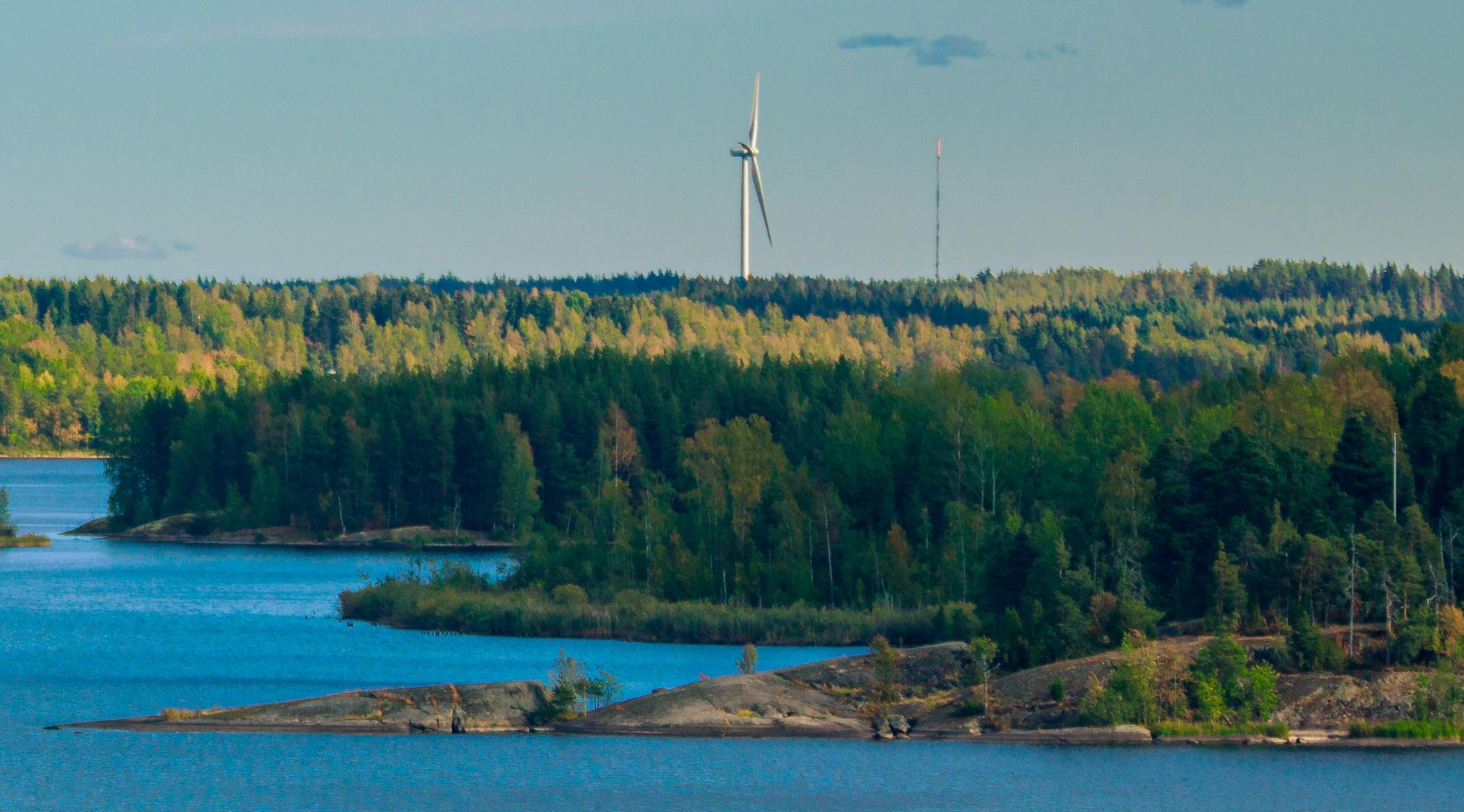

Energy security is a universal topic that shapes policies and regulation, serving as a cornerstone for fostering economic well-being and societal stability and impacting individuals globally. As a concept, energy security traces its roots back to the primitive necessity of ensuring a reliable source of fire for heating, cooking and other essential needs. The scientific field of energy security developed in 1970, when the oil crises tightened the world economy and required more focus on supply security. In the 1980s, it was refined to comprise international stability, expanding to social welfare (energy poverty) in the 1990s in the case of excessively high or fluctuating energy prices. In the 2000s, further aspects such as being free of risk and disruptions, the role of infrastructure and particularly sustainability received further consideration. In the 2010s, the view on energy security was consolidated by listing the full scope of aspects and highlighting those that are most important. Recently, the energy crisis has had a substantial impact on both the price and availability of energy in global and national markets, significantly elevating the level of concern regarding energy security.
The interpretation of the energy security concept lacks a singular standardisation, manifesting itself in diverse forms within contemporary discussions. In its most comprehensive form, it encompasses all dimensions associated with energy supply, fulfilling societal expectations while remaining impervious to threats. In a more focused context, energy security is defined as the ability to meet current and future energy demand reliably and to withstand and recover from system shocks through effective crisis management as articulated, for example, by Nordic Energy Research (NER 2023) and the World Energy Council (WEC 2022). When analysing the effects of the energy crisis, they have separated three interconnected elements: security, affordability, and sustainability. Those three elements are also the main pillars in the national energy strategy of Finland. The International Energy Agency incorporates the pricing aspect into its definition of energy security, characterising it as
‘the uninterrupted availability of energy sources at an affordable price’ (IEA 2023a). Regardless of the nuanced definitions applied, the concept of energy security is intricately intertwined with all facets related to energy.
In this report, we dedicate separate sections to energy pricing and energy sustainability. Therefore, our emphasis in this section focuses primarily on a relatively narrow perspective of technical energy security. However, a more comprehensive view is imperative in section 4.1 when addressing the threats to energy security. Our discussion predominantly revolves around Finnish energy security, with consideration to national needs, options, and solutions. The exception to this is section 4.3, where the discourse shifts to raw materials and value chains, tightly interconnected with global resources.
Energy security is vital for a stable and prosperous society. In its extensive interpretation, the concept encompasses key factors that impact the reliability and sustainability of our energy supply. The key dimensions can be broken down as follows:
» Availability: Ensuring a consistent and reliable energy supply.
» Cost: Managing the affordability of energy for consumers.
» Environmental impact: Minimising negative effects on the environment.
» Diversity: Promoting a variety of energy sources to reduce vulnerability.
» Technology and energy efficiency: Adopting efficient and advanced technologies.
» Energy policies: Implementing effective and sustainable energy policies.
Beyond these pillars, additional dimensions that can play a very relevant role are:
» Location: Geographic factors influencing energy accessibility.
» Timeframe: Considering both short-term and long-term energy needs.
» Resilience: Building resistance against disruptions or crises.
» Health, culture, literacy, employment: Recognising social and economic impacts.
» Military and cyber security: Addressing potential threats in these domains.
Challenges within any dimension of energy security can pose significant threats, with historical instances highlighting the vulnerability inherent in maintaining energy security. For instance, events such as the Russian invasion of Ukraine, which disrupted gas supplies in Europe, underscore the fragility of the availability dimension. Moreover, crises such as oil price fluctuations and environmental impacts –including climate change and ecosystem collapse – emphasise the multifaceted nature of the challenges. Technologies, efficiencies, and energy policies also play crucial roles in shaping energy security.
A study (Azzuni & Breyer 2020) revealed that Finland has one of the very best levels of energy security in the world, if all the dimensions are equally weighted as shown in Figure 2. The detailed view of Finland reveals the strengths and challenges in the country. The availability dimension is ranked in absolute numbers globally, which leads to low relative numbers for Finland while the specific values per population are better. The enhancement of low-emission power generation capacity, notably through substantial investments in wind power and the commissioning of the new Olkiluoto nuclear power plant in 2023, has had a positive impact on availability. However, challenges such as the intermittency of wind power during calm weather conditions and the risk of sudden power disruptions at large nuclear plants persist in relation to balancing the energy supply and demand, especially during cold winter periods. Addressing these challenges necessitates the development and enhancement of Finland’s energy infrastructure, reserves and other means to maintain the balance between energy supply and demand. Fluctuations in power production can lead to significant price volatility, causing challenges and insecurity for
energy consumers and reinforcing the need for strategies to mitigate such variations.
The availability of certain energy sources may be constrained by difficulties in accessing international energy raw materials, particularly amid geopolitical tensions. While wind, solar, bioenergy, and hydropower offer relatively independent sources, Finland’s reliance on imported conventional energy introduces vulnerabilities, especially if reserve supplies of the relevant raw material dwindle during prolonged crises. Efforts to reduce energy import dependency, particularly on Russian imports, have mitigated the impact of geopolitical tensions on Finland’s energy system.
Finland maintains a significant but diminishing reliance on fossil fuels, all of which are imported due to the absence of domestic production. Nuclear energy, which is one of the key components of Finland’s energy mix, currently relies on imported uranium, although the mainly state-owned mining company Terrafame is taking steps to establish domestic natural uranium production of 150-200 tonnes as a side stream of its main products (nickel, cobalt, zinc, copper for battery and other industries). The natural uranium quantity processed for reactor fuel would be sufficient to cover more than a full reload batch for Olkiluoto 1 or 2.
In the energy transition towards an emissionfree system, the gradual phasing out of fossil fuels will result in the decommissioning of controllable electric capacity traditionally used to balance energy supply and demand (NER 2023). With regard to this reduced dispatching capacity and increasingly weather-dependent power supply, many means and options for managing the balance are presented and discussed further in section 4.5. Additionally, the reduction of synchronous generation of electricity by fossil fuel power plants creates challenges for system stability as they are replaced by wind and solar power connected to the grid using power electronic converters. Nordic transmission system operators believe that if these challenges are not addressed in a timely and sufficient manner, the risk of serious and even critical system incidents will increase considerably (NGDP 2023). There are experiences of grids with instantaneous high shares of inverter-
based variable wind and solar power supply operating without reporting stability challenges. However, these experiences are not directly applicable to the Nordic grid. The challenges that inverter-based generation creates for power system stability are often overlooked, and contemporary research and development efforts focus on technical and market solutions that will enable high shares of variable inverter-based renewable energy sources (Hodge et al. 2020).
The diversity of Finland’s energy system –comprising various low-carbon sources such as wind, solar, nuclear, hydropower, and bioenergy – enhances resilience and stability. Each energy source contributes unique characteristics, creating a robust and complimentary combination. Wind energy has emerged as an economically and environmentally favourable
investment, while nuclear power provides stability during varying weather conditions and can contribute to load balancing during electricity overproduction. Bioenergy can provide balance in a planned dispatch, while increasing solar power is mainly intermittent but has a different temporal supply profile than wind power.
The concept of energy security is very important for the economic stability and welfare of people. As the Finnish electricity system undergoes a transition toward low-emission energy, diverse development paths become necessary in order to address challenges such as intermittent power supply and failures in supply or infrastructure. Overall, Finland’s energy system stands out in international comparisons due to its high proportion of low-emission energy, diversity, technology, resilience, and policy frameworks.

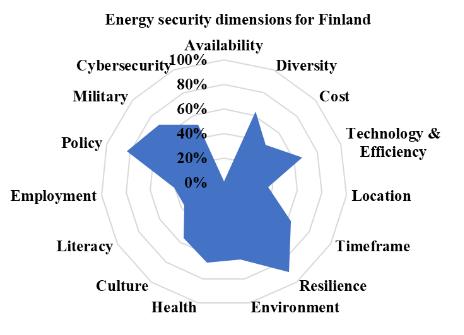
The security of the Finnish energy system was severely tested during autumn 2022 and spring 2023 when economic tremors from the Ukrainian situation hit Finland, and on a smaller scale in early 2024. On 20 May 2022, Gazprom Export informed natural gas distributor Gasum Oy that natural gas deliveries to Finland would be cut off at 7:00 am on 21 May 2022. Finland had already completed construction of the
Baltic connector, which meant natural gas supplies could be continued from Estonia, and the government quicky contracted for an LNG terminal ship that started operating at the beginning of 2023. Unfortunately, the Baltic connector was damaged in October 2023 and the repair work lasted until April 2024. The situation with natural gas throughout Europe was dire in autumn 2023.
With the exception of Hungary, the EU has also stopped buying fuels such as raw oil
from Russia. Therefore, Finland has had to renegotiate its oil trade, but it has been remarkably successful in that process. This has also meant that trade in Russian coal has stopped. That was not a very significant event for Finland, as coal use had already been declining for quite some time and the change in Russian trade mostly affected the Helsinki region. Finland has decreed an end to coal use for electricity by mid-2029.
Since the oil crisis, domestic peat has been one of the major national remedies to security of supply. Use of peat is slowly decreasing due to the pricing of European Union Emissions Trading System (ETS) and a carbon tax, which made burning peat unprofitable. Despite public demand, peat production is slowly coming to an end – mainly due to reluctance on the part of power plants to use it.
An emergency stockpile for peat has been established, but no progress was made during summer 2023. The increasing reliance on domestic biomass stock for energy purposes may also affect the carbon stock within forest and land biomass, potentially influencing Finland’s climate targets and compliance with EU-level LULUCF (the regulation on land, land use change and forestry) and burden-sharing sector obligations (Soimakallio & Pihlainen 2023).
The closing of biomass trade from Russia resulted in a gap of about 15% in available biomass in Finland, causing increases in energy biomass prices as well as shortages of biomass. Despite fears, use of woody biomass in Finland declined in 2023, relieving fears that higher biomass usage would hurt Finnish LULUCF.
Major positive development has slowly emerged with the construction of approximately 6,000 MW of wind capacity and about 1,000 MW of solar power. Variable energy provided by wind increased the availability of renewable resources in addition to the existing hydro and bioenergy supply.
Another positive development occurred when the long-awaited Olkiluoto 3 (OL3) 1,600 MW nuclear power plant started operations,
running in test mode for about one year prior to regular operation starting on 16 April 2023. Finland has a nuclear fuel stock sufficient for approximately three years of operation stored at Finnish nuclear power plant sites, but the situation in Ukraine means that new sources of fuel need to be negotiated for the Loviisa nuclear power plants, as purchasing nuclear fuel from Russia is now impossible.
There are concerns that the Finnish electricity system will be unable supply the entire electricity required during peak winter demand. This is due to a continuing decline in CHP electricity production. For example, the old coal-fired CHP plants in the Helsinki area are being replaced by heat only and heat pump plants. However, a major blackout in the next few years is not very probable even if several electricity links to neighbouring countries fail. In any case, the system’s resiliency is reduced during periods of high demand and there is a need to recover from sudden failures in the system. Therefore, this is one of the concerns presented by the current government and one that will be addressed during the coming years.
The raw materials dealt with in this section have been limited to those that are most critical for new energy system components, which has been an active topic in recent discussions on the global energy transition. The energy transition involves moving from a system based on extraction of fossil fuels to one based on the minerals and materials required to manufacture and build the energy system components used to harvest energy flows in the environment (for example, energy in the flow of water, flow of wind and solar radiation), convert the generated electricity into the required final energy form, and store energy. However, the actual operation of new, green energy system components does not require much additional inflow of energy or materials.
The largest volumes of materials needed for new energy system components are required for wind power, solar photovoltaics, stationary
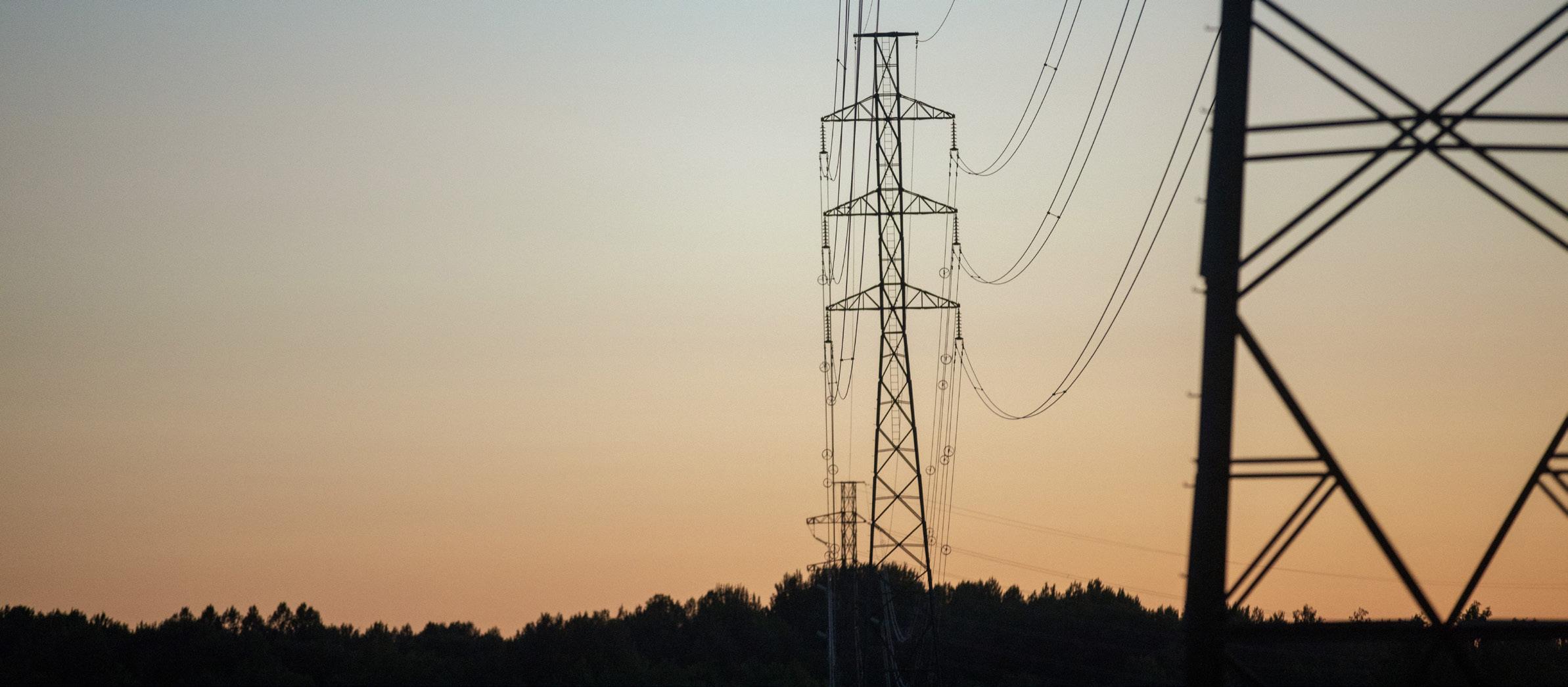
battery storage, batteries for electric vehicles, heat pumps, and electrolysers, among others. The use of all these technologies is expected to grow enormously in the years and decades to come, typically by a factor of 10 to 100. The material supply challenges have several main dimensions: supply of raw materials, security of supply, and supply chain stability.
The supply of raw materials for fast-growing energy technologies may be limited with regard to several key materials used for wind power (neodymium, dysprosium), solar PV (silver), batteries (lithium, cobalt, nickel), and electrolysers (iridium, nickel). Fundamental challenges have been removed in the recent past for practically all cases. Wind turbines can be also designed as directly driven and with separately excited annular generators that use copper or aluminium as a substitute for the limited neodymium and dysprosium. This technology was introduced many years ago and is offered by different wind turbine manufacturers. Solar cells typically use silver to extract charge carriers, but the same process can be accomplished with copper and aluminium. The latter materials can be considered an alternative technology that is available and can be introduced as soon as the price of silver exceeds a particular price level. Lithium batteries without cobalt and nickel have been available for more than 10 years, and their market shares are also growing for electric vehicles. The supply of lithium itself may be sufficient, but the expansion of mining may be limited in comparison to the increase in demand. However, the sodium-ion batteries
currently being introduced are entirely made from abundant materials. Electrolysers that require iridium will be limited for the volumes projected in the decades to come, but alkaline electrolysers are based on a nickel catalyst that can be fully reprocessed after the end of the product lifetime, thus preventing loss of the material. In summary, there are no known fundamental showstoppers for the required roll-out of sustainable energy technologies, and a circular economy with the most complete recycling possible is mandatory to enable the huge capacity required for these technologies in the long term.
The stability of value chains for the supply of the required technologies may be more challenging than availability of the fundamental material. Since the turn of the century, the focus of industrial policy positioned China at the core position of central value chains, particularly for battery manufacturing and solar PV manufacturing. This led to major dependencies of other major economic rims, also in Europe. The lack of adequate industrial policy in Europe led to substantial vulnerability in terms of supply chain stability and access to the respective manufacturing capacities in Europe. This structural deficit requires a political readjustment of strategic industry policies in Europe and industries in Europe to develop the respective supply chains inside Europe. Together with its European partners, Finland has to ensure that the appropriate measures are executed –the faster the better. There are no relevant cost differences, simply a lack of industrial scaling and strategic market structuring.
Finland is also on the brink of having its own battery production facilities, as several companies are proceeding with industrial plants. Battery manufacturing is well suited to Finland due to local raw materials and a low electricity price. The attractive opportunities for Finland in terms of ramping up industrial capacities for battery materials include the precursor cathodic active material (BASF in Harjavalla), cathode active material (CAM in Kotka) and anode material (Ningbo Shanshan in Vaasa). Additional projects are linked to nickel and lithium.
Along with the challenges in raw material availability and upcoming substitution requirements and the need for rebalanced and more resilient supply chains, a considerable expansion of circular economy approaches is necessary to ensure that once-used materials are continuously available for society. Without a comprehensive circular economy, a civilization with a projected population of ten billion people in mid-century cannot be permanently supplied with energy at the highest supply levels. A comprehensive circular economy would ensure there are no fundamental barriers to a continued supply of energy based on sustainable resources.
Critical energy infrastructure encompasses numerous components, including electricity transmission and distribution networks, the natural gas grid, power and heat generation plants, district heat grid, as well as the transmission, storage, and distribution of fuels in various forms. Traditionally, the distribution of refined liquid or solid fuels relies either on conventional road transport or the rail network within Finland. Additionally, the majority of Finland’s imports and exports rely on harbour infrastructure, including energyrelated materials like crude oil. Therefore, shipping plays a pivotal role in ensuring the country’s energy security and overall economic activity. There are numerous existing plans and initiatives for increasing the energy security of Finland in the coming years.

The report on national climate and energy strategy published by the Ministry of Economic Affairs and Employment of Finland (2022) sees energy security as a critical policy concern. In addition to storage for critical fuels and ensuring a functioning electricity system, preparedness efforts extend to areas such as ‘heat supply, system integration and new fuels’. The renewed preparedness structure would include a fuel pool, gas pool, electricity pool and heating pool. In addition, there are policy objectives relating to the maintenance of diverse energy supply channels, ensuring hydropower’s adjustability and operation, enhancing cyber security within the energy sector and placing greater emphasis on securing the electricity system due to increased electrification of transport. The long timeframe of the strategy means that references to emerging and developing technologies may be found, particularly relating to Power-to-X technologies. For instance, the strategy states that Power-to-X has the potential to increase the security of supply in food production directly and through fertiliser production. Small modular reactors are also discussed as a possible alternative to electricity and heat production. The penetration level of both Power-to-X and small modular reactors will depend, among other things, on their techno-economic development and effect on the required infrastructure.
As natural gas deliveries from Russia have stopped, the development of liquefied natural gas (LNG) infrastructure will be relevant. Cooperation with Baltic countries is likely to develop further in the context of floating LNG storages. The EU and the Finnish Government
need to clarify their policies towards biogas and renewable fuels of non-biological origin (RFNBO) to secure the necessary economic transformation to carbon neutrality.
The National Emergency Supply Agency (2023) has a renewed strategy programme entitled ‘Energy 2030’, which aims to tackle the diverse issues related to energy security. In particular, the ongoing energy transition from fossil to sustainable systems challenges the traditional preparedness measures that have been in place so far. For example, power fluctuations in the grid will be more radical in the future as more wind and solar capacity are introduced to the grid, emphasising the importance of flexibility and power balancing units and services. There will also be changes in the type and volume of different fuels. In practice, development of the strategy is carried out in smaller thematic projects that focus on areas such as oil logistics and heat supply, increased demand on forest chips, prioritisation of electricity customers in fault situations, and the collaboration of officials during large blackouts.
The distributed generation of wind and power may challenge the transport infrastructure at a more significant level than today. Land area is vital for renewable power, and a large portion of that land could be located in areas where the current power infrastructure is not as developed. For example, north-south connections for the grid are important. Grid limitations may partially restrict or hinder the development of wind power. Even more broadly, the energy volumes could be such that it may be necessary to question what the mode of transport is. For instance, hydrogen could be transported by pipeline. CO2 pipelines have also been used for decades and could prove useful for Power-to-X.
Ongoing work with the Aurora Line connecting Finland to Northern Sweden’s electricity area SE4, which will be commissioned in 2025, will further strengthen our security of electricity supply, as SE4 is rich in hydropower. A planned additional connection to Estonia has not progressed, as this is not considered to increase Finnish electricity availability. A planned marine electricity connection to Germany has not moved forward due to a dramatic increase in the prices of marine electricity lines.
The Energy Authority is responsible for monitoring the balance between power production and consumption. It releases an annual report that addresses aspects related to the sufficiency of energy production in Finland and the status of the electricity market. It also decrees planning of emergency capacity, which cannot participate in the electricity market. There are two time horizons in coordination of production. In daily production planning, 24-hour responsibilities for production are allocated based on bids in the electricity market. In the long term, sufficient capacity should be built to ensure that there is capacity that can bid on daily markets.
One of the challenges for capacity adequacy in Finland is whether there is enough capacity to handle the expected winter peak, which the Energy Authority (2023a) estimated to be about 14,400 MW in late 2023. However, this was exceeded in early January 2024 without problems in the availability of electricity. With OL3, the current capacity is 12,900 MW. It should be noted that the estimation of available capacity includes only the statistically available portion of variable electricity capacity. This refers to some 300 MW of the approximately 6,000 MW of installed wind and very little solar power as they are not expected to be available during a typical Finnish winter peak when it is cold, dark and calm.


One of the concerns stated is that additional and more variable non-dispatchable production is being built while dispatchable thermal capacity is simultaneously being dismantled, for example, in Helsinki. The risks of severe electrical disruptions are growing because our electricity market system is not geared to finance electricity storage or spare electricity capacity. There are currently no mechanisms that would encourage investments towards further demand flexibility or flexible capacity building.
However, increased negative electricity price hours have prompted a massive electrical boiler construction boom in Finland and an estimated 1,500 MW of capacity will be online in autumn 2024. These electrical boilers have been built to handle summer district heating but also to help with steam production in industry. This means that some of the variable overproduction can be handled by the electrical boilers, but most likely not enough to overcome the deep cannibalisation of wind electricity prices in which significant additions of wind or solar power capacity cause market prices to fall during hours when renewable sources are at peak capacity. In September 2023, the average electricity price received for wind power was EUR 13.1 /MWh while the average electricity price received in Finland was EUR
33.7 /MWh, indicating a cannibalisation of 61%. Building new wind power infrastructure at this level of price decline is not feasible.
Prosumer participation in load reduction and utilisation of car batteries has been suggested to alleviate the problems. Again, at this time our electricity market system does not reward such behaviour if the capacity is regulated by the electricity market operator. Some 600-800 MW of electricity consumption was probably voluntarily shut down due to high electricity prices and price-dependent tariffs during autumn 2023.
Some electricity battery storage is being built, but so far the capacity is very limited. Several entities have indicated their intentions to build pumped hydropower storages, but no actual announcements have been made.
The Finnish energy supply is diverse and largely based on distributed energy production using nuclear, hydropower, biomass, and increasingly on variable renewable wind and solar. The role of fossil fuels (coal, oil, natural gas) is decreasing. The energy system transition from fossil-based
to renewable energy has both positive and negative impacts on national energy security. On the one hand, dependence on imported fuels is decreasing and Finland is becoming more selfsufficient in terms of primary energy sources. On the other hand, the new capacity is largely weather-dependent variable renewable energy, which requires a large capacity of balancing power. The energy density of fossil fuels is also higher than biomass, which makes fossil fuels easier to store for security reserves.
Despite having its own nuclear, hydro and thermal power plants, Finland has a few hours probability of loss of electricity load as shown
in Figure 4, which presents European loss of load expectation values. This is because faults can occur in our electricity connections to neighbouring countries as well as in some of our generating capacity. In the year 2022, for example, OL3 had problems with its feedwater pump and now the transmission line from Finland to Sweden SE3, which is old, frequently experiences problems. The connection problem is more severe because the electrical connection to Russia has been cut off since the start of the war in Ukraine. The situation will improve after the commissioning of an additional Aurora Line in 2025, which will connect northern Finland to northern Sweden.


Extensive public discussions took place during winter 2022–2023 concerning electricity shortages and the proactive measures typically used to address them, notably rotating power cuts. Various energy organisations have outlined their specific roles during such shortages and established concrete action plans for various scenarios. Fingrid, for instance, has a three-tiered electricity shortage scale to communicate the severity of shortages to the public and relevant stakeholders (Fingrid n.d.-b).
There is a clear plan for use during a shortfall of natural gas. Industrial users will be the first to cut their use with the major combi-cycle power plants. Emergency reserves are adequate to keep consumer natural gas unaffected.
In the case of severe electricity shortages, disconnection plans have been devised in
advance to guarantee a continuous supply of electricity to the most vital consumers, including hospitals. The execution of these disconnection plans is overseen by Fingrid, while their implementation is undertaken by the local distribution system operator.
In Finland, the National Emergency Supply Agency is responsible for maintaining emergency energy supply storage to secure as uninterrupted energy supply as possible in all circumstances, including extended crises. It currently maintains emergency supply storages for peat, coal and oil corresponding to five months of consumption in normal conditions. No emergency storage is available for nuclear fuel or natural gas. No long-term storage is needed for bioenergy and hydropower. As the use of fossil fuels decreases, the reserves will decrease as well. On the other hand, it is estimated that the role of fossil fuels as
reserve and peaking power may increase, and it has been suggested that the fossil reserves should be bound to an average consumption of several years to maintain the current level for security of energy supply (AFRY 2021). At this time, there are no emergency supply storage requirements for domestic fuels other than peat, for which the storage was established in 2022, mainly to ensure the supply of heat in extreme conditions. In the longer term, nonfossil alternatives for gas and oil (renewable hydrogen, its derivatives and biogas) are also expected to have a larger role as energy supply reserves. Alternative fuels may also require new storage and distribution infrastructures. The use of emergency supply storage is strictly controlled and limited to extreme cases. The decision regarding the use of emergency supply storages is made by the government. In case of electricity shortages, there might be also a need to prioritise the use of electricity. The National Emergency Supply Agency (2021) has conducted a survey of critical electricity users to create guidelines for prioritising electricity usage in case of emergency.
In addition to energy security reserves, the capacity for energy production must be secured. Fingrid Oy is responsible for balancing electricity consumption and production. Fingrid procures reserves from the reserve markets of Finland, other Nordic countries and Estonia. Reserves are power plants, energy storages and consumers that can change their consumption upwards or downwards. In the joint Nordic system, the obligations for maintaining reserves have been agreed between the Nordic Transmission System Operators (TSOs). Fingrid currently has its own reserve power plant capacity of 927 MW and leased reserve power plants of 278 MW, which provides a total of 1,300 MW of manual frequency restoration reserve (mFRR) upwards. The available capacity should correspond to the largest possible electricity production unit disturbance. At this time, the largest electricity production unit is the Olkiluoto 3 nuclear power plant with a maximum capacity of 1,600 MW. This has also resulted in the need to increase the amount of available reserve power.

The reduction in the number of conventional power plants and the rapidly increasing amount of wind energy also presents challenges for maintaining grid stability. To this end, Fast Frequency Reserve (FFR) has been used in the Nordics since 2020. FFR responds on the secondary level to frequency variations in low-inertia situations. Electric batteries are suitable for fast responses for relatively short time periods, and their role in maintaining grid stability is expected to increase in the future. Fingrid covers the maintenance costs of reserves with a grid network tariff and payments collected in balance services. The costs of the balancing power market (mFRR) are covered by imbalance power fees that are paid by electricity producers based on the difference between their electricity production and sales.
The role of capacity subsidies is intensively discussed in the EU. The current philosophy, according to which plants that receive capacity subsidies should not participate in the electricity market and no subsidies are provided for new plants has severely limited the role and usefulness of capacity subsidies.
The Energy Authority maintains a register of power plants, monitors electricity production capacity in cooperation with other energy market actors, and reports on the availability of capacity. In addition, the Energy Authority follows the electricity and natural gas markets and develops the reliability of electricity and natural gas delivery. The Energy Authority is designated as the responsible authority for preparing and updating a risk-preparedness plan based on regional and national electricity crises as required by the European Parliament and the Council in directive 2005/89/EC (EC 2005). An electricity crisis is a situation in which there is a significant electricity shortage leading to circulating load shedding and which lasts long enough to cause severe economic costs and threaten the security of citizens. The plan considers 10 different scenarios and their impacts on the security of energy supply as shown in Table 1. All scenarios are considered possible, and their cross-border dependency has been ranked as ‘Major’. It also presents the procedures and responsibilities of different actors in situations where there is a threat of energy crisis (Energy Authority 2023c).

Table 1. Ten different scenarios of the Energy Authority’s risk-preparedness plan and their impacts on the security of energy supply (Energy Authority 2023c).
Storm
Extreme weather situation combined with multiple failures
Pandemic
Cyber-attack on businesscritical ICT infrastructure (physically connected to the power grid)
Cyber-attack on businesscritical ICT infrastructure (not physically linked to the power grid)
Threat to key employees
Physical attack against control centres
Physical attack against control centres
Insider attack
Political risk
A storm that is stronger and wider and lasts longer than expected. The large swaths of damage cause shortages of material, spare parts and personnel.
The electricity system is already stressed by heat wave or cold spell. Multiple failures start occurring during the extreme weather situation.
A rapidly spreading pandemic that could lead to stressed or curtailed operational staff of TSO, DSOs and power plants.
An attack against critical ICT systems of TSOs, DSOs, power plants and major (industrial) loads (e.g. central SCADA, substation SCADA, EMS, load-frequency control system, data storage, scheduling system, power plant’s operating systems, office IT).
An attack against the ICT systems of market participants not directly linked physically to the electrical grid (e.g. market actors, power exchange platforms, market makers)
Critical personnel are forced to perform system destabilising actions. Those affected could include system operators, IT administrators, persons with access rights to critical systems and installations, Chief Executive Officers, Chief Financial Officers, etc.
A physical attack against control rooms and backup control rooms of TSOs, major DSOs or major power plant operation centres.
A physical attack against power lines, transformers, substations, power plants or data centres.
Sabotage by employee(s) or subcontractor(s) via physical intervention or misuse of ICT systems. The TSO, DSO or power plant operator are no longer in control. In particular, critical assets are no longer controllable.
A critical security risk is observed in a power plant somewhere in the world. Because of the potential security risk, a political decision is made to close all the power plants of the same type in Finland, until comprehensive inspections are carried out. Inspections must be carried out immediately, and they cannot be postponed until the next yearly maintenance.
Another type of political risk is: An interconnection with 3rd country is lost. In Finland it would mean closure of electricity import capacity from Russia. In particular, the consequences would be critical if this happened suddenly and during a peak load.
1)EENS Expected Energy Not Served
2)LOLE Loss of Load Expectation
Major Major
Major Major
Major Major
Critical Disastrous
Major Major
Major Disastrous
Major Critical
Major Major
Major Disastrous
Major Major

Electricity markets and pricing are relevant for the energy affordability that is one of the key pillars of a sustainable energy system. Section 5 focuses on the role of different actors in electricity markets, different ways to price electricity, and the type of alternatives that have been considered. The section concludes with a description of what happened in the electricity markets during the recent energy crisis and the contract options that energy end users have after the crisis.
The starting point for electricity markets is to follow the EU targets for internal markets. A key objective of the European Union is to create an internal market without internal borders, in which the free movement of goods, persons, services and capital is guaranteed (European Union 2007). Thus, the common internal market for electricity will fulfil the objectives of the Lisbon Treaty as described above.
An open electricity market allows competition with regard to generation and sales, with the aim of creating efficiency incentives through competition and resulting in lower prices. In addition to the wholesale market, Finland has also opened the retail market, giving every electricity user the freedom to choose the electricity supplier from which they buy their electricity. Along with efficiency, one of the key drivers of liberalisation is attracting private capital to the energy sector. Despite the open market, energy companies in the Nordic countries are mostly owned by public actors (municipalities and governments).
In electricity transmission and distribution networks, a natural monopoly exists because a single regional operator can provide the service more efficiently than a competitive operation. Transmission networks usually have a single national transmission system operator responsible for the nationwide
electricity transmission network (110-400 kV voltage levels) and power balancing. Distribution networks, on the other hand, are regional monopolies, where one distribution network operator is assigned a geographical area (such as a city or a province) where only that operator can provide network services to final customers at medium and low voltage (0.4 to 20 kV). Distribution system operators have connection and distribution obligations. This means that they are obliged to connect customers in their area of operation to the distribution network and to supply electricity in their area at a reasonable price. The Energy Authority monitors the prices charged by network companies to prevent them from abusing their monopoly position.
The main technical challenge of the electricity network involves maintaining a constant power balance between production and consumption. The balance between production and sales/consumption and purchases is the responsibility of each party in the electricity market. Because it is difficult for the final consumer to ensure this balance, open supply chains are used for balancing responsibility. The end user buys electricity with an open supply contract, and the electricity supplier oversees the process of maintaining balance between sales and consumption from the balance responsible party. This balancing chain is organised so that the party ultimately responsible for the national balance is Fingrid, which has outsourced balancing to the Nordic balancing company eSett.
The creation of a European internal energy market has been an objective of the European institutions since the 1980s (Meeus 2020) The integration of national electricity markets has been pursued through the four EU energy legislative packages adopted between 1996 and 2019. Throughout this period, a common
market model has been developed to adapt to technological, political, and social changes. Despite a long period of development, the market model still faces new challenges that should be addressed. These include recent changes in the energy sector, such as the large increase in the share of renewable energy, decentralisation of the generation structure, and the growing need for demand response. The operation of the market is based on prices that reflect demand and the cost of energy production. The main purpose of a freely competitive electricity market is to ensure market efficiency. This requires sufficient transmission capacity and market transparency. Each market actor should be considered when designing rules for electricity markets, as the purpose of these rules is to create economic incentives for these actors to operate in a market that improves the realtime reliability and adequacy of the energy system in the long term (Wolak 2021).
Large fluctuations in electricity prices and very high price spikes can create distrust in
the market. During periods of high electricity market prices, renewable energy producers with minimal production costs can temporarily make large profits. On the other hand, when electricity prices are low for a prolonged period, electricity producers – especially those using conventional generation – are in a challenging position as it is difficult to cover the operating costs of their plants. Electricity price levels also provide longterm signals about the adequacy of capacity with, for example, high prices encouraging investment and increased capacity lowering prices. The European market system should aim to remove the uncertainty caused by fossil fuels, in particular natural gas, from the electricity market (EC 2021). This uncertainty does not only refer to high electricity prices, and a system that is sustainable in terms of energy security should also achieve geopolitical independence. As the green transition progresses and use of fossil fuels subsequently declines, this will happen naturally during the transition period. However, the transition away from Russian gas happened once Europe stopped using it after Russia’s invasion of Ukraine.

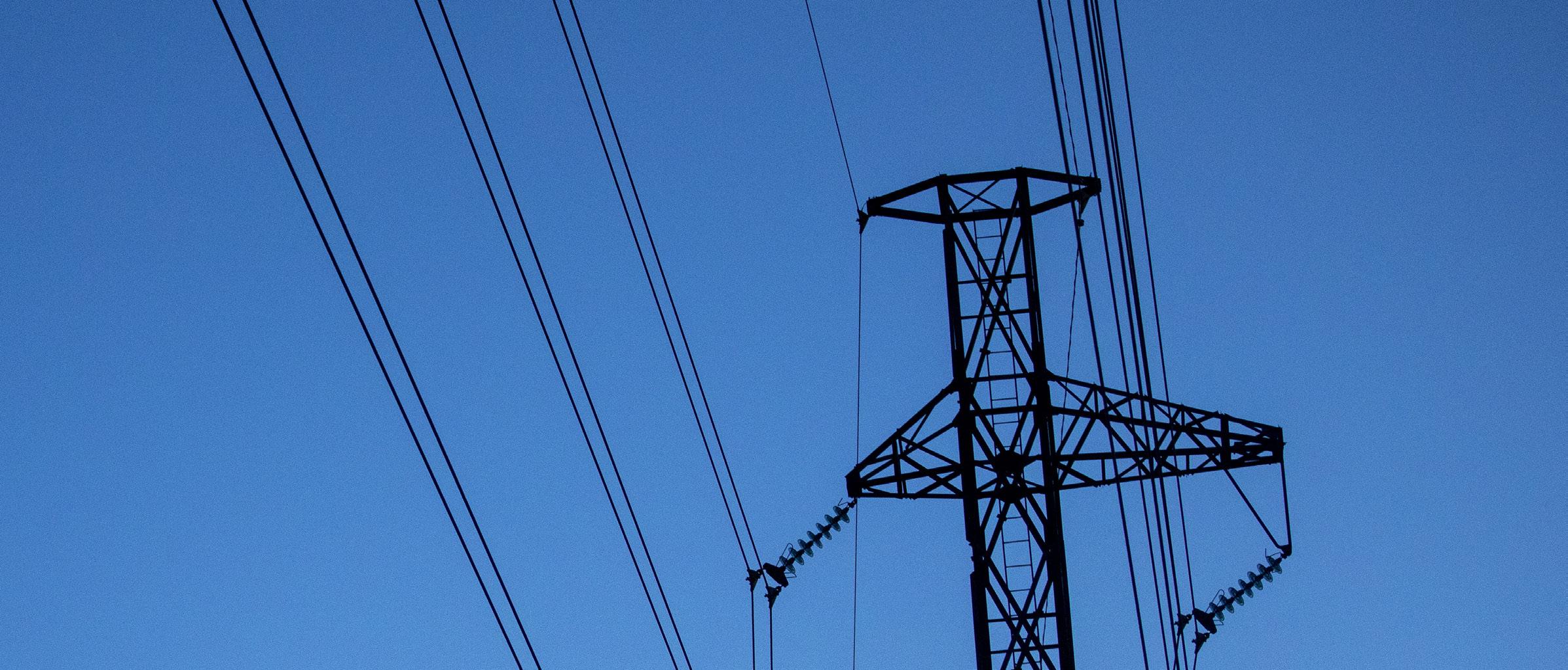
In the European electricity market, products can be traded either on electricity exchanges (such as Nord Pool or EPEX SPOT) for standardised products, or through bilateral OTC (Over-TheCounter) or PPA (power purchase agreement) contracts. In OTC trading, electricity is bought and sold directly between buyer and seller in a bilateral transaction without intermediaries – in effect outside the power exchanges. Individual small consumers cannot directly participate in the power exchange but are usually represented on the power exchange by an energy company, in other words, an electricity supplier. However, a small consumer in Finland can buy electricity from an electricity company at the market price (hourly spot price), often with an additional margin from the company. Another option is fixed price contracts that are available at varying prices. The advantage of fixed-price contracts for the consumer is that the risk of price increases remains with the electricity supplier. There are also so-called hybrid contracts on the market, where the price varies within agreed limits according to the exchange price and the timing of consumption. Electricity suppliers can hedge against the risk of price increases by entering into derivative contracts in advance of the contract period. For example, an electricity supplier can buy electricity on the exchange at a certain price for the duration of the contract by means of a futures contract. If the electricity supplier can get a futures contract at a lower price than what it has committed to sell to its customers under a fixed price contract, the price difference between these contracts is a profit for the company (Rothovius et al. 2013). This would
avoid the risk of a price increase, but conversely the company would not benefit from a drop in the exchange price, as the price of the futures contract would be fixed.
It is also possible for an electricity supplier to enter into a call option contract, where it pays a premium for the right to buy electricity at a certain price. Even if the market price (spot price) is lower than the price specified in the option contract, the electricity supplier would still be allowed to buy electricity at the market price. When the market price is lower than the fixed contract price sold to the consumer, the electricity supplier would make a profit on the difference between the market price and the contract price minus the premium (Rothovius et al. 2013). Similarly, if the option price were more favourable than the market price, the profit over the market price would be the difference between them minus the premium. If the market price remains unchanged, no profit would accrue but the premium would still be payable. Because of the price protection process described above, a fixed-price forward contract is binding to both the buyer and the seller.
Power purchase agreements (PPAs) can be made directly with energy producers, often for several years at a time. In these cases, for example, an industry or company commits to buy electricity from a wind power producer at a certain price for several years at a time. Such an agreement can be made before construction of the actual power plant. Selling the output in advance typically reduces the risk of investing
in the plant and thus improves the chances of obtaining financing for the project. PPAs can be physical or synthetic. In a physical contract, the generator sells electricity directly to the user, while a synthetic contract involves trading electricity through an exchange and the PPA is a derivative contract that is settled based on the difference between the exchange price and the contract price (Wind Energy Association 2019).
Electricity is traded for different periods of time on different markets with different trading patterns. The different marketplaces in the electricity market are shown in Figure 5. Different markets have different functions; derivative contracts are used to manage risk, the day-ahead market is used to buy and sell most of the energy, while the reserve market is needed to ensure a momentary power balance. Cooperation between the different markets ensures that the market maintains a constant power balance in the most costeffective way. For example, futures, forwards, swaps and options are traded in electricity derivatives markets (forward markets). In derivatives markets, trading takes place either bilaterally (OTC markets) or through NASDAQ Commodities (Meeus 2020). Derivatives trading does not necessarily involve the physical delivery of electricity and it can take the form of daily, weekly, monthly, quarterly, and annual contracts, depending on the product.
In the day-ahead market, which also serves as a reference market for financial products, a closed auction takes place once a day, 24 hours before the delivery of electricity. Market
participants submit their bids via national electricity market participants to the European market clearing algorithm EUPHEMIA, which has been developed to calculate the allocation of electricity and the distribution of electricity prices across Europe. Based on the bids of market participants (supply and demand), the market clearing generates both an hourly area price and a system price for electricity. The area price is the price for the bidding zone, which differs from the system price if there is insufficient transmission capacity. Similarly, the system price does not consider transmission constraints but represents the intersection of the bidding curves for sales and purchase offers across the Nordic market area.
The intraday market is used to adjust for unforeseen changes in production and consumption, and trading takes place on the same day as delivery. Most European countries use a continuous trading system in the intraday market, and the trade is executed as soon as the bid and offer meet. In Finland, for example, the intraday market is open until the delivery hour (Fingrid, n.d.-a).
In addition to these, Finland also has a balancing market and a reserve market. The balancing market is a market for balancing energy operated by the Nordic grid companies to maintain an intra-hour balance between electricity production and consumption. In practice, reserve products in Finland have two uses: continuous frequency control and returning the frequency to the normal range in the event of a disturbance.

source IEA (2016)
4.2.2.
For the consumer, the price of electricity consists of three different elements: the price of electrical energy, the cost of electricity transmission and distribution, and electricity tax and VAT. The price of electrical energy includes the cost of buying and selling electricity. The network charges cover the costs of the transmission network, the regional network, and the distribution network. The costs of electricity networks include the maintenance and repair of the network, its renewal, and the construction of a completely new network. The
electricity tax is divided into two tax brackets, with Category I covering households, the agricultural sector, the public sector and service activities, and Category II covering industry, professional greenhouse cultivation, mining, and industrial plants over 5 megawatts (Energy Taxation n.d.). The electricity tax rate for tax category I is 2.253 cents/kWh (+ VAT) while the rate for tax category II is 0.05 cents/ kWh (+ VAT). In addition to the electricity tax, a secure supply levy of 0.013 cents/kWh is paid The consumer price formation in 2022 is shown in Figure 6.

The Finnish electricity market is part of the European electricity market, with estimated social benefits of more than EUR 18 billion per year (ACER 2021). To have the same electricity price throughout a single market area, there should be unlimited inter-regional transmission capacity and no losses. Since this is not possible, different options for electricity pricing have been developed. While the USA electricity market is dominated by nodal pricing, the European single electricity market is characterised by zonal pricing. As Finland is part of the European common electricity market, zonal pricing principles are also applied in Finland. In nodal pricing, or local marginal pricing, electricity prices reflect the constraints of the transmission network and losses of electricity supply between nodes. Nodal pricing is seen as suitable in markets where the physical transmission network is weak, and it is easier to charge a separate nodal price for each node in the network rather than trying to interconnect
larger areas. In contrast, zonal pricing involves forming geographic bidding zones, often either along national borders or in larger or smaller areas. While the initial assumption in each zone of the electricity network is that there will be no congestion on transmission lines, transmission capacity is allocated among the bidding zones when congestion does occur on transmission lines. In congestion situations, or so-called bottleneck situations, different prices may occur in different bidding zones. In such cases, electricity is generally transferred from the lower-priced zone to the higher-priced zone. For example, Finland, Estonia, Latvia, and Lithuania have only one bidding zone each, while Sweden has four and Norway five different bidding zones. Although Åland is geographically part of Finland, from an electricity market perspective it is part of the Swedish SE3 bidding zone.
In both zonal and nodal pricing, the market price for trading in the short-term electricity market is determined by a marginal pricing system (Salovaara et al. 2016). Marginal or marginal

cost pricing uses the so-called merit order curve principle, which ranks the generation offers of different forms of energy production according to marginal cost, starting with the cheapest form of energy production. Marginal costs include, for example, the cost of fuel and the cost of maintaining a production plant. Several generation bids equal to the next day’s electricity consumption are accepted, starting with the cheapest bid, until the price of the highest accepted bid determines the market price of electricity. Power generation plants using renewable energy sources such as solar, wind, and hydroelectric are ranked first. This is usually followed by nuclear power and then coal power plants. Last are gas turbines, most often powered by natural gas. The wholesale market price of electricity rises to a high level when electricity consumption gets close to the maximum available production capacity. The fixed costs of the different forms of generation are mainly covered during peak periods of electricity use.
The European electricity market model, including Finland’s, and its development
are the subject of ongoing debate that has been further stimulated by the energy crisis. However, the development of the market model mostly remains at the level of market mechanisms, and very few comprehensive, more radical reforms have been proposed (Honkapuro et al. 2023; Silva-Rodriguez et al. 2022). For example, the redistribution of price zones has been studied in certain sources (Bertsch et al. 2017; Felling & Weber 2018; Lundin 2022), while Ashour Novirdoust et al. (2021) propose a complete shift from zonal to nodal pricing. Capacity pricing mechanisms have also been studied in several sources (including Hach et al. 2016; Keles et al. 2016; Rios-Festner et al. 2020). One source (Cramton 2017) argues that the best market model to meet future challenges will continue to be an efficient spot market supported by a derivatives market and a competitive resale market that encourages demand response. According to a literature review (Honkapuro et al. 2023), the challenges of individual market mechanisms are well identified, changes to them are seen as desirable, and efforts are ongoing to

develop market mechanisms that better meet the current needs of the electricity market and energy system. The studies included in the same literature review and the solutions or development proposals they present are mainly aimed at achieving the objectives of the European Energy Policy and stronger integration of the trans-European electricity market. As such, this is natural because the energy policies of individual countries are inevitably reflected in their neighbours, making coordination and decision-making between the different actors important at the European level (Corona et al. 2022). The development of a common market is also justified by improved liquidity and efficiency, as well as increased social welfare (Koltsaklis & Dagoumas 2018).
4.4 The energy crisis of 2022 – what happened in electricity markets?
Energy prices started to rise in Europe in autumn 2021, with natural gas availability declining due to maintenance work, drought and a heatwave that disrupted hydro and condensing power generation, while consumption increased as the economy grew after the pandemic. Russia’s invasion of Ukraine in February 2022 brought energy imports from Russia to a standstill. Natural gas stocks were already at low levels, resulting in reduced gas availability and record high gas prices. From less than EUR 20/MWh before the crisis, natural gas prices rose to over EUR 300/MWh (Trading Economics 2023). It was later learned that the earlier gas supply problems due to ‘maintenance’ were part of Russia’s strategy to use the ‘energy weapon’ against Europe.
Unfortunately, there were significant technical problems at French nuclear power plants in 2022. The problem of nuclear power availability in Europe forced the use of expensive natural gas. In addition to the fuel price, the price of emission allowances also increased significantly from a level below EUR 10/tCO2 to around EUR 100/tCO2 (Trading Economics 2023). Water reservoir levels were also below average, and there were real concerns in the autumn about energy availability over the winter. This all led to record high electricity prices. However, it is worth noting that it
was the price crisis that caused significant challenges for households and businesses. The electricity market functioned according to its principles; scarcity of supply pushed up prices. Increased prices, in turn, reduced consumption. This led to the desired result that Europe had sufficient energy. There was also a risk of power shortages and subsequent power cuts in Finland, but high prices, an information campaign (in Finland, Motiva’s ‘astetta alemmas’ campaign) and reduced consumption during the mild winter eventually meant that they were not needed.
The debate on the functioning of the market model began during the crisis. Alternative market models were proposed, and there was even speculation about a total reform of the European electricity market. In summer 2022, the European Commission started to prepare a ‘REPowerEU’ package of legislation to make the electricity market more crisis-proof. The package was submitted for comments in March 2023 (EC 2023a). Overall, the electricity market will remain almost unchanged. The main changes are related to the promotion of renewable generation, for example, by means of price-fixing contracts (CfDs) and long-term power purchase agreements (PPAs) as well as improved consumer rights, guaranteed access for consumers to different types of PPAs, dynamic contracts to promote demand-side flexibility, and fixed-price contracts to reduce consumer risk. Member States will also be granted rights to support consumers in the event of an electricity price crisis. However, it is important to note that the principle of marginal pricing, which has proven to work well, will not be changed
The types of electricity contracts typically offered to consumers can be divided into four categories:
» Valid until further notice contracts: the seller may change the price by giving at least one month’s notice. The customer may terminate the contract with two weeks’ notice.
» Fixed-price, fixed-term contracts: the price of electricity is agreed for a fixed period, typically one or two years. A penalty may be payable for early termination of the contract.
» Spot price-based contracts (aka dynamic or real-time pricing): the price varies hourly, based on the Nord Pool’s Finnish area price and the seller’s margin.
» Fixed-term contracts with a flexibility incentive: hybrid contracts have become more common in recent years, where the price is set at a basic level, but increases/ decreases depending on whether the customer’s consumption is at a higher or lower hourly rate than the average exchange rate.
» All electricity users are free to choose their electricity supplier. However, under the
Electricity Market Act (2013), the electricity supplier with the largest market share in a given distribution network area is obliged to supply electricity at a reasonable price to consumers and other end users whose premises are equipped with a maximum of 3 x 63-ampere main fuses or whose electricity consumption does not exceed 100,000 kWh per year. The prices of the contracts covered by the obligation are not regulated, but the customer may, if desired, submit a request for investigation to the Energy Authority.
Määräaikainen sopimus
Pörssihintaan perustuva sopimus
Toistaiseksi voimassa oleva sopimus
Figure 7. The share of retail customers by contract type 2018-2022 (Energy Authority 2023b)
Blue colour means a temporary contract, orange a permanent contract and grey a market-based contract.
Fixed-price contracts have been popular (Figure 7), but the energy crisis reduced consumer choice in winter 2022-23, when the number of electricity sellers offering fixedterm and open-ended contracts decreased significantly (Energy Authority 2023b).
According to the market situation at the time, variable prices can be offered to retail customers because more than 99% of electricity users in
Finland have a smart meter that records the time of consumption at least on an hourly basis.
Figure 8 shows the development of the electricity offer prices for electricity contracts valid until further notice, one-year and twoyear fixed-term offers, the prices for electricity to be supplied, and the Finnish area price of the Nord Pool electricity exchange from 1 January 2021 to 1 August 2023.
snt/kWh
Toistaiseksi voimassa oleva 1v määräaikainen
2v määräaikainen
Nord Pool Spot
Toimitusvelvollinen
Figure 8. Electricity price evolution for a household consuming 5,000 kWh per year (incl. VAT, average of offer, and obligation to supply prices on the first day of the month) and monthly averages of the Nord Pool electricity exchange’s Finnish area price (excl. VAT).
Consumers can also buy electricity by investing in their own generation or by participating in an energy community. Finnish legislation defines one type of energy community: the local energy community (VnA 767/2021). A local energy community may produce, supply, consume, aggregate, or store energy and provide energy efficiency services, electric vehicle charging services or other energy services to its members or shareholders. Members or associates may be natural persons, municipalities, or other local authorities, or small or mediumsized enterprises. The electricity points of use of the members/shareholders in the
local energy community must be located on the same property or equivalent group of properties and connected to the distribution network through the same connection. In practice, the legislation allows for the creation of an energy community in an apartment block or an industrial estate, but a community of detached houses behind separate connections is not recognised in the current legislation. However, the Energy Community Working Group appointed by the Ministry of Employment and the Economy (2023) has recommended that the implementation of decentralised communities should be investigated.

In addition to energy security and energy affordability, the third pillar of energy systems is energy sustainability, which drives the sustainable energy transition in Finland. The energy systems change – often also called an energy transition – is an ongoing societal change of energy systems aiming to decrease CO2 and other greenhouse gas emissions in order to mitigate climate change, reduce the environmental impacts of energy production and consumption, and enhance more socially and economically just energy systems. The energy transition is a long-term socio-technical change that involves all the different societal actors and sectors, including policy and regulation, industry and societal associations, companies, municipalities, and citizens/residents.
Sustainability of energy systems starts with the notion of planetary boundaries (Rockström et al. 2023) that should be taken into account in all decision-making. The framework of strong sustainability suggests that both ecological and human systems are inherently linked to each other, with ecological systems serving as the prerequisite for all human activities (Rockström et al. 2023, Neumayer 2003, Giddings et al. 2002).

Figure 9. Framework for strong sustainability that takes planetary boundaries into account as starting point (Neumayer 2003, Giddings et al. 2002).
The most developed countries are using approximately 75% of global material resources, which means that the resources of one planet would not be enough if all countries had the same consumption (OECD 2021). For example, the average Finn consumes more than 100,000 kilos of resources per year, which is more than in other European countries and the largest share of which is hidden material flows of imports (Finnish Environment Institute 2023, Statistic Finland 2023a). This would require four planets if everyone had the same consumption level. The carbon footprint of an average Finn decreased by two tonnes from 2005 to 2021, when it was 10 tonnes of GHG emissions. A large share of this is due to the way our energy systems are globally organised, with 80% of energy still produced using fossil energy sources (IEA 2023b). At the same time, more than 775 million people do not have access to energy (IEA 2022a). The challenge of converting the current imbalanced energy systems to low-carbon production and consumption systems is enormous. It includes analysing the impacts of resource and material use, environmental, societal and economical justice, health and wellbeing, reducing climate change, and increasing biodiversity.
Section 6 focuses on the drivers for sustainable energy systems as well as the opportunities, risks and impacts of low-carbon energy systems for Finland.
Finland’s National Climate and Energy Strategy lists measures to reach the EU’s climate commitments for 2030 and an implementation strategy regarding how to reach the targets. In the strategy, Finland commits to reducing greenhouse gas emissions by 60% by 2030 and 80% by 2040, as set out in the Climate Change Act, and achieving carbon neutrality by 2035 (Ministry of Economic Affairs and Employment of Finland 2022).
In order to reach these targets, the strategy highlights areas such as promoting noncombustion-based heating, electrification of the energy system, and use of system integration in sectors where decarbonisation is challenging. The strategy also includes a national hydrogen strategy (TEM/2023/14) to increase different electrofuels and quantitative targets for hydrogen electrolysis capacity (Ministry of Economic Affairs and Employment of Finland 2023a). By 2030, Finland is estimated to achieve higher levels of renewable energy but exceed the maximum energy consumption limits set in the EU’s Fit for 55 package (Ministry of Economic Affairs and Employment of Finland 2022).
Finland’s energy system is on its way to decarbonisation, and there are several different pathways that Finland can follow (see LUT 2022a). The benefits of Finland’s energy systems are its diversity that includes several different energy sources, the existence of large amounts of renewable energy mostly based on bioenergy, and a reliable infrastructure. Finland aims to achieve carbon neutrality through nuclear and renewable energy, energy efficiency and electrification, with a focus on reducing emissions in the transport and manufacturing industry. Approximately onethird of Finland’s electricity is produced by means of low-carbon nuclear power, which
is expected to have a strong role in the future energy mix in Finland. The country is also committed to improving energy efficiency, which plays a crucial role in reducing energy consumption and emissions, especially in areas like transportation and manufacturing.
Biomass, wood-based fuels, and biowaste has always had a vital role in Finland’s energy mix and continues as such in terms of replacing peat and fossil fuels. Bioenergy is mostly used for heat and electricity generation. Acceptance of wood energy is driven by its economic importance and wide distribution of forest ownership, but sustainability concerns persist with regard to land use changes and related biodiversity losses, forest carbon stocks, as well as its impact on freshwater bodies. The changes in forest ecosystems caused by the use of bioenergy affect a large number of species, as the vast majority of species in Finland are forest species and therefore the majority of endangered species also live in forests (31%) (Hyvärinen et al. 2019). Recently revised Nature Conservation Act (9/2023) defines for the first time the criteria for ecological compensation for activities that weaken natural values (Soimakallio & Pihlainen 2023). For the time being, compensation is voluntary, but more and more companies and business developers are interested in compensating

the environmental damage caused by large projects as part of their sustainability efforts. At the time of writing this Energy Outlook, the EU nature restoration law is still under political discussion. If passed, the law would form an important part of the European Green Deal program, aiming to define and coordinate the commitments of the EU and its member states to solve climate change and the loss of nature.
The sustainability of the forest sector, its impacts on nature and water bodies, and the carbon sequestration potential can be improved for example by reforming forest management practices. In recent years, new research has increased the understanding of the soil’s carbon sequestration potential and what is the impact of different forest management practices (Mäkipää et al. 2023) that support better decision-making. This helps to enhance climate policy and optimize the use of resources, as bioenergy is an integral part of several industries in Finland in the future as well, and their share of industrial energy consumption is considerable.
In order to achieve Finland’s carbon neutrality goals, wind and solar energy production is expanding and expected to grow significantly in future. As the share of solar and wind power are growing steadily in Finland, the
changes in the land use will increase. At the moment regulation and permitting processes of solar and wind power varies, and projects of the same size may require different permits in different regions. The Ministry of the Environment (2023) is currently running a project to unify the practices applied in the planning and construction of large solar power plants. Several offshore wind demonstration projects are under planning, but investment backing is expected, and legislative clarity is needed to further develop offshore wind along the coast. The growth of renewable energy creates new environmental and social impacts, for which there is a need to find solutions to implement energy transition in socially just and ecologically sustainable manner.
A successful energy transition can enable a wide range of possibilities for Finland. We approach these possibilities with a handprint approach, which refers to the beneficial environmental and societal impacts that organisations can achieve and communicate by providing products or services that reduce the footprints of customers (Pajula et al.

2021). The energy transition also includes new impacts on the environment, society and economy, which are important to discuss and identify in order to reduce harmful impacts and amplify positive impacts. New risks related to the energy transition are categorised as 1) regulatory and policy risks with potential to hinder development, 2) societal risks of the energy transition, 3) new environmental risks related to renewable energy, 4) technological and economic risks of novel technical solutions.
The handprint approach to achieving positive environmental and societal impacts
The handprint effects of Finland’s energy systems include development of sustainable technologies, production of sustainable products and fuels, energy-efficient and smart solutions, and a high level of education. For example, Finland is a provider of smart energy solutions and developer of intelligent technology that reduce energy consumption and emissions, and it boasts one of the world’s most advanced smart grid markets. Finland aspires ambitiously to establish circular economy market, which would encourage investments and the creation of novel solutions.
The positive environment and societal impacts of the energy transition in Finland are related to decarbonisation and electrification, enhanced exportability of green products and low-carbon energy, reduced dependency on imported energy, improved air quality, and reduced climate change impacts caused by the energy sector. Electrification has become a significant trend across the country, especially in the transport and industry sectors. For example, this has boosted the development of heat pump technologies, electric charging stations and operations, as well as the development of hydrogen and other e-fuel solutions.
It is expected that Finland’s potential to produce cheap and clean electricity can be used to provide multiple alternatives to fossilbased products through Power-to-X solutions (P2X, see also section 7.2.3), or to export clean energy. Radical GHG emission reduction potentials of up to 90% exist when replacing fossil carbon-based products – such as fuels, chemicals, and steel – with renewable energybased P2X products (Guzmán et al. 2021; Isaacs et al. 2021; Razon et al. 2021; Zhang et al.

2017). Exporting and replacing more emissionintensive products in markets outside Finland can result in larger handprint effects and higher emissions savings than those available by focusing only on decarbonising Finland’s energy system. Finland’s hydrogen cluster brings together all the planned P2X projects, including the production of green steel, synthetic ammonia and synthetic methanol (H2 cluster projects, see also section 7.2.1).
Successful implementation of P2X solutions requires an extensive investment and increase in renewable energy capacity installations. There is a relatively high amount of biogenic CO2 sources in Finland, which can be captured and utilised for P2X products (Kujanpää et al. 2023) and planned new industrial-scale solar power and wind power plants (Finnish Wind Power Association 2023a; Aurinkoenergiayhdistys 2023), which suggest that some of the planned P2X projects will be realised. In addition, a study involving a Delphi survey conducted to assess how meaningful the energy transition can be for Finland concluded that various P2X solutions are potentially beneficial for Finland (Sillman et al. 2023a). However, all of the above-mentioned projects require extensive environmental and societal impact assessment.
The energy transition brings several positive societal benefits that are most often measured
in terms of national income in the form of GDP and estimates of how many new jobs will be created. The International Renewable Energy Agency (IRENA) estimates that renewable energy (solar, wind, hydro, biofuels) employs 12.7 million people worldwide, with approximately 60% of the jobs in Asia. China alone accounts for 42%, Europe 10%, Brazil
10%, United States 7% and India 7% of these jobs (IRENA 2022). For purposes of comparison, the IEA estimates that fossil energy industries employed 32 million people in 2019 (IEA 2022b). In Finland, the energy industry employed approximately 40,000 people (person months): 23,000 directly and 19,000 indirectly (see figure 10.).
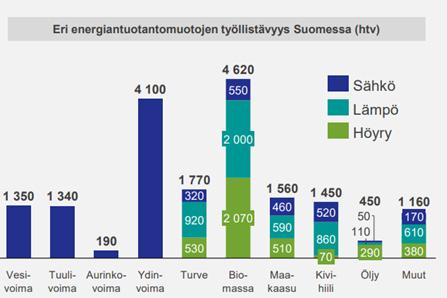
In addition to the jobs created in the renewable energy industry, growth in clean energy can create positive economic ‘ripple’ effects along the value chain that benefit local businesses, municipalities via property and income taxes and household, and especially landowners via rent income. For example, wind energy companies in Finland pay rent to landowners and a municipal land tax that is based on the land value, size of the wind facility’s buildings, and power production. If the power plant capacity is less than 10 MW, the tax varies between 0.93% and 1.80% of the land value, while power plants larger than 10 MW pay a special power plant tax that can be as high as 3.1%.
New risks related to the sustainable energy transition and how to mitigate them
While it generates several positive societal benefits, the energy transition also involves new risks and impacts for society, the environment and economy. These have to be analysed and researched in order to mitigate harmful effects while strengthening the positive effects. It is important to note that these are risks that previous research has identified but which have not yet been realized and may remain unrealized if taken into account in early stages. Table 2 presents a short overview and description of the risks of the energy transition that will be discussed further later in this section.
The major regulatory risks are related to inconsistency and contradictions between new and old regulation, directives and law. Furthermore, decisions made to accelerate the energy transition can include harmful societal effects on different groups, such as lost jobs. This causes a risk of postponements in political decision-making. Various political coalitions lobby on behalf of their own benefits, causing watering down of new directives or regulation.
Reducing use of fossil energy reduces all harmful GHG emissions and climate change, health and environmental impacts. New environmental risks of the energy transition are related to local impacts of renewable energy production, including land use and soil changes, impacts on water resources, local species, and biodiversity. Furthermore, it increases the amount of mining wastes resulting from extraction of the minerals needed for batteries and other related technology, as well as technology waste at the end of the life cycle.
The major societal risks associated with the energy transition include risks related to non-participation and excluding vulnerable groups, unequal distribution of benefits, jobs and harmful impacts, lack of trust regarding energy providers – all of which reduce social acceptability of the energy transition. Land use changes impact local livelihoods, the availability of environmental services for everyone, and the cultural value of land.
Investment risks related to investing in new projects and solutions that may not be implemented, risks related to carbon taxes, reduced land value due to new industrial sites.

In recent years, there has been a growing recognition among academics, policymakers, and practitioners that the energy transition holds transformative potential for our societies, encompassing economic development, social inclusion, energy security, health improvements, job creation, and other societal benefits (UN 2021). Gaining these benefits requires the active involvement of small and medium-sized enterprises, municipalities, and various civil society actors. However, the political and economic power in energy sectors is often concentrated among a few of the most powerful actors, often large corporations that wield significant influence due to their substantial financial
resources, and lobbying capabilities that are linked to their market dominance and/ or political connections (Heiskanen et al., 2018). While some concentration of power is necessary to coordinate the complexities of the energy system, it can lead to various unintended consequences. Most notably, it limits the diversity of perspectives, potentially excluding marginalised groups and people in a vulnerable position – such as low-income households, people with disabilities, or ethnic minorities – from decision-making processes (see, for example, Kosanic et al. 2022). This type of societal exclusion risks leaving ordinary citizens burdened with the financial, environmental or health costs, while the privileged actors benefit from
renewable energy investments. Furthermore, limiting the diversity of voices in the energy transition debate may result in inadequate consideration environmental and social aspects. For example, excluding academics or environmental organisations could lead to insufficient scrutiny to ensure that renewable energy projects meet sustainability criteria.
The concentration of power can also erode transparency and accountability in the energy transition, which may lead to decreased social acceptability of renewable energy projects and further social inequalities (Gallop et al. 2021) that slows down the implementation of the projects. Moreover, neglecting to consult with local communities during project planning can lead to widespread public protests and opposition (Ogilvie and Rootes 2015). To address these challenges, a broadly inclusive dialogue that considers the perspectives and interests of all affected parties is essential. Different stakeholder groups, including NGOs, local communities, regional politicians, and local businesses, should be involved in the early planning stages of renewable energy projects. This inclusive approach increases the chances of successful implementation and social acceptance of renewable energy. However, it also presents challenges related to different interest levels, information access, knowledge, and resource disparities among participants (Lukkarinen et al. 2023). These issues can be managed through deliberate planning and open communication channels, ensuring that all participants can voice their concerns and have power in the decision-making process.
The processes causing environmental impacts related to energy generation can be grouped into three life cycle stages, which are upstream processes related to the energy infrastructure (extraction, manufacturing, and construction) and fuel cycle (extraction, production, processing, and delivery), operation (combustion, maintenance, and other operations), and downstream processes (dismantling, decommissioning, and recycling). The most prevalent environmental impacts of energy production are greenhouse gas (GHG) emissions. Figure 11 compiles information on the ranges of GHG emissions of electricity production with different fuels and technologies.
In the case of fossil fuel electricity production, the GHG emissions are mostly related to combustion emissions, while construction causes the main impacts in renewable electricity production, like wind and solar power (NREL 2021). This means that when renewable energy production increases, the emissions from construction and future renewable electricity production would decrease. Furthermore, an increase in the capacity factor and expected lifetime of wind power plants would further reduce the emissions over their lifetime (Finnish Wind Power Association 2020). In the case of electricity generation from waste and biogas, it should be noted that only the direct impacts are included and the avoided impact that possible landfilling would cause are not accounted for.
In addition to climate impacts, energy generation consumes water reservoirs. In dryer or hotter locations than Finland, energy generation sometimes needs to be rationed due to overly hot or low water reservoirs, as was the case in France during summer 2022. Fossil fuels and some renewable resources, such as biomass, consume extensively water due to cooling needs and fuel production. Wind power has lower water footprint than solar power because solar panel (PV) production consumes a much higher amount of water than wind energy generation because of the raw material acquisition (Mekonne et al. 2015). Thus, when considering virtual water footprints, importing solar panels from areas suffering from water scarcity can have severe negative local impacts.

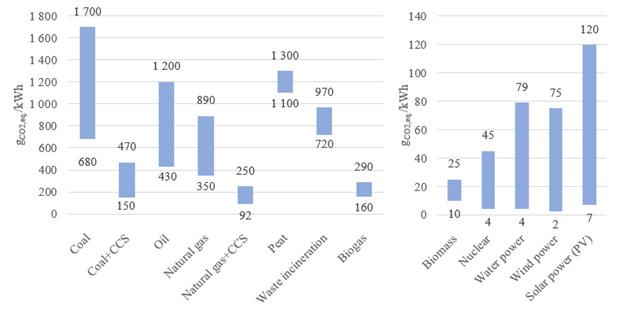
Figure 11. A compilation of greenhouse gas emission factors for electricity generation (CCS=carbon capture and storage). (Arvesen and Hertwich 2012; Asdrubali et al. 2015; Bruckner et al. 2014; Ecoinvent 2019; Hertwich et al. 2015; Spath et al. 1999; Sphera 2021; UNECE 2021; Van der Giesen et al. 2017; Whitaker et al. 2012; Ovaskainen 2017).
Although changing to cleaner energy systems provides clear environmental benefits, such as a lesser amount of lifetime GHG emissions, solar and wind energies still have local negative impacts. Noise, bird fatalities and land use change impacts are already well recognised issues related to wind farms and solar power plants, although many of those impacts are relatively small compared to other human activities or other energy generation types (Dhar et al. 2020; Sayed et al. 2021; Tawalbeh et al. 2021). However, understanding these issues and potential solutions to them is increasingly important because of radical predicted capacity investments in the near future. As the capacities grow, the cumulative impacts of land use change and impacts on nature will increase.
Most of the studies of the impacts of both solar and wind power on wildlife have been conducted on volatile animals, birds and bats (Dohm and Drake 2019, Hein and Hale 2019). Annual bird and bat fatalities are estimated to vary between 8-118 and 12-53 per turbine, respectively, in Spain and the USA (Sánchez-Navarro et al. 2023; Wang & Wang 2015; Wilson et al. 2022). Although this is the case, studies comparing different causes of fatalities has found higher bird fatalities caused by conventional electricity generation in comparison to wind power (Sovacool 2013). However, there are
high levels of uncertainty regarding the fatality rates because they are highly location-specific. For example, an investigation conducted by the Ministry of the Environment (2016) indicated that wind farms have only a minor impact on the bird population (0 to 50 per turbine) in Finland, especially if wind farm locations are carefully planned. On the other hand, for large, slowly reproducing bird species, such as the golden eagle, even a small additional mortality in a population may be fatal (Tikkanen 2022). It is known that some birds can eventually learn to avoid wind blades. The number of bird fatalities can be considerably reduced by the following measures; painting the blades makes them more visible to birds, finding locations where the turbines are less harmful for flying animals, and restricting blade movements during migration seasons.
Large power plant areas may also fragment previously unified habitats and thus create a barrier for animal movement, change the microclimate, produce disturbing light and noise, and contribute to the spread of harmful alien species (Tsoutsos et al. 2005, Hernandez et al. 2014, Walston et al. 2016, Grodsky et al. 2019, Gasparatos et al. 2017). Many animal species, including birds and bats, avoid wind and solar power areas up to kilometers away (Lloyd et al. 2022, Marques et al. 2014, Łopucki et al. 2017, Skarin & Alam 2017, Heinänen
et al. 2020). Habitat fragmentation poses an additional threat to biodiversity (Hanski 2015). The most harmful impacts on nature and wildlife can be prevented by avoiding construction in areas that are natural or semi-natural and in areas known to have ecological importance (such as breeding, wintering and feeding areas and migration routes for birds and mammals). Noise pollution can be tackled with regulatory guidance that sets safety limits for residual areas, but technological development can also alleviate noise pollution (Dai et al. 2015; Wang & Wang 2015). In addition, it has been shown that large-scale wind farms can change local surface temperatures and hydrology, because wind turbines generate turbulence. This can cause changes in local weather and affect the local biosphere. However, further research is required to understand the severity of impacts on microclimates (Nazir et al. 2019).
Land use change impacts are topical, as there are many conflicting needs for land. For instance, there is a need to increase the biodiversity and carbon sinks in Finland. These aspects should
therefore be considered when planning solar power plants and wind farms, as proper regulation and planning may even lead to increased local biodiversity (Walston et al. 2023). Further research is needed in order to respond to these issues because many targets and regulations related to biodiversity or carbon sinks are still relatively new. When considering the saved lifetime GHG emissions, the benefits gained by replacing fossil energy with solar or wind energy are many times higher than if renewable energy was not used – even if there is a need to cut down forest to build the required infrastructure. The annual carbon sink of boreal forest is around 3.7 tCO2-eq per ha, while the required direct land use for a wind farm is estimated to be around 0-0.6 ha/MW and approximately 0.001 ha/ MW for solar panels. A new wind turbine (4.2 MW) generates approximately 19,000 MWh of electricity per year in Finland (Ioannidis & Koutsoyianni 2020; Finnish Wind Power Association 2023a).
Although the benefits of renewable energy outweigh the harmful environmental impacts at the moment, it is crucial to consider how the
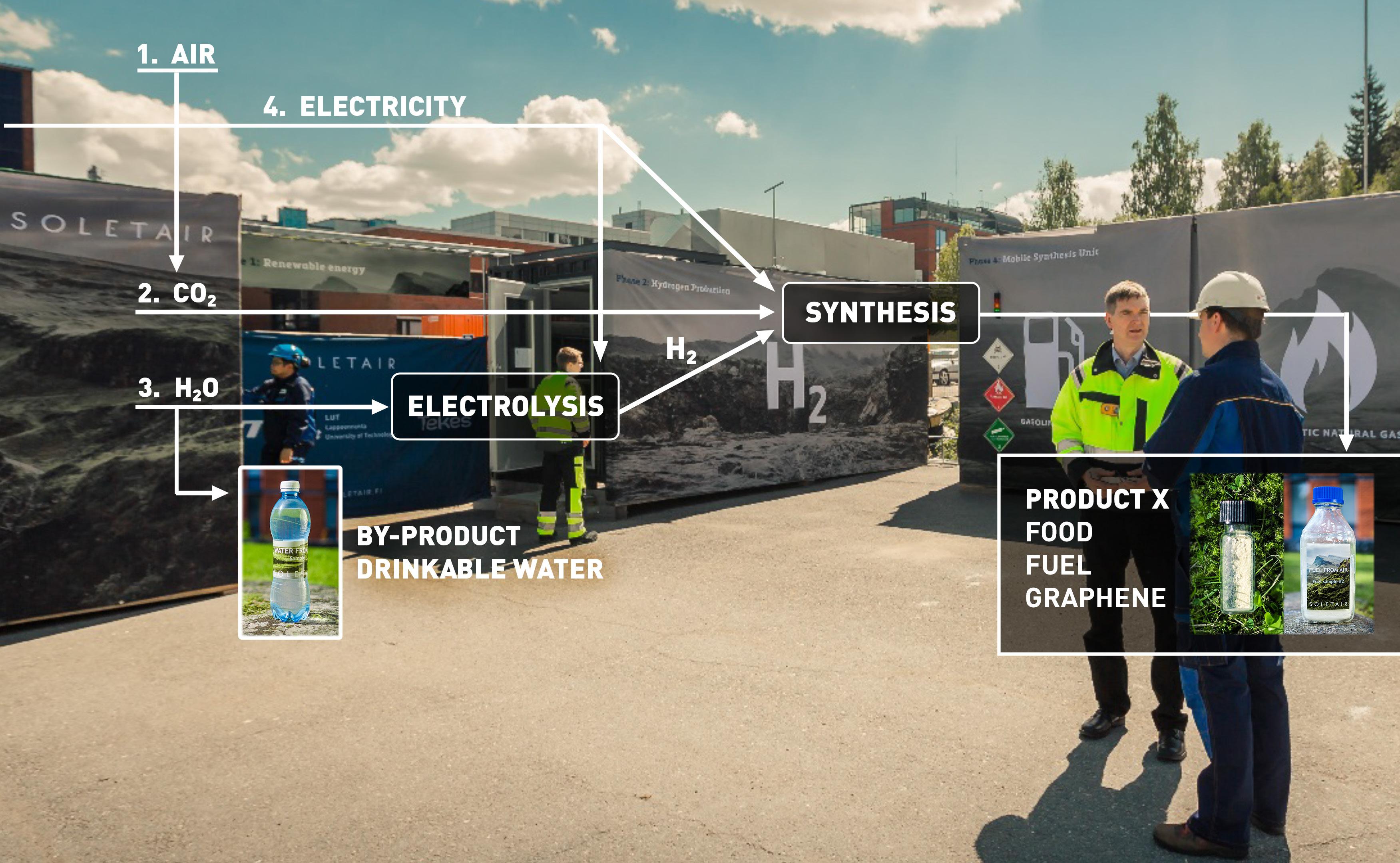
benefits and impacts on nature are distributed when the share of renewable energy further increases in our energy systems. Then again, most of the negative impacts can be minimised by means of careful planning that takes the local topography and biosphere into account when choosing suitable locations for new wind turbines or solar power plants.
Economic and technological risks
Several novel technologies have potential economic and technological risks. Most of the P2X solutions are still novel technologies requiring R&D, and their economic feasibility remains uncertain. For instance, the IPCC (2022) recently recognised the potential of P2X technologies with regard to replacing fossilbased products with carbon-based products. However, their emission reduction effects depend on whether the used CO2 comes from biogenic or fossil sources, whether P2X solutions are produced with renewable energy and only if this actually reduces the fossil fuel consumption. The report also states that more research on the emission reduction potential of P2X products is needed (IPCC 2022).
In addition to emission reductions, the implementation of many P2X solutions requires improvements in profitability. Other economic risks of the energy transition are related to the changes in land use and the possibility that land value near renewable energy industrial sites might decrease in some cases. However, the largest economic risk involves the continued use of fossil fuels due to the severe consequences of not keeping global warming at tolerable limits and stricter regulations related to fossil fuel usage, such as the increasing price of greenhouse gas emissions through emission trading systems, and the carbon border adjustment mechanism.
The European Green Deal underscores the centrality of people in achieving climate neutrality by 2050 and ensuring a just energy transition (EC 2019b). The ongoing decentralisation and increasing energy democratization that is a wider
citizen engagement in energy systems marks a significant shift. Citizens are expected to take on various new roles and responsibilities in energy systems. They can engage in numerous ways, for example, as investors, innovators, flexumers who can store and distribute surplus energy, participants in local energy initiatives, or supporters of climate movements. It has been increasingly recognised that in order to achieve climate neutrality on time, active participation is essential from both traditional energy players and previously passive actors like households. This is essential because households represented 27% of the final energy consumption in the European Union (Eurostat 2022). Thus, citizens are now increasingly seen as active participants in the energy markets rather than passive consumers who are merely responsible for paying their energy bills on time (Jimenez Iturriza et al. 2019). A crucial factor is the growing popularity of community energy, where energy producer-consumers, so called prosumers can jointly produce, store, exchange, and trade energy (Walker and Devine-Wright, 2008). Such initiatives aim to benefit communities economically, socially, and environmentally, in addition to providing financial gains – thus creating more democratic and transparent energy systems (IRENA 2020; Wittmayer et al. 2020).
There are several different types of energy communities, for example in EU Clean Energy for All package (EC 2019a) define two types of energy communities (see more in section 7.2.5.). The number of energy communities has increased in Finland, especially amongst existing communities such as housing companies. Finland has more than 900,000 housing associations, which makes the potential high for local energy production and consumption (see more in section 7.2.5) in the housing sector. However, other types of community energy projects are relatively rare compared to places like Denmark, where some wind power plants are owned by different type of coalitions, associations and communities. Community energy initiatives allow the distribution of energy, income and other benefits in a more socially just manner. It also expected to democratise the energy systems, make them more flexible and resilient, and reduce the power differences in energy systems.
As citizens gain more rights and control over how energy is produced and consumed, which reduces their dependence on centralised infrastructure and governance, they are simultaneously subjected to new responsibilities (Wahlund and Palm 2022). This can raise questions about the equal involvement of different societal groups, which might significantly differ in terms of their investment capacities, technical knowledge and skills, or the available resources needed to become individual or collective energy prosumers. Conditions for energy communities also vary greatly within European countries, which can create challenges and tensions in forming energy communities (Apajalahti et al. 2023)
Energy flexibility and demand response solutions are needed in connection with the increasing amount of fluctuating solar and wind energy capacity. Conventional solutions to balance the grid have involved using hydropower or fast startup power plants, such as gas turbine plants. Along with conventional solutions, novel technologies like P2X solutions, batteries, and virtual power plants (VPPs) can add resilience to the grid because they can function as demand response solutions (Buttler and Spliethoff 2018; Fan et al. 2020; Vedullapalli et al. 2019). For example, the idea of a VPP is to integrate multiple demand response solutions, such as the heat and ventilation and air conditioning (HVAC) systems of buildings, as part of energy storage systems under a cloud-based platform (Abbasi et al. 2019; Rotger-Griful et al. 2016; Royapoor et al. 2020). Aggregating HVAC systems enables the adjustment of electricity consumption by reducing or increasing the required energy in buildings instantaneously based on frequency in the electricity grid. In addition to grid management,
demand response solution providers can join the electricity market as electricity providers, which may create economic profits and climate benefits by reducing the need to use gas turbines for balancing the grid (Sillman et al. 2023b). Several novel solutions to increase balancing power are under development, including adding water pumps to existing dams and various storage technologies.
Furthermore, simply reducing energy use during peak hours and reducing energy use through energy-saving measures are also very efficient means of shifting the timing of energy use. The energy intensity of everyday lives has been steadily increasing, which has placed expectation on citizens to change their consumption habits in a more energy-efficient direction. Behavioural changes that eliminate unnecessary or wasteful energy consumption – from buying energy-efficient light bulbs to reducing air travel or switching to electric transport – is increasingly perceived as essential for achieving climate neutrality goals (Johansson et al. 2021). However, behavioural inertia – the human tendency to maintain the status quo –means that such changes are particularly difficult to implement. For example, citizens might resist changes because of the perceived higher initial costs of the required investments, inconveniences related to changing their lifestyles (Abrardi 2019), lack of perceived alternatives or simply because they cannot afford to do so. Moreover, behavioural changes are not only individual choices but also dependent on the collective everyday practices at homes and work places, the effective policies and systemic solutions, such as available sustainable technologies, products and infrastructure that can be supported through regulation.

6.1.1
Bioenergy is the largest source of renewable energy on a global scale. It currently accounts for over half of all renewable energy supply and over 6% of total energy. Global bioenergy capacity increased from 85 GW in 2013 to 149 GW in 2022, and the majority of this is solid biofuels and renewable waste. During the same period, the capacity in Finland increased from 2.0 GW to 2.7 GW (IRENA 2023a). Bioenergy plays a key role in the Finnish energy system and its production is largely related to the forest industry sector, which generates large amounts of woody residue and bioenergy in its processes.
Modern bioenergy generation will also have an important role in replacing fossil energy sources in the near future. For example, increased use is expected globally in the industrial, district heating, road transport and

aviation sectors. Increased bioenergy use is supported by policies in the EU, USA, India and Australia. The greatest potential lies in more efficient utilisation of organic waste. In this scenario, sustainable waste streams that include agricultural residues, municipal waste and forestry industry residues do not require dedicated land usage. Investing in waste management thus enables the production of bioenergy, mainly in the form of improved biofuels and biogas from a variety of waste streams (IEA 2021)
Finland is promoting the use of bioenergy in the transportation sector for a system that utilises a combination of liquid and gaseous biofuels as well as other alternatives such as hydrogen, electro-fuels, and electrification. For instance, the biogas production target in Finland is 2.5 TWh of biogas for use in transportation by 2030 and 5-6 TWh by 2045 (the Ministry of Transport and Communications 2021). Most of the biogas production in Finland takes place at centralised
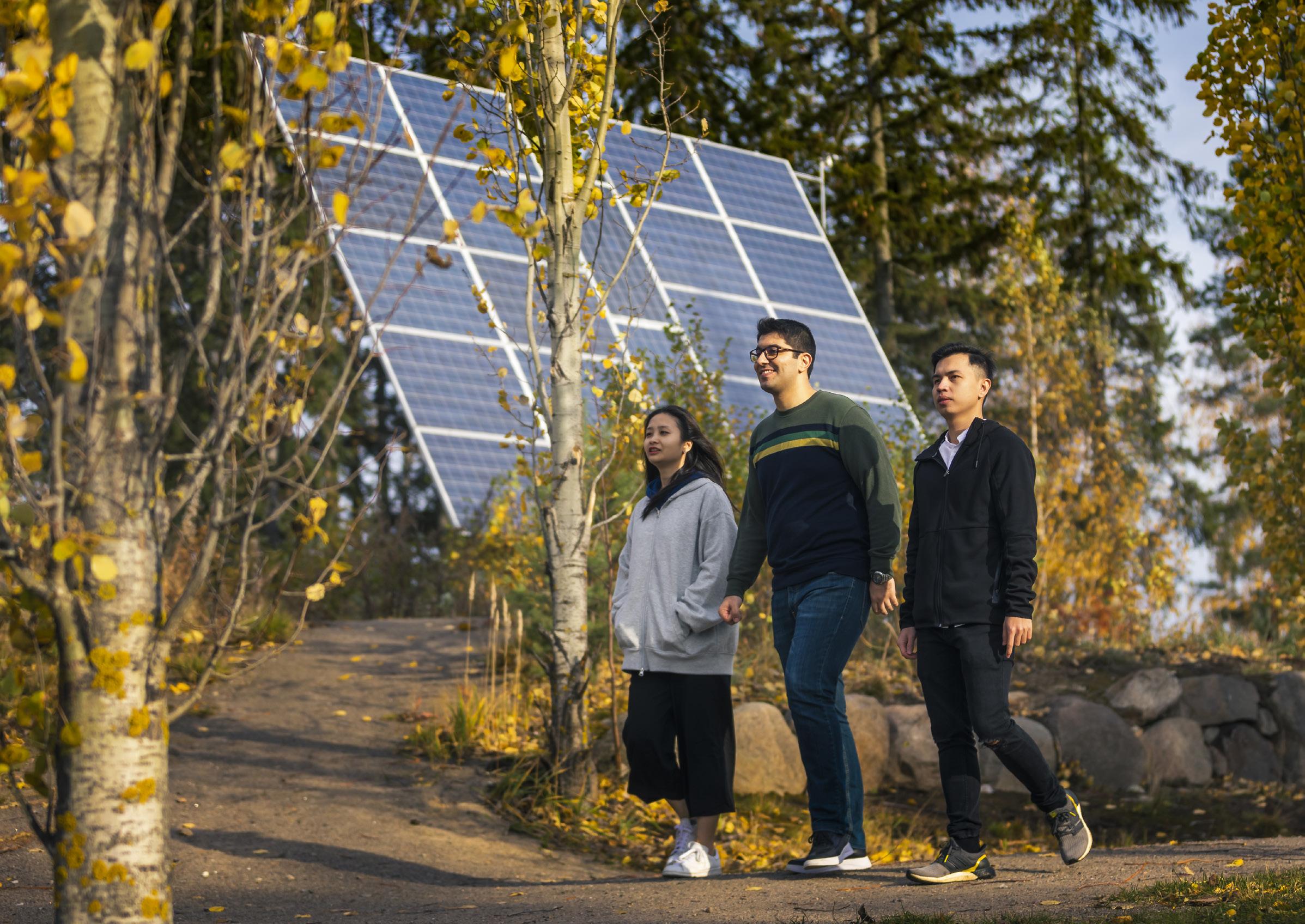
facilities such as co-digestion units, wastewater treatment plants and reactor installation units. Smaller amounts of biogas are also produced in farm-scale and industrial biogas plants. A total of 26 new biogas production plants were built between 2021 and 2023, and the expansion investments on existing plants has increased the production capacity. Biogas plants located in Finland can be found from Google maps (Biogas plants in a map 2024).
The growing interest in biogas production has a positive impact on the profitability of Finnish farms. New projects have been developed to strengthen the role of biogas produced from farm manure and agricultural residues. For instance, approximately 40 biogas plant investments are planned and/or under construction. The energy company St1 and food manufacturer Valio have agreed to produce up to 1,000 GWh of biogas from farm residues by 2030 at Suomen Lantakaasu Oy. Most of this will be used as fuel for heavy-duty transportation.
Although the scale of the Finnish forest industry means good availability of raw material for wood pellet production, wood pellets play a relatively minor role in terms of Finnish bioenergy. Despite increasing consumption (530 kilotonnes in 2022), major growth in the wood pellet industry is not expected in Finland. The availability of other solid biofuels, such as forest industry by-products and forest chips are cheaper for the end consumer than wood pellets. Finland has a few projects related to wood pellet usage. For example, a factory in Kuusankoski (southern Finland) operated by Leca Finland Oy expects to replace 9,000 tonnes of coal with 12,500 tonnes of locally produced wood pellets. This will decrease CO2 emissions from the current 38,000 tonnes to approximately 15,000 tonnes annually. Another example is the Salmisaari power plant in Helsinki, where a coal-fired district heat boiler will be converted to a bubbling fluidised bed boiler supplied by Valmet that has a wood pellet capacity of 150 MW.
6.1.2
Nuclear energy has been historically seen as baseload generation of electricity thanks to its reliability and low operational costs, but in fact it is a flexible way of producing heat and electricity as well as commodities such as hydrogen further downstream. The heat output of a nuclear reactor ranges from 15 to 4,500 MW, whereas the electrical output can be 5–1,600 MWe. A nuclear power plant can contain many reactors. In 2023, nuclear energy covered 10 % of the global electricity production, and 41 % of the Finnish electricity supply.
Conventional nuclear power plants produce electricity. Economies of scale have been pursued by building large plants. For example, Finland’s largest reactor Olkiluoto 3 unit has an electrical output of 1,600 MW, and its regular electricity production began in April 2023. Commissioning of the reactor was delayed, as is often the case in large-scale industrial projects. Large plants currently being built in Europe include the 1,600 MWe Flamanville 3 in France and the 3,200 MWe Hinkley Point C in the UK. Plans are in place for even more capacity: 10,000 MW in France (Penly, Gravelines and Bugey)
and 3,200 MW in the UK (Sizewell C) (EDF 2024). Poland is aiming to replace coal with nuclear energy, starting with three AP1000 reactors from the US (World Nuclear News 2023a). In the Nordic countries, Fortum and Vattenfall are exploring possibilities to build both Small Modular Reactors (SMRs) and large reactors (Fortum 2022).
SMRs are an alternative to large plants. SMRs seek economies of scale from a large number of units – in other words, mass production. The electrical output of SMRs ranges between 5 and 500 MWe. Due to the small size of SMRs, their safety can be ensured through structural solutions, without complicated system functions. The smaller the SMR is, the smaller the amount of radioactive material it contains. Therefore, SMRs can safely be located near end users, who can then utilise the heat produced by the reactor. Plant types suitable for combined electricity and heat production include the 300 MWe GE Hitachi BWRX-300 that Estonia is planning to set up (World Nuclear News 2023b), the NuScale design approved by US authorities (World Nuclear News 2023c) (approx. 300–900 MWe, 4–12 reactors per plant), and the 340 MWe Nuward (2 reactors
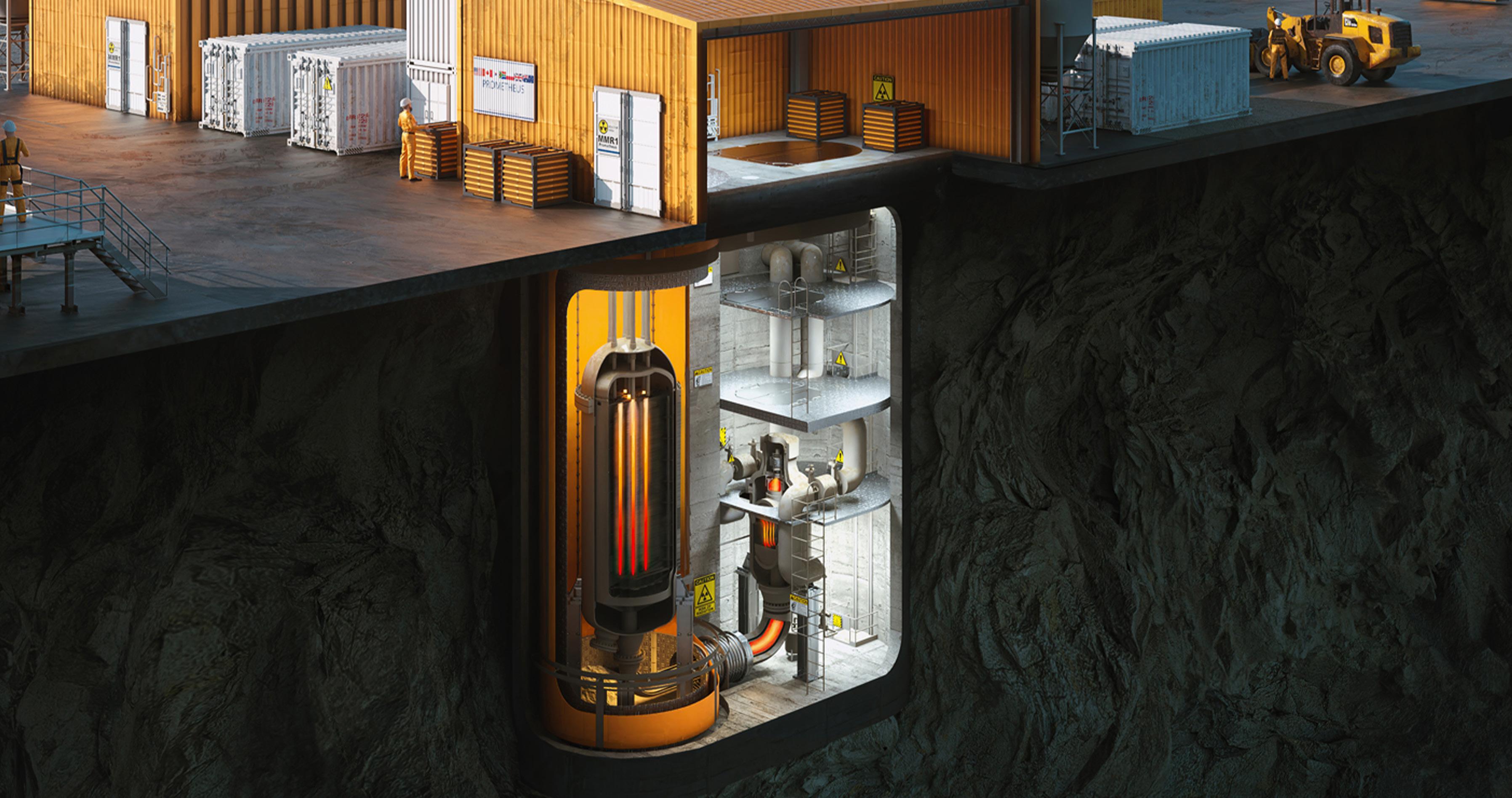
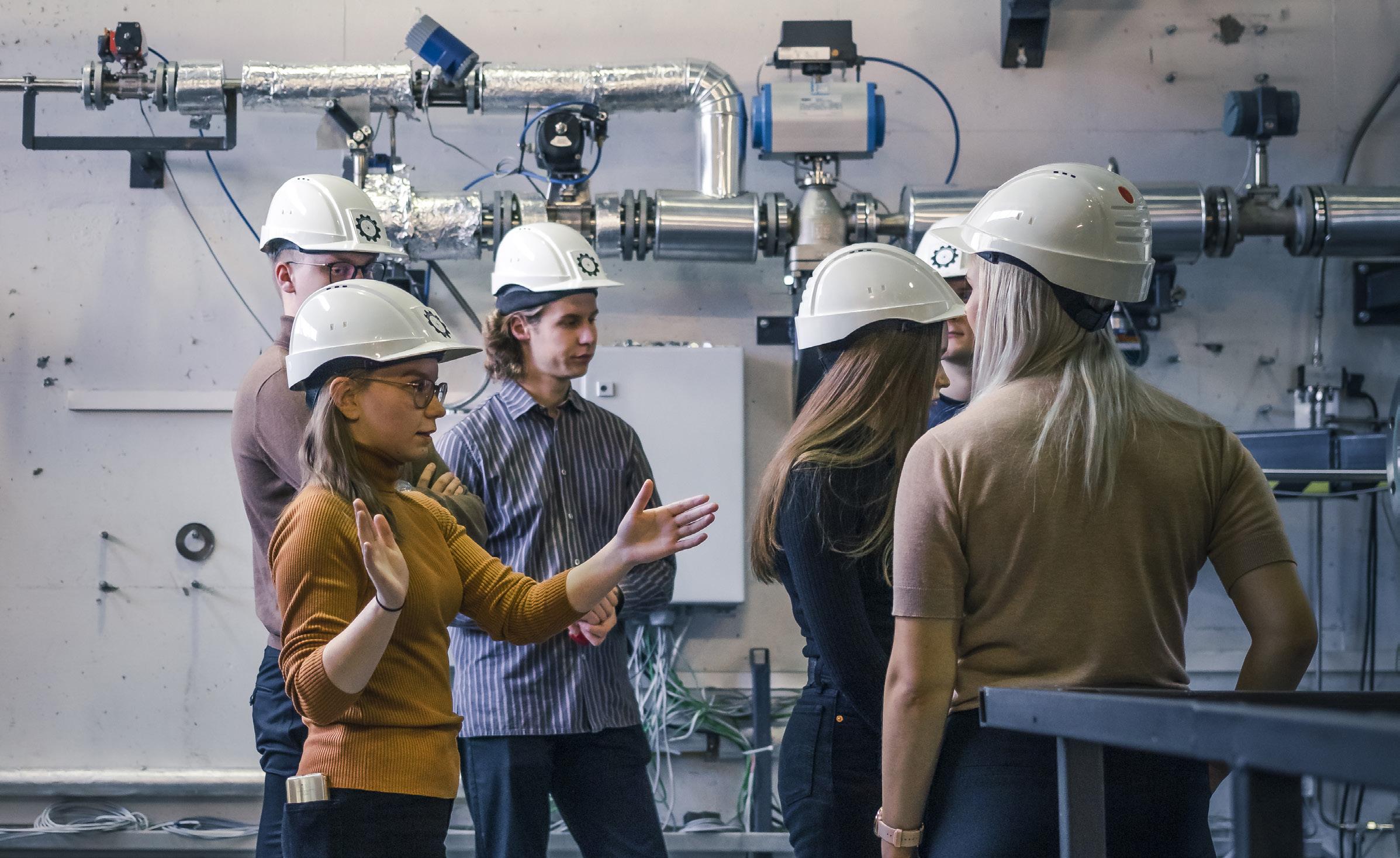
per plant) (World Nuclear News 2023d) being developed in France. In Finland, Fortum and Outokumpu are looking into ways to utilise SMRs to reduce carbon dioxide emissions from steel production (Outokumpu 2023). Fortum is also discussing the use of SMRs with Helsingin Energia Helen (Helen 2022) and the reactor manufacturer Rolls Royce (Fortum 2023). In Finland, the cities of Helsinki, Kuopio and Tornio have already publicly identified candidate sites for heating reactors or cogeneration nuclear power plants.
Heating accounts for a significant amount of household and industrial energy consumption. SMRs based on conventional technology produce heat at a temperature of roughly 300°C. SMRs can be used for combined electricity and heat production, both connected to the district heating network in residential areas and as an industrial heat source, although the low temperature sets certain restrictions for industrial use. High-temperature gascooled reactors, such as the ones recently commissioned in China (World Nuclear News 2022), reach temperatures of 600–900°C. LUT University and the US technology developer Ultra Safe Nuclear Corporation are looking
into building a 30 MW gas-cooled reactor for research purposes in Lappeenranta (LUT University 2022). The plant unit would be connected to the district heating network, and it could be used to pilot hydrogen production with high-temperature electrolysis. Finland is also developing an LDR-50 reactor purely to produce heat for the district heating network at a temperature of roughly 100°C. The LDR50 reactor is being commercialised by the company Steady Energy (VTT 2023b), which was founded in summer 2023. At the moment, the constructions costs for SMRs have been estimated comparatively high.
Regulations on nuclear energy have been prepared with large nuclear power plants in mind. Therefore, they do not yet take into consideration the special features of small modular reactors, such as serial production or how the reactor’s small size and safety features affect safety distances. Nevertheless, using SMRs in a district heating network requires locating the reactors close to residential areas. Finland’s Nuclear Energy Act and the nuclear safety regulations of the Radiation and Nuclear Safety Authority are currently being amended (STUK 2022). Legislation and regulatory
oversight are being brought up to date. The siting of reactors near residential areas has been allowed, if their safety can be justified (STUK 2024). Nuclear energy has wide-ranging approval in Finland, and the political climate also favours it (Finnish Government 2023).
Growth in wind power capacity in Finland was rapid in 2022, after which it slowed during 2023. According to the Finnish Wind Power Association, 437 new wind turbines installed in 2022 provided a 2,430 MW increase in nominal power (Finnish Wind Power Association 2023a), while the corresponding numbers during the first half of 2023 were 75 new turbines and 439 MW of nominal power increase (Finnish Wind Power Association 2023b). Finnish wind power development in 2022 was also strong on an international scale. At the national level, capacity increased in Finland by 75% as a result of investments totalling EUR 2.9 billion (Finnish Wind Power Association 2023a). Total wind power capacity increased to 5.7 GW by the end of 2022. Finland’s global share of new onshore installations was 4%, which is the same as Sweden, with Germany and India reaching 3% while Spain, France and Poland only accounted for a 2% of share (GWEC 2023). Global leader
China installed 47% and the US 13% of the world’s new onshore capacity in 2022 (GWEC 2023). It is worth mentioning that Finland set a global record in onshore wind power installations in 2022.
Wind power accounted for 16.7% of total Finnish power production in 2022 and remained at the same level in Q1/2023 (Statistic Finland 2023b). This indicates that new installations in 2023 were scheduled for the spring and summer rather than the winter months.
The technology development has also been clear. Wind speed increases exponentially with height and a wind turbine’s production is proportional to the cube of the wind speed. This has led to the construction of higher towers. Over the past 15 years, tower height has increased from 100 to 200 meters. A higher tower also makes it possible to increase the rotor diameter and rotor swept area, which further increases production because a wind turbine’s nominal power is directly proportional to the rotor swept area. Statistics from the Finnish Wind Power Association show that the average turbine power has increased from 4.33 MW in 2019 to 5.56 MW in 2022 (Finnish Wind Power Association 2023a). This 28% increase in swept area requires an average increase of
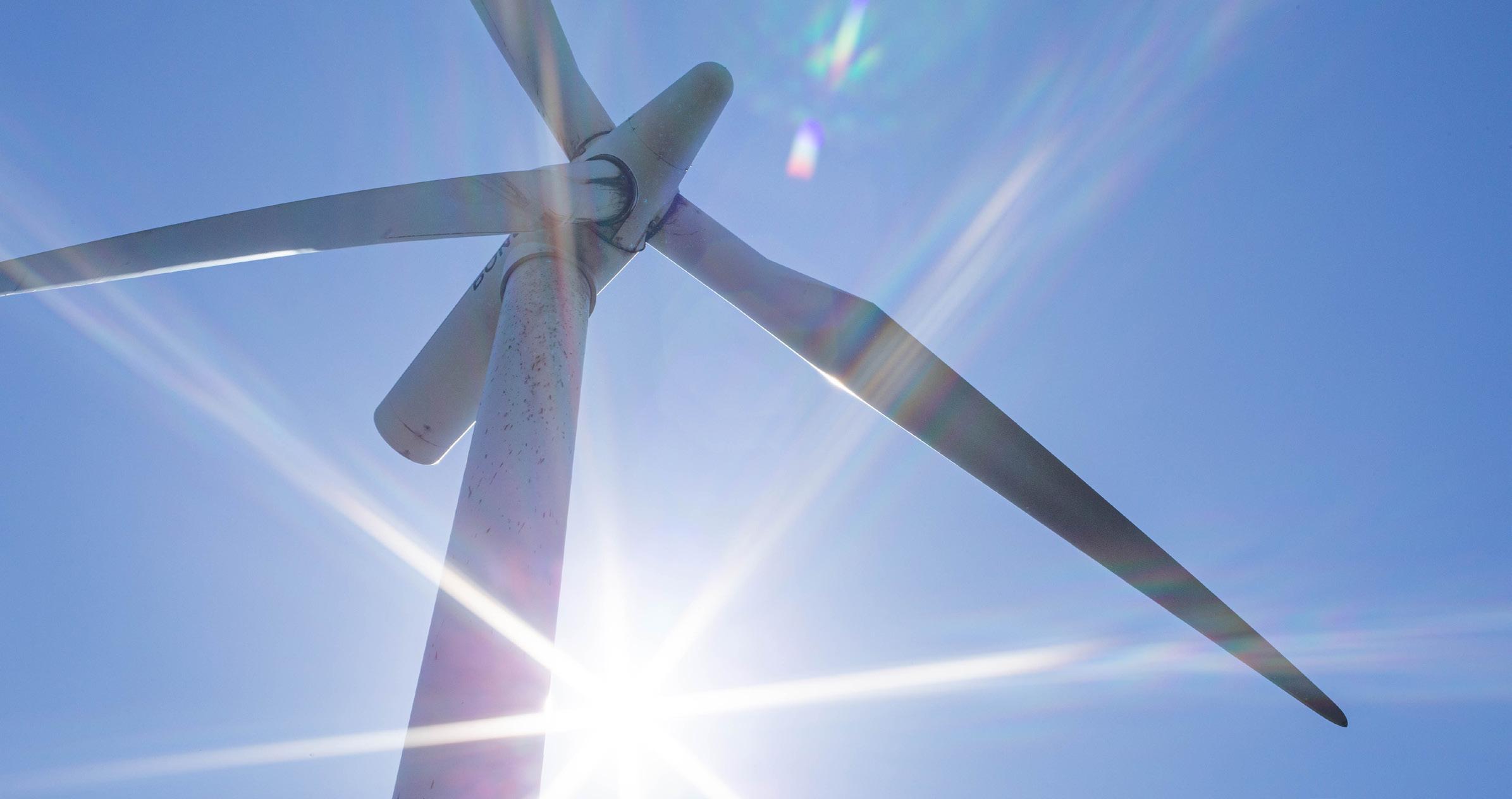
about 13% in turbine rotor diameter. Larger rotors and higher towers require more space and greater distances from residential sites, which must be considered in the permit process and also has an impact on social acceptance. The energy yield of larger turbines is better, since they access higher wind speeds at higher altitudes. This makes it possible to achieve a lower production cost.
The increased share of wind power creates challenges in power transmission and power markets. Production and consumption must be balanced in the power system at all times. Wind power production can be decreased but not increased, since wind conditions define the maximum available power. It is apparent that the electricity price is becoming more dependent on wind conditions due to the increased share of wind power. However, this is not the only factor influencing electricity prices, as for example the very high electricity prices in winter 2022-23 was caused by the sudden halt in electricity import from Russia (see further information about electricity price formation in section 5).
Finland is a relatively large country, where wind conditions vary in different regions. However, most of the wind power installations are currently located in the western part of the country. This has caused two serious challenges for the power system. The first is that capacity in the power system is always limited. In many areas of western Finland, connection of new wind power to the transmission grid and 400 kV substations is temporarily restricted (FingridVerkkokiikari). Secondly, since most wind farms are located in the same geographical areas, the availability of generated power is the same; this means that generation peaks and shortages exist at the same time. It would be beneficial to distribute wind power production over a large geographical area to filter and even out rapid changes in nation-wide wind power production and ease the allocation and operation of transmission capacity. Very few wind farms have been built in the eastern or southern part of the country (east of Highway 5) due to current limitations set by military radar surveillance. The government appointed Lieutenant General Arto Räty to investigate the radar problem. His report (Räty 2023) lists several possible actions
for improving wind power investments also in the eastern parts of Finland.
From the power system balancing point of view, wind power intermittency does not require the same level of fast reserve power as large thermal power plants, because wind power production can be predicted with good accuracy 24 hours in advance. However, the short-term stability of the power grid requires more attention. The power system operates in Nordic countries with 50 Hz alternating current and voltage. The synchronism – a frequency of exactly 50 Hz – must be maintained in order for the system to operate reliably. Wind turbines do not create a stable frequency, but synchronise themselves with the existing grid frequency. For that reason, a situation in which most power production is based on wind turbines might induce unstable behaviour throughout the power system. Special attention must therefore be paid to dynamic control and stability of the power system in the presence of increasing wind power, as reported by Fingrid (2022). Frequency control has traditionally been implemented with rapidly controllable hydro- and thermal power plants. One of a new technical solution for fast frequency control is a large battery storage, which can increase or decrease power supply to the grid within one second or less. One example of such storage is the Neoen Lithium-ion battery storage in Lappeenranta. Its purpose is to mitigate grid frequency variation. By the time of commissioning, it was the largest battery storage in the Nordic countries with 30 MW power and 30 MWh energy capacity (Neoen 2020).
Even though installation of wind power in 2023 has slowed in comparison to 2022, there are a large number of new wind farms in the project pipeline. In May 2023, the Finnish Wind Power Association reported (Finnish Wind Power Association 2023c) that a total of 418 wind power projects with 121 GW are currently in different development phases. Thirty-five projects with capacity of 3.4 GW were under construction, while the rest were still in the planning or permit phases. Almost half of the new capacity consists of offshore installations. The huge number of wind power projects indicates that Finland has great potential to deliver power to replace fossil energy.
A full terawattpeak of solar electricity globally was installed for the first time in March 2022, and the second similar capacity peak is expected within the next three years. The development of the solar capacity significantly affects the price of solar power systems: based on the mass production learning rate curve, price drops by 20% as capacity doubles. The technological development of solar modules has advanced considerably due to, among other things, rapid improvements in module efficiency. A mainstream module was producing 250 Wp in 2015, while in 2022 it was already 360 Wp with the same surface area. The technological advancements of solar modules can be followed from Clean Energy Review webpage. Advancements are also taking place in solar inverters, where new silicon carbidebased power electronics are being applied. Due to the increase in power density, a weight-topower ratio of 0.25 kg/kW – roughly 100 times smaller than in solar inverters three decades ago – can already be achieved by 400 kW solar inverter (PV Magazine 2023).
Since 2019, the solar electricity capacity connected to the Finnish electricity grid has increased by about 100 megawatts annually. In 2022, the growth in solar electricity capacity more than doubled because of an exceptional surge in electricity prices. According to the Energy Authority (2023d), solar power production in Finland amounted to roughly
635 megawattpeaks in 2022, representing an increase of over 240 megawatts from 2021. The share of solar power in Finnish electricity production is approaching 1%, and this continues to grow. Fingrid (2023b) estimates that Finland may have a solar electricity production capacity of seven gigawattpeaks by 2030. However, Finland still has relatively little solar electricity production compared to leading European countries. For example, the per capita solar electricity capacity in the Netherlands at the end of 2022 was nine times that of Finland (IEA 2022c). Even though solar electricity production capacity in Finland is still limited, the significant amount of solar electricity produced in Europe has also had ripple effects on the Finnish electricity market in the form of low-cost afternoon electricity. Therefore, in contrast to previous years, the price of afternoon electricity in Finland has been negative on several occasions. A record low was reached in Finland on Sunday 16 July 2023 between 15:00 and 16:00, when the tax-free wholesale electricity price dropped below −60 euros per megawatt hour (−6 cents/kWh). The Netherlands has even seen electricity prices of -400 euros per megawatt hour (PZEM 2023).
In contrast to previous years, there are now plans in Finland to set up several individual solar farms with capacities of several hundred megawatts. In practice, these planned utility-scale plants will be located near the main electricity grid for cost efficiency reasons. The plants will be installed
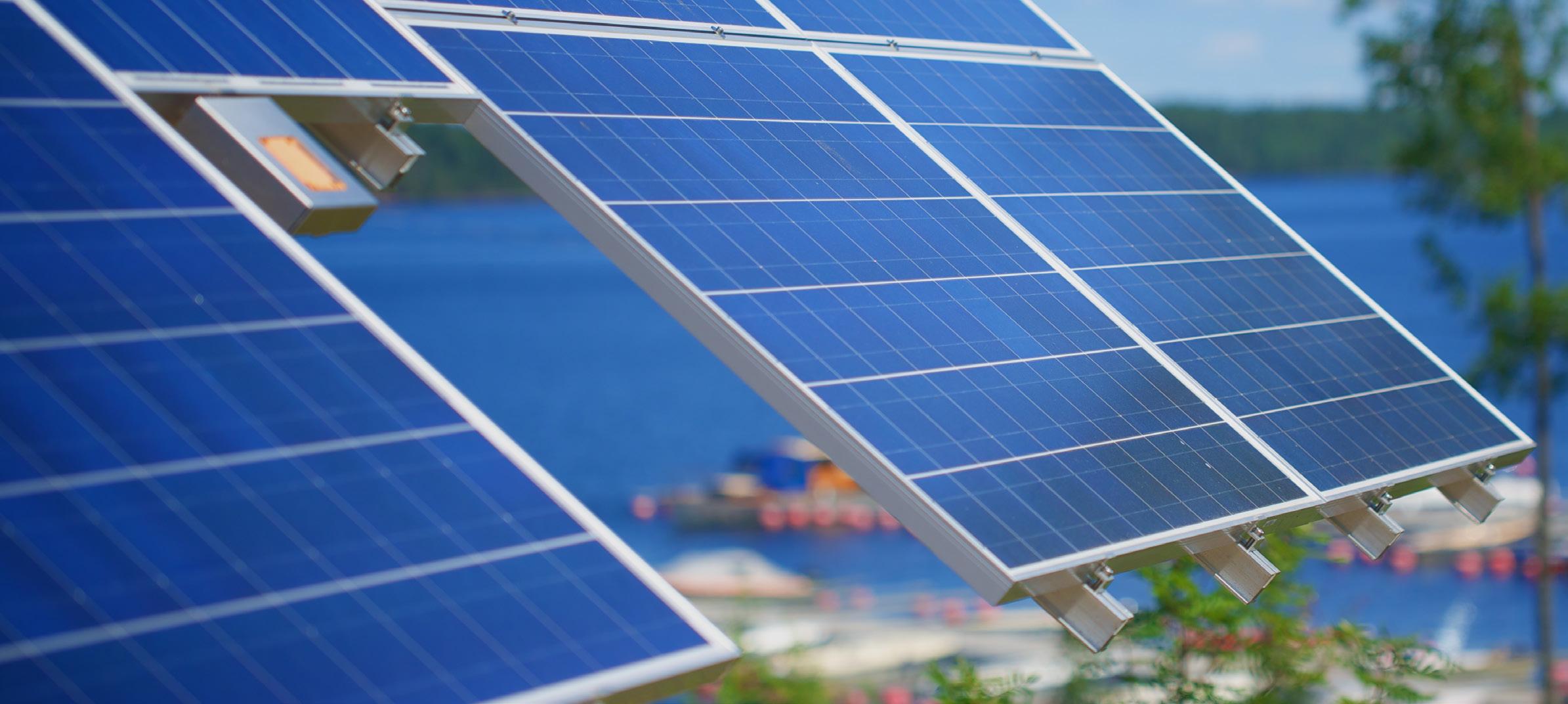
on the ground mounted systems and will need land areas where construction is cost-efficient. Renting land for the purpose may bring municipalities and landowners significant rental income. As opposed to building-integrated photovoltaics, industrial projects have provoked extensive debate among nearby residents. The profitability of industrial plants meant solely for electricity production depends purely on the electricity market price, whereas that of building-integrated photovoltaics depends on the overall price of electricity. However, rising interest rates, inflation and declining electricity prices have decreased the inspiration of many private citizens to install solar photovoltaic systems in 2023.
Safe and up-to-requirement installations have become a burning issue as the number of integrated systems has increased. The rapid growth in demand has led to a shortage of skilled installers. According to the Finnish Safety and Chemical Agency (2023), shortcomings or clear errors were found in a significant number of solar photovoltaic installations. Another noteworthy matter is the fire safety of the systems. For that purpose, the network of Finnish rescue departments has prepared separate fire safety guidelines (Pelastuslaitokset 2023). A third issue to consider are the possible guidelines of insurance companies, which need to be taken into account in solar photovoltaic installations.
6.1.5 Heat pumps (and geothermal)
Heat pumps play a significant role in reducing emissions from heat production and the use of fossil energy sources. In 2022, the IEA estimated that heat pumps could reduce carbon dioxide emissions by 500 million tonnes in 2030 (IEA 2022d). Heat pump technologies have advanced, and both residential- and industrialscale heat pumps have become more efficient in recent years. Another advantage of heat pumps is their ability to utilise different heat sources, such as geothermal heat, heat from the atmosphere, and various waste heat flows that are uneconomical and too difficult for other technologies to utilise directly as thermal energy due to their low temperature levels. In addition, the use of heat pumps for cooling and large fluctuations in electricity prices are providing greater possibilities to utilise heat
pumps as demand response for electricity. The use of heat pumps can also improve the energy self-sufficiency of different countries by reducing the need for heating based on imported fossil fuels.
In 2021, heat pumps produced roughly 10% of the heating energy of buildings globally, but the number of heat pumps continues to increase strongly, replacing other forms of heating and energy sources at an accelerating pace (IEA 2022d). For example, the role of heat pumps in the Nordic countries greatly surpasses the global level. In Norway, 60% of buildings have been fitted with heat pumps, while in Finland and Sweden, the corresponding figure is over 40%. In Finland alone, 196,000 new heat pumps were sold in 2022 – the majority being air source, air-water, and geothermal heat pumps (SULPU 2023). In the EU, heat pump sales increased by 35% in 2021, and the strong market growth is expected to continue as heat pumps become even more common in countries such as Poland, the Netherlands, Italy and Austria (IEA 2022d).
The possibilities provided by the use of heat pumps have also been understood at industrial plants. Industrial-scale heat pumps can be utilised in, for example, district heating and heat production required by industry. According to a 2016 estimate, heat pumps could profitably cover 75 TWh of the EU’s industrial heat production, whereas the corresponding technical potential is much higher, estimated to be roughly 480 TWh (Wolf and Blesl 2016). Heat pump technology has developed continuously, and the current potential of heat pumps is likely to exceed that estimate. Modern commercial high-temperature heat pumps can achieve temperatures of up to 120–150ºC, which enables industrial steam heating (Wolf and Blesl 2016). In Finland and Sweden, there are already many examples of the use of heat pumps in district heating. In those cases, heat has been collected from sources such as sewage treatment plant effluents or waste heat from data centres, and the temperature then raised with a heat pump and fed into the district heating network. Examples include a heat pump plant Katri Vala in Helsinki, which can produce 126 MW of heat and 80 MW of cooling energy for the Helsinki area district heating network.
The research and development of heat pump technologies focuses on creating increasingly efficient heat pumps and components for them and on achieving greater temperature rises and levels. In addition, the use of cooling agents in heat pumps is leaning more and more towards natural refrigerants (carbon dioxide, ammonia, hydrocarbons). Restrictions on the use of synthetic refrigerants will be set in the near future (such as the EU’s F-gas regulation and PFAS proposal). The heat pump system being built in Esbjerg, Denmark is an example of a modern large-scale heat pump plant that utilises modern compressor technology and a natural refrigerant. Its heating capacity is 50 MW, and it utilises carbon dioxide (MAN Energy Solutions n.d.).
6.2.1 Hydrogen solutions
The role of low-emission hydrogen is expected to grow significantly in the future energy system. Hydrogen is not an energy source. It is an energy carrier and, according to estimates, its direct use only accounts for a small part of total consumption. Other uses for hydrogen include different Power-to-X products –such as chemicals, plastics and adhesives
– which are currently made from fossil oil or gas. Many of the current users of hydrogen, such as producers of biofuels, fertilisers and hydrogen peroxide, are planning to switch from grey (natural gas-based) hydrogen to green hydrogen. If it is mixed with natural gas or biogas, hydrogen can also be a substitute for natural gas in industrial heat production and electricity generation based on fuel cells or gas turbines. Gas turbines and internal combustion engines based on pure or nearly pure hydrogen combustion are also in the research and pilot stages. Fossil-free steel production by means of hydrogen reduction requires large amounts of hydrogen. For example, the steel factory in Raahe would need an electrolyser capacity of roughly 1 GW if it were to switch from coal to hydrogen produced by water electrolysis.
Low-emission hydrogen can be reached via low-emission electricity (green hydrogen), biomass through gasification or fossil coal/gas combined with Carbon Capture and Storage (CCS) (blue hydrogen). Globally, there is strong political momentum for low-emission hydrogen production, but deployment is not taking off as rapidly as would be needed for 1.5°C scenarios. Green hydrogen can currently cost two to four times more than fossil-based hydrogen, see. Fig. 12 (IEA 2023c).

Figure 12. Levelised cost of hydrogen production by technology in 2021, 2022 and in Net Zero Emissions by 2050 (NZE). Scenario in 2030. From IEA Global hydrogen review (IEA 2023c).
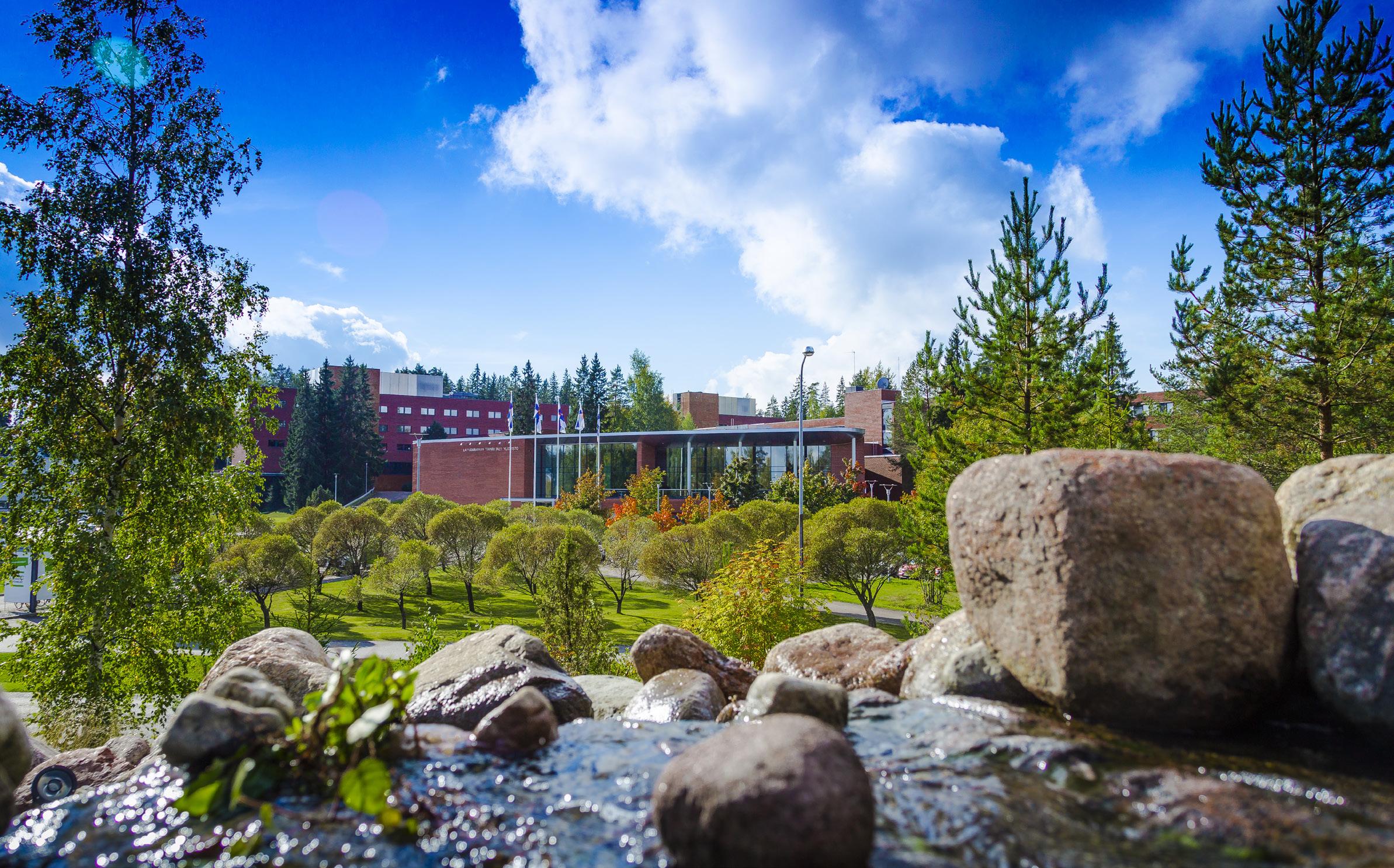
In IRENA’s 1.5°C Scenario, the global lowemission hydrogen targets for 2030 and 2050 are 125 Mt and 523 Mt, respectively (IRENA 2023b). The European Commission estimates that by 2030, Europe will need 500–550 TWh of new renewable electricity capacity to achieve the RePowerEU programme’s target of 10 Mt of domestic green hydrogen production and another 10 Mt of renewable hydrogen imports (EC 2022).
In Finland, the hydrogen has so far mainly been produced from natural gas through steam reforming. The declining availability and rising price of natural gas have accelerated the transition to hydrogen production with water electrolysis. Electrolysis consumes a great deal of electricity (approx. 50 MWh/tH2), and clean hydrogen production requires reasonably priced, zero-carbon electricity.
Rapidly increasing wind power generation and a new nuclear power plant have improved the possibility of producing clean hydrogen in Finland. Fingrid has estimated that Finnish wind power production will reach 60 TWh in 2030, and the realistic production potential is many times greater. Finland has the
opportunity to become an important energy producer in the EU area, and increasing renewable energy is much simpler in Finland than in Central Europe, where a much greater share of the land area has been harnessed for wind and solar power production and electricity generation is still largely based on fossil coal and gas. If Finland produced 10% of the EU’s 2030 target for renewable hydrogen production – in other words, one million tonnes of hydrogen – it would require about 50 TWh of electricity and about 8 GW of installed electrolyser capacity depending on operating hours and system efficiency. Finland’s largest green hydrogen production plant to date is being built in Harjavalta. Its electrolyser capacity will be 20 MW, and it is expected to be operational in 2024. An electrolyser capacity of 8 GW would require 400 equivalent investments by the end of the decade, which means that hydrogen technologies need to be scaled up quickly.
In addition to hydrogen production, there is also a need to develop hydrogen storage and distribution infrastructures. Gasgrid has introduced plans to develop the Finnish hydrogen infrastructure and connect it to the
European system. The first medium-sized hydrogen pipeline is being planned from the Kemira plant in Joutseno to the Ovako steel factory in Imatra (approximately 23 km), where hydrogen has been envisioned to replace natural gas in the heat processing of steel.
Hydrogen storage is challenging, and future uses of hydrogen are based on hydrogen derivatives such as methane and methanol, which are easier to store and transport. However, some of hydrogen’s energy content is lost during the conversion to methanol. Methane and methanol in their current form are directly or nearly directly applicable to many internal combustion engines, and methanol seems to have the most potential for the decarbonisation of maritime transport. Hydrogen can also be used for methanol production or through the Fischer-Tropsch synthesis for other fuel fractions, such as aviation fuel, petrol and diesel.
In addition to hydrogen, fuel synthesis requires a carbon source. This could, for example, be carbon dioxide separated from flue gases produced when using biomass, synthesis gas obtained from biomass by gasification,
or carbon dioxide captured directly from the atmosphere. More information on the carbon cycle and its management is presented in the next section.
Carbon management refers to controlling carbon dioxide emissions from human activity and mitigating climate impacts in different ways. Some methods for the restriction, capture, storage and utilisation of carbon dioxide emissions are based on natural processes and some on technological solutions.
Carbon management actions can be broadly divided into three main pathways: 1) Capture CO2 from emitting plants and permanently store it underground (CCS), 2) Capture CO2 and use it to substitute for fossil-based carbon (CCU) and 3) Carbon Dioxide Removal (CDR) technologies, where the aim is to remove already emitted CO2 from the atmosphere and store it permanently (EC 2024). The different pathways partly utilise the same technologies and infrastructures, but the climate impact may differ depending on the carbon source
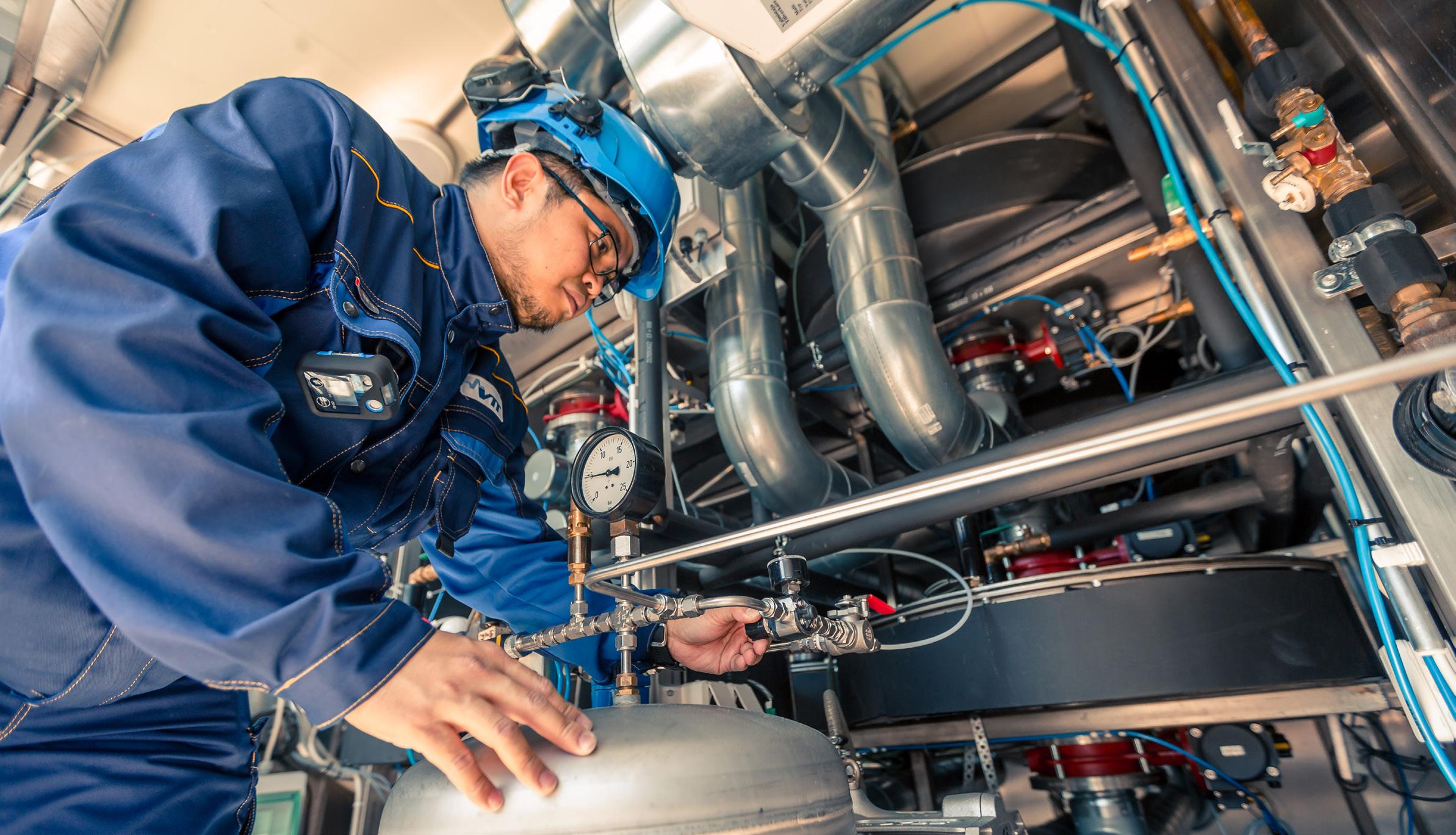
(fossil, biogenic, atmosphere) and use cases (short, long, permanent carbon removal from the carbon cycle).
In the Net-Zero Industry Act, the Commission has proposed that at least 50 million tonnes of CO2 per year can be stored geologically by 2030. Modelling results indicate that approximately 280 million tonnes would have to be captured by 2040 and around 450 Mt/a by 2050 (EC 2024). The scale-up requirement is fast, and the 2050 goal is roughly tenfold compared to current Finnish emissions of approximately 40 MtCO2/a. The current global carbon capture capacity of CCS projects that are in development, under construction or operational is 361 Mt/a (Global CCS Institute 2023). Global CO2 capture capacity is already approaching a relevant scale, but the majority of projects are outside Europe and related to enhanced oil recovery, the climate benefits of which can be questionable.
The most important CDR technologies (technological carbon sinks) are bioenergy with carbon capture and storage (BECCS), direct air capture (DACCS), reforestation, and carbon sequestration in carbonates, wood products, soil, biocarbon, and other long-lasting materials.
For Finland to meet its own climate targets, national and Nordic studies suggest that roughly 4–14 Mt/a of BECCS capacity would be needed between 2035 and 2050 (Kujanpää et al. 2023). Finland’s bio-based emissions from large industrial sources are currently about 24 Mt/a, of which nearly 80% comes from pulp and paper mills. The closest areas suitable for permanent storage are near Norwegian waters. Utilising them would require sufficiently large volumes to reduce transportation and capture costs. Interest in Finland currently seems to focus on biocarbon and the manufacture of various products rather than geological storage.
However, Finland has launched several carbon management and utilisation pilots and profitability surveys in recent years. The Data Dashboard of the Confederation of Finnish Industries (Confederation of Finnish Industries 2023) lists plans for investments such as biocarbon production in Joensuu, Kotka,
Utajärvi and Kerava, green methanol production plants for Kokkola, Ranua and Lappeenranta, and at least nine synthetic methane production plants at different locations in Finland.
The intention has been to carry out carbon capture for the projects above in connection with energy and electricity plants, cement production, and waste incineration plants. Most of the projects announced are of a moderate scale, and there are no guarantees that they will ultimately be realised. The Fortum Carbon2X project is also piloting the utilisation of waste incineration flue gases in the production of plastics, while CarbonAide in Hollola is piloting a concrete manufacturing method that binds carbon dioxide to the product.
Electrical energy can be stored as mechanical, chemical, electromagnetic or heat energy. Energy storages have many uses, including consumer electronics, electric vehicles, industrial reserve capacity, electricity grid stabilisation, and renewable energy storage. The need for storage may be short-term, such as stabilising the grid for seconds or hours, or long-term, such as storing solar energy from day to night or seasonally from summer to winter.
An estimated 200 GW of electricity storage capacity is connected to the electricity grid globally – roughly 90% of it in pumped-storage plants. The capacity of pumped-storage plants is sufficient for storage needs of days, weeks or months. Obstacles to their adoption include a lack of suitable locations and environmental issues. An underground pumped-storage power station with a capacity of 75 MW was planned for the Pyhäsalmi mine in Finland, but it was eventually rejected in 2023 due to the increased investment and financial expenses.
Lithium-ion batteries, which have a market share of about 5% of physical energy storages, are the fastest growing storage technology. The role of other storage technologies, such as compressed air storage, gravitybased mechanical storage, liquefaction- and cryogenics-based energy storage and vanadium flow batteries, is only marginal at this time.
Battery development is driven especially by the electrification of transportation and the automotive industry’s need for vehicle batteries. The annual production of lithium batteries is expected to increase from 200 GWh to 2,000–4,000 GWh by 2030, which would meet the needs of 25–50 million electric vehicles. The amount of energy storages connected to the grid is estimated to remain at 10% of the electric vehicle battery market. The growth of the battery market is restricted mostly by the availability of raw materials and insufficient investments in raw material production. In addition to lithiumion batteries, Chinese companies in particular are investing in sodium-ion battery technology. Its performance is slightly lower, but the raw material base is wider. Once sodium-ion battery technology can be scaled for mass production, it can be expected to become more common in the energy storage market as well.
Lithium battery use is currently dimensioned based on a capacity of 0.5–4.0 hours, which enables battery systems to operate in the
electricity grid’s balancing energy and reserve markets, balance out consumption peaks and function as a short-term energy storage and reserve power. Finland’s largest battery energy storage, with an output of 90 MW, has been built adjacent to the Olkiluoto nuclear power plant to support the electricity grid when plant units are shut down or started up after a shutdown. Lithium batteries and ultracapacitors are deployed alongside hydropower in balancing capacity and reserve power markets, which reduces the maintenance need of the hydropower plants.
Globally, lithium batteries meant for solar power storage typically have a four-hour capacity, which means they last from noon until the afternoon consumption peak. For seasonal storage, hydrogen and hydrogenbased synthetic fuels are mainly suitable, but even that technology is still in its pilot stage and has relatively low round-trip efficiency. Figure 13 provides an overview of different storage technologies presented according to storage capacity and discharge time.


The economy of an energy storage depends on the acquisition cost but also essentially on the number of times it is recharged or discharged, which makes short-term storage systems more profitable. Seasonal storage systems with only a few recharging sessions per year are not financially viable in the current energy market. Many municipalities are now investing in seasonal heat storage in rock caverns, and its profitability is significantly influenced by fluctuations in the price of electricity.
If electric vehicles utilised bidirectional charging that would enable the battery pack to be discharged back into the electricity grid, this would provide significant reserve capacity for the grid. However, seizing that opportunity would require new technology both in cars and in charging stations, sufficient incentives for electric vehicle drivers, and improved battery durability to avoid the shortening of battery life spans due to increased use.
6.2.4 Energy saving and energy efficiency
Energy saving refers to measures that reduce the use of services that consume energy. That can often be done without compromising the service experience of the energy consumer. Practical applications include smart controllable indoor lighting, room temperature control, or carbon dioxide-controlled ventilation. Energy efficiency,
on the other hand, aims to reduce the amount of energy needed for energy services. As concepts, energy saving and energy efficiency do not take a stand on the overall amount of energy services produced. The total energy consumption may increase even if energy saving measures are implemented and energy efficiency improves.
The electrification and digitalisation of the energy system in general promote energy saving and energy efficiency. Due to electrification, energy efficiency will continue to improve especially in transportation, heating and lighting, where current technologies will be replaced with more energy-efficient alternatives. Examples include electric vehicles, heat pumps and LEDs. In industrial applications, increasing the use of pumps, blowers, fans and compressors controlled with frequency converters can continue to improve energy efficiency. Demand response has emerged alongside energy saving and energy efficiency. In an electrical energy system based especially on wind and solar power, the availability and cost of energy depend strongly on the prevailing weather conditions.
At the national level in Finland, energy saving and energy efficiency are controlled by the EU’s energy efficiency directive, which Finland has implemented through its national energy efficiency act. A key tool in promoting energy efficiency and energy saving are the energy
efficiency agreements concluded by industry and communities, which cover about 60% of the total energy consumption in Finland. In the agreements, organisations agree to report on and develop their energy saving mechanisms and energy efficiency, for example, in accordance with their own financial and environmental targets. At the Finnish national level, energy efficiency and energy saving are coordinated by Motiva, a state-owned sustainable development company.
The European Union sets common energy efficiency targets for its member states. The latest Energy Efficiency Directive (EU/2023/1791) more than doubles the annual energy savings obligation. Finland prepares its own legislation based on these targets (EC 2023h). Finland will finalise its actions in National Energy and Climate Plans, which are due for submission to the European Commission in June 2024.
However, the EU EED has faced criticism – even directly from the Finnish Ministry of Trade and Industry. The sore points for Finland include not taking previous achievements or a northern location into account, fixing the final energy consumption, and a lack of legal options to promote energy efficiency.
Finland has long worked to promote energy efficiency, made large reductions in energy use and been the gold standard in the field. Finnish achievements have often surpassed the activities of many other nations. The EU does not take this into account and issues provisions that allow for ‘the same increase despite the starting point’. A typical example is the fact that Finnish houses have been utilising triple-glazed windows for a long time. These are hard to improve upon, whereas many European countries are just starting the push for double-glazing. Achieving the same reduction in household energy use is more expensive in Finland. The mandate to achieve large energy efficiency gains in Finnish buildings is seen as particularly problematic. The push to reuse or preserve old buildings does not help in decreasing overall building energy use. The situation with government and municipal buildings is particularly difficult. If the target is to construct buildings that last 100 years, rebuilding them every 20 years because of new energy efficiency rules is problematic.
From the energy efficiency point of view, mandating a reduction in final energy use looks good. The EU has reduced its final energy use for a number of years now. In the long run, mandating a decrease in final energy consump-

tion means decreasing economic activities related to goods manufacturing in the EU and promoting imports. While switching from petrol to electric cars and improving insulation will decrease final energy consumption, a hydrogen economy will not. Finland aims to make a large amount of eFuels using hydrogen generated from low cost non-fossil electricity and captured biogenic carbon dioxide for export to other EU nations. This activity could add EUR 4,000-9,000 million to national trade by 2050. All this hydrogen economy activity, even if it is supported by EU funds, will increase the final energy consumption and cause Finland to fail in achieving the mandated reduction.
Industry is hesitant to invest in energy efficiency, as 2–3 years of payback time is typically required to make replacement investments feasible. Large energy efficiency gains can often be achieved with investments that have an industrial payback time of 5-9 years. It would be easy to greatly improve Finnish industrial energy efficiency by providing 30% subsidies for industrial investments, but this is prevented by current industrial policy. In contrast, a large subsidy to improve supermarket energy efficiency by installing solar panels on its roof is permitted.
Energy communities are groups of active citizens, small companies, associations – such as housing associations. They often form sitespecific communities that invest in their own distributed energy production, energy efficiency, storage, flexibility or some other type of smart energy solutions. These include installing solar panels, producing heat via different heat pumps, or other types of energy renovations that enhance enew rgy efficiency. The EU is promoting the formation of energy communities that are supported by the EU’s Clean Energy for All package (EC 2019a) and European Green Deal (EC 2019b). The EU included two types of energy communities in the legislation: citizen energy communities, which refers to a group that can be established by members or shareholders to initiate a renewable energy project, and renewable energy communities where there is a requirement for shareholders or members to live in the proximity of the renewable energy installations (EC 2019a). Although the number of energy communities and citizens varies in Europe, Schwanitz et al. (2023) estimated that there are approximately 10,500 citizen-led energy initiatives operating across Europe with 7.2–9.9 GW of installed renewable capacity and over 2 million citizens.

Energy communities, energy citizens, energy producer-consumers so called prosumers and those who offer energy flexibility so called flexumers are expected to promote a more active role for households and individual people in our energy systems. Energy communities are expected to create the following benefits: increase transparency in decision-making, democratise the energy supply, enhance more equal distribution of profits, increase social acceptance of renewable energy, and empower community members by creating jobs and increasing resilience (Bommel and Höffken, 2021). Furthermore, during strong price fluctuations, households that produce their own electricity benefit by not paying the high electricity prices and by receiving a good price for electricity when selling it to the grid.
In Finland, regulations changed at the beginning of 2021 to allow households to distribute energy within communities and amongst citizens. Since the beginning of 2021, net billing has allowed citizens and residents to share and distribute the energy they produce with neighbours living in the same and nearby properties without transmission payments and taxes (Ministry of
Economic Affairs and Employment of Finland 2020). Furthermore, the new National Climate and Energy Strategy (Ministry of Economic Affairs and Employment of Finland 2022: 35) outlines the need to investigate possibilities for new energy community models and promote measures that motivate distributed energy production, micro-generation, and energy efficiency.
Most of the energy communities in Finland are already existing communities, such as housing associations. Approximately one-fourth of the building stock in Finland is housing associations, comprising 90,000 associations (Lukkarinen et al. 2020; 2023) and therefore offer huge potential for energy communities. Energy communities in cities might operate in a challenging environment. Although the environmental goals of cities support the formation of energy communities, the decision-making and planning structures, material requirements and other construction sites in cities can create challenges and tensions regarding the formation of energy communities (Apajalahti & Matschoss 2021; Apajalahti et al. 2023).

Abbasi MH, Taki M, Rajabi A, Li L, Zhang J (2019) Coordinated operation of electric vehicle charging and wind power generation as a virtual power plant: A multi-stage risk constrained approach. Appl Energy 239:1294-1307. https://doi.org/10.1016/j.apenergy.2019.01.238
Abrardi L (2019) Behavioral barriers and the energy efficiency gap: a survey of the literature. J Ind Bus Econ 46:25–43 (2019). https://doi.org/10.1007/s40812-018-0107-z
ACER (2021) ACER’s Preliminary Assessment of Europe’s high energy prices and the current wholesale electricity market design. November 2021. https://acer.europa.eu/sites/default/files/2022-05/ACER%27s%20Preliminary%20Assessment%20of%20Europe%27s%20high%20energy%20prices%20 and%20the%20current%20wholesale%20electricity%20market%20design.pdf
Apajalahti E-L, Matschoss K (2021) Yhteisöenergiaa kaupunkiin: Merihaan merilämpövoimalahanke. Helsinki: Smart Energy Transition publication. Aalto University Publication series CROSSOVER 2/2021
Apajalahti E-L, Ruggiero S, Lukkarinen J, Laakso S (2023) All for one and one for all? Exploring tensions in urban energy communities. In: Sokołowski MM, Visvizi A. Routledge Handbook of Energy Communities and Smart Cities. Routledge. ISBN 9781032247878
Arvesen A, Hertwich EG (2012) Assessing the life cycle environmental impacts of wind power: A review of present knowledge and research needs. Renew Sustain Energy Rev 16:5994–6006. https://doi.org/10.1016/J.RSER.2012.06.023
Asdrubali F, Baldinelli G, D’Alessandro F, Scrucca F (2015) Life cycle assessment of electricity production from renewable energies: Review and results harmonization. Renew Sustain Energy Rev 42:1113–1122. https://doi.org/10.1016/J.RSER.2014.10.082
Ashour Novirdoust A, Bichler M, Bojung C, Buhl HU, Fridgen G, Gretschko V, Hanny L, Knörr J, Maldonado F, Neuhoff K, Neumann C, Ott M, Richstein JC, Rinck M, Schöpf M, Schott P, Sitzmann A, Wagner J, Wagner J, Weibelzahl M (2021) Electricity Spot Market Design 2030-2050. https://doi.org/10.24406/ FIT-N-621457
Aurinkoenergiayhdistys (2023) Uutiset. https://sary.fi/ajankohtaista/uutiset (29 September 2023, date last accessed).
Azzuni A, Breyer C (2020) Global Energy Security Index and its application on national level. Energies 13:2502. https://doi.org/10.3390/en13102502
Bertsch J, Brown T, Hagspiel S, Just L (2017) The relevance of grid expansion under zonal markets. Energy J 38:129152. https://doi.org/10.5547/01956574.38.5.jber
Biogas plants in a map (2024) https://www.google.com/maps/d/u/0viewer?mid= 1ZHpWSB6Av2QQlZSGySCriDCW7piuXnBM&ll=63.56529399131587%2C27.660860650938588&z=6 (7.4.2024)
van Bommel N, Höffken JI (2021) Energy justice within, between and beyond European community energy initiatives: A review. Energy Res Soc Sci 79:102157. https://doi.org/10.1016/j.erss.2021.102157
Bruckner T, Bashmakov IA, Mulugetta Y, Chum H, de la Vega Navarro A, Edmonds J, Faaij A, Fungtammasan B, Garg A, Hertwich E, Honnery D, Infield D, Kainuma M, Khennas S, Kim S, Nimir HB, Riahi K, Strachan N, Wiser R, Zhang X (2014) Energy Systems. In: Climate Change 2014: Mitigation of Climate Change. Contribution of Working Group III to the Fifth Assessment Report of the Intergovernmental Panel on Climate Change [Edenhofer O, Pichs-Madruga R, Sokona Y, Farahani E, Kadner S, Seyboth K, Adler A, Baum I, Brunner S, Eickemeier P, Kriemann B, Savolainen J, Schlömer S, von Stechow C, Zwickel T, Minx JC (eds.)]. Cambridge University Press, Cambridge, United Kingdom and New York, NY, USA
Buttler A, Spliethoff H (2018) Current status of water electrolysis for energy storage, grid balancing and sector coupling via power-to-gas and power-toliquids: A review. Renew Sust Energ Rev 82(part3):2440-2454. https://doi.org/10.1016/j.rser.2017.09.003
Clean Energy Review (n.d.) Most efficient solar panels 2024. https://www.cleanenergyreviews.info/blog/most-efficient-solar-panels
Confederation of Finnish Industries (2023) The Data Dashboard. https://ek.fi/en/
Corona L, Mochon A, Saez Y (2022) Electricity market integration and impact of renewable energy sources in the Central Western Europe region: Evolution since the implementation of the Flow-Based Market Coupling mechanism. Energy Reports 8:1768–1788. https://doi.org/10.1016/j. egyr.2021.12.077
Cramton P (2017) Electricity market design. Ox Rev Econ Policy 33(4):589–612. https://doi.org/10.1093/oxrep/grx041
Dai K, Bergot A, Liang C, Xiang W-N, Huang Z (2015) Environmental issues associated with wind energy – A review. Ren Energy 75:911–921. https://doi. org/10.1016/j.renene.2014.10.074
Dhar A, Naeth MA, Jennings PD, Gamal El-Din M (2020) Perspectives on environmental impacts and a land reclamation strategy for solar and wind energy systems. Sci Total Environ 718:134602. https://doi.org/10.1016/j.scitotenv.2019.134602
Dohm R, Drake D (2019) Wind energy effects on birds. In: Moorman CE, Grodsky SM, Rupp SP (eds) Renewable energy and wildlife conservation. John Hopkins University Press, p 95–121
EC (2005) Directive 2005/89/EC of the European Parliament and of the Council of 18 January 2006 concerning measures to safeguard security of electricity supply and infrastructure investment. http://data.europa.eu/eli/dir/2005/89/oj
EC (2019a) European Commission, Directorate-General for Energy, Clean energy for all Europeans, Publications Office.
https://data.europa.eu/doi/10.2833/9937
EC (2019b) European Commission, Communication from the Commission. The European Green Deal. COM(2019) 640 final. https://eur-lex.europa.eu/legal-content/EN/TXT/?uri=COM:2019:640:FIN
EC (2020) European Commission, Launching the Just Transition Mechanism - for a green transition based on solidarity and fairness. https://ec.europa. eu/info/news/launching-just-transition-mechanism-green-transition-based-solidarity-and-fairness-2020-jan-15_pl
EC (2021) European Commission, Communication from the Commission to the European Parliament, The European Council, The Council, The European Economic and Social Committee and the Committee of the Regions. Tackling rising energy prices: A toolbox for action and support. COM(2021) 660 final. Technical Report, Brussels, Belgium.
EC (2022) European Commission, Communication from the commission to the European Parliament, the European Council, the Council, the European economic an social committee and the Committee of the Regions, REPowerEU Plan. COM/2022/230 final
EC (2023) Directive (EU) 2023/1791 of the European Parliament and of the Council of 13 September 2023 on energy efficiency and amending Regulation (EU) 2023/955 (recast). https://eur-lex.europa.eu/legal-content/EN/TXT/?uri=OJ%3AJOL_2023_231_R_0001
EC (2024) European Commission, EU Industrial Carbon Management Strategy. Questions and Answers on the EU Industrial Carbon Management Strategy. https://ec.europa.eu/commission/presscorner/detail/en/qanda_24_586
Ecoinvent (2019) Ecoinvent 3.6 life cycle inventory database. https://ecoinvent.org/the-ecoinvent-database/data-releases/ecoinvent-3-6/ EDF (2024) Nuclear new built projects. https://www.edfenergy.com/energy/nuclear-new-build-projects
Finnish Energy (2023) Report on the employment effects of energy sector. Gaia Consulting. (only in Finnish) https://energia.fi/julkaisut/selvitys-energiateollisuuden-tyollisyysvaikutuksista/ and report: https://energia.fi/files/5827/Energiateollisuuden_tyollisyys_-_Loppuraportti_12.3.2021.pdf
Energy Taxation (n.d.) Valtiovarainministeriö. Retrieved June 13, 2023, from https://vm.fi/energiaverotus
Energy Authority (2023a) National Report on the state electricity and gas markets in Finland to the Agency for the Cooperation of Energy Regulators and to the European Commission. 2757/040800/2023 12.7.2023. https://energiavirasto.fi/documents/11120570/13026619/ National+Report+on+electrcity+and+gas+markets+in+2022+in+Finland+20230712.pdf/f2ad1a51-a453-0979-8fbd-2e1d4e00672d/ National+Report+on+electrcity+and+gas+markets+in+2022+in+Finland+20230712.pdf?t=16892
Energy Authority (2023b) Pörssihintaisten sähkösopimusten osuus nousi lähes 14 prosenttiin vuonna 2022. 30.6.2023 (only in Finnish). https:// energiavirasto.fi/-/porssihintaisten-sahkosopimusten-osuus-nousi-lahes-14-prosenttiin-vuonna-2022
Energy Authority (2023c) Risk Preparedness Plan of Finland. https://energiavirasto.fi/documents/11120570/12722768/Risk+Preparedness+Plan+of+Finland+public.pdf/e4c9880b-e8cb-f5aa-dfb0-597b0ad2ea33/ Risk+Preparedness+Plan+of+Finland+public.pdf?t=1675325213136
Energy Authority (2023d) Production of solar micro generation grew rapidly in 2022. News 15.6.2023. https://energiavirasto.fi/-/aurinkosahkon-pientuotanto-kasvoi-voimakkaasti-vuonna-2022
Energy Market Act (2013) Sähkömarkkinalaki 9.8.2013/588 (only in Finnish) https://www.finlex.fi/fi/laki/ajantasa/2013/20130588
European Union (2007) Founding agreements. https://european-union.europa.eu/principles-countries-history/principles-and-values/founding-agreements_en https://european-union.europa.eu/principles-countries-history/principles-and-values/founding-agreements_fi Eurostat (2022) Translate Energy consumption in households. https://ec.europa.eu/eurostat/statistics-explained/index.php?title=Energy_consumption_ in_households
Fan X, Liu B, Liu J, Ding J, Han X, Deng Y, et al. (2020) Battery Technologies for Grid-Level Large-Scale Electrical Energy Storage. Trans Tianjin Univ 26:92-103. https://doi.org/10.1007/s12209-019-00231-w
Felling T, Weber C (2018) Consistent and robust delimitation of price zones under uncertainty with an application to Central Western Europe. Energy Economics 75:583–601. https://doi.org/10.1016/j.eneco.2018.09.012
Fingrid (2022) Frequency quality analysis 2022. https://www.fingrid.fi/en/grid/power-transmission/maintenance-of-power-balance/ Fingrid (2023a) Questions and answers about electricity shortages. https://www.fingrid.fi/en/grid/information-regarding-electricity-shortages/questions-and-answers-about-electricity-shortages/ Fingrid (2023b) Offshore wind power and solar power plants gain momentum. https://www.fingridlehti.fi/en/offshore-wind-power-and-solar-power-plants-gain-momentum/ Fingrid (n.d.-a) Johdanto sähkömarkkinoihin. Retrieved January 18, 2023, from https://www.fingrid.fi/sahkomarkkinat/markkinoiden-yhtenaisyys/johdanto-sahkomarkkinoihin/#paivansisaiset-markkinat Fingrid (n.d.-b) Reserves and balancing power.
https://www.fingrid.fi/en/electricity-market/reserves_and_balancing/ (accessed 9.4.2024) Fingrid-Verkkokiikari. https://www.fingrid.fi/en/grid/grid-connection-agreement-phases/grid-scope/ Finnish Wind Power Association (2020) Capacity factors of wind turbines installed in Finland 2011–2018. https://tuulivoimayhdistys.fi/en/ajankohtaista/publications/capacity-factors-2019
Finnish Wind Power Association (2021) Dismantling and recycling wind power plants (in Finnish). https://tuulivoimayhdistys.fi/tietoa-tuulivoimasta-2/tietopankki/tuulivoimaloiden-purku-ja-kierratys
Finnish Environment Institute (2023) Ympäristön tila nettiraportti. https://www.ymparisto.fi/fi/ympariston-tila/kiertotalous/luonnonvarojen-kaytto
Finnish Government (2023) A strong and committed Finland: Programme of Prime Minister Petteri Orpo’s Government 20 June 2023. Publications of Finnish Government 2023:60. http://urn.fi/URN:ISBN:978-952-383-763-8
Fortum (2022) Fortum käynnistää selvityksen uuden ydinvoiman tulevaisuuden edellytyksistä. https://www.fortum.fi/media/2022/10/fortum-kaynnistaa-selvityksen-uuden-ydinvoiman-tulevaisuuden-edellytyksista
Fortum (2023) Fortum and Rolls-Royce SMR to explore joint opportunities for SMRs in Finland and Sweden. https://www.fortum.com/media/2023/03/fortum-and-rolls-royce-smr-explore-joint-opportunities-smrs-finland-and-sweden
Gallop P, Gray E, Nikolovska E, Mustață A, Petcu R (2021) The Political Economy of Energy Transition in Southeast Europe – Barriers and Obstacles. Friedrich Ebert Stifung and CEE Bankwatch Network.
Gasparatos A, Doll CNH, Esteban M, Ahmed A, Olang TA (2017) Renewable energy and biodiversity: Implications for transitioning to a Green Economy. Renewable Sustainable Energy Rev 70:161–184. https://doi.org/10.1016/j.rser.2016.08.030
Giddings B, Hopwood B, O’Brien G (2002) Environment, economy and society: fitting them together into sustainable development. Sustainable Development 10:187–196
Global CCS Institute (2023) Global Status of CCS Report 2023. https://status23.globalccsinstitute.com/ (accessed 9.4.2024)
Grodsky SM, Fritts SR and Hernandez RR (2019) Renewable energy ecology, the next frontier in wildlife science. In: Moorman CE, Grodsky SM, Rupp SP (eds) Renewable energy and wildlife conservation. John Hopkins University Press, p 247–260
Grossman PZ (2015) Energy shocks, crises and the policy process: A review of theory and application. Energy Policy 77, 56–69. Available at: https://doi. org/10.1016/j.enpol.2014.11.031
GSDR (2023) Times of crisis, times of change: Science for accelerating transformations to sustainable development. Global Sustainable Development Report written by independent group of scientists appointed by the Secretary-General of the United Nations. https://sdgs.un.org/gsdr/gsdr2023 (accessed 2.10.2023)
Guzmán H, Salomone F, Batuecas E, Tommasi T, Russo N, Bensaid S, Hernández S (2021) How to make sustainable CO2 conversion to Methanol: Thermocatalytic versus electrocatalytic technology. J Chem Eng 417:127973. https://doi.org/10.1016/j.cej.2020.127973
GWEC (2023) Global wind power report. https:/gwec.net/wp-content/uploads/2023/04/GWEC-2023_interactive.pdf
Hach D, Chyong CK, Spinler S (2016) Capacity market design options: A dynamic capacity investment model and a GB case study. Eur J Oper Res 249(2):691–705. https://doi.org/10.1016/j.ejor.2015.08.034
Hanski I (2015) Habitat fragmentation and species richness. J Biogeogr 42:989–994. https://doi.org/10.1111/jbi.12478
Hein CD, Hale AM (2019) Wind energy effects on bats. In: Moorman CE, Grodsky SM and Rupp SP (eds) Renewable energy and wildlife conservation. John Hopkins University Press, p 122–145
Heiskanen E, Apajalahti E-L, Matschoss K, Lovio R (2018) Incumbent energy companies navigating energy transitions: strategic action or bricolage? Environmental Innovation and Societal Transitions 28, 57-69.
Helen (2022) Helen and Fortum are looking into potential SMR cooperation. Media reliese 22.11.2022. https://www.helen.fi/en/news/2022/helen-and-fortum-are-looking-into-potential-smr-cooperation
Heinänen S, Žydelis R, Kleinschmidt B, Dorsch M, Burger C, Morkūnas J, Quillfeldt P, Nehls G (2020) Satellite telemetry and digital aerial surveys show strong displacement of red-throated divers (Gavia stellata) from offshore wind farms. Mar Environ Res 160. https://doi.org/10.1016/j. marenvres.2020.104989
Hernandez RR, Easter SB, Murphy-Mariscal ML, Maestre FT, Tavassoli M, Allen EB, Barrows CW, Belnap J, Ochoa-Hueso R, Ravi R, Allen MF (2014) Environmental impacts of utility-scale solar energy. Renewable Sustainable Energy Rev 29:766–779. https://doi.org/10.1016/j.rser.2013.08.041
Hertwich EG, Gibon T, Bouman EA, Arvesen A, Suh S, Heath GA, Bergesen JD, Ramirez A, Vega MI, Shi L (2015) Integrated life-cycle assessment of electricity-supply scenarios confirms global environmental benefit of low-carbon technologies. PNAS 112:6277–6282. https://doi.org/10.1073/ PNAS.1312753111/-/DCSUPPLEMENTAL
Hodge S, Jain H, Brancucci C, Seo G, Korpås M, Kiviluoma J, Holttinen H, Smith J, Orths A, Estanqueiro A, Söder L, Flynn D, Vrana T, Kenyon R, Kroposki B (2020) Addressing technical challenges in 100% variable inverter-based renewable energy power systems. WIREs Energy and Environment 9(5). https://doi.org/10.1002/wene.376
Honkapuro S, Jaanto J, Annala S (2023) A Systematic Review of European Electricity Market Design Options. Energies 16(9). https://doi.org/10.3390/en16093704
Hyvärinen E, Juslén A, Kemppainen E, Uddström A, Liukko U-M (eds) (2019) Suomen lajien uhanalaisuus – Punainen kirja 2019. Ympäristöministeriö & Suomen ympäristökeskus. Helsinki. 704 pp.
IEA (2016) Re-powering Markets—Market design and regulation during the transition to low carbon power systems.
IEA (2021) Net Zero by 2050 A Roadmap for the Global Energy Sector. https://iea.blob.core.windows.net/assets/deebef5d-0c34-4539-9d0c10b13d840027/NetZeroby2050-ARoadmapfortheGlobalEnergySector_CORR.pdf
IEA (2022a) For the first time in decades, the number of people without access to electricity is set to increase in 2022. IEA, Paris. https://www.iea.org/ commentaries/for-the-first-time-in-decades-the-number-of-people-without-access-to-electricity-is-set-to-increase-in-2022
IEA (2022b) World Energy Employment. Updated in August 2022. https://www.iea.org/reports/world-energy-employment/overview
IEA (2022c) Snapshot of Global PV Markets 2022. https://iea-pvps.org/snapshot-reports/snapshot-2022/
IEA (2022d) The Future of Heat Pumps - World Energy Outlook Special Report, 2022., https://iea.blob.core.windows.net/assets/4713780d-c0ae-4686-8c9b-29e782452695/TheFutureofHeatPumps.pdf
IEA (2023a) Emergency response and energy security - Ensuring the uninterrupted availability of energy sources at an affordable price. https://www.iea. org/about/emergency-response-and-energy-security, (accessed 9.4.2024)
IEA (2023b) Energy Technology Perspectives 2023. https://www.iea.org/reports/energy-technology-perspectives-2023 (accessed 4.1.2024)
IEA (2023c) Global Hydrogen Review 2023. https://www.iea.org/reports/global-hydrogen-review-2023, (accessed 10.4.2024).
IEA (2023d) World Energy Outlook. https://iea.blob.core.windows.net/assets/86ede39e-4436-42d7-ba2a-edf61467e070/WorldEnergyOutlook2023.pdf
IEA (2023e) Net Zero Roadmap: A Global Pathway to Keep the 1.5 °C Goal in Reach. https://iea.blob.core.windows.net/assets/9a698da4-4002-4e538ef3-631d8971bf84/NetZeroRoadmap_AGlobalPathwaytoKeepthe1.5CGoalinReach-2023Update.pdf
IEA (2023f) Finland 2023 – Energy Policy Review. https://www.iea.org/reports/finland-2023
Ioannidis R, Koutsoyiannis D (2020) A review of land use, visibility and public perception of renewable energy in the context of landscape impact. Applied Energy 276:115367. https://doi.org/10.1016/j.apenergy.2020.115367
IPCC (2022) Climate Change 2022: Mitigation of Climate Change. Contribution of Working Group III to the Sixth Assessment Report of the Intergovernmental Panel on Climate Change [Shukla PR, Skea J, Slade R, Al Khourdajie A, van Diemen R, McCollum D, Pathak M, Some S, Vyas P, Fradera R, Belkacemi M, Hasija A, Lisboa G, Luz S, Malley J (eds.)] Cambridge University Press, Cambridge, UK and New York, NY, USA. doi: 10.1017/9781009157926
IRENA (2020) Innovation landscape brief: Community-ownership models, International Renewable Energy Agency, Abu Dhabi https://www.irena.org/-/media/Files/IRENA/Agency/Publication/2020/Jul/IRENA_Community_ownership_2020.pdf
IRENA (2022) Renewable energy and jobs – Annual review 2022. https://www.irena.org/publications/2022/Sep/Renewable-Energy-and-Jobs-Annual-Review-2022
IRENA (2023a) Renewable capacity statistics 2023. International Renewable Energy Agency, Abu Dhabi. https://www.irena.org/Publications/2023/Mar/ Renewable-capacity-statistics-2023
IRENA (2023b) World Energy Transitions Outlook 2023: 1.5°C Pathway. June 2023. https://www.irena.org/Publications/2023/Jun/World-EnergyTransitions-Outlook-2023
Isaacs SA, Staples MD, Allroggen F, Mallapragada DS, Falter CP, Barrett SRH (2021) Environmental and Economic Performance of Hybrid Power-toLiquid and Biomass-to-Liquid Fuel Production in the United States. Environ Sci Technol 55:8247–8257. https://doi.org/10.1021/acs.est.0c07674
Jimenez Iturriza J, Polo L, Beermann M, Lettmayer G, Carrus G, Tiberio L, Biresselioglu ME, Demir MH, Solak B, Dimitrova E et al. (2019) Collective Energy Practices in Europe. ECHOES Project Deliverable 5.4.
Johansson M, Gentile N, Neij L (2021) Energy efficiency behaviour in the built environment—an assessment of current evaluation practices in the Nordic countries. Energy Efficiency 14:27. https://doi.org/10.1007/s12053-021-09938-z
Keles D, Bublitz A, Zimmermann F, Genoese M, Fichtner W (2016) Analysis of design options for the electricity market: The German case. Applied Energy 183:884–901. https://doi.org/10.1016/j.apenergy.2016.08.189
Koltsaklis NE, Dagoumas AS (2018) Incorporating unit commitment aspects to the European electricity markets algorithm: An optimization model for the joint clearing of energy and reserve markets. Applied Energy 231:235–258. https://doi.org/10.1016/j.apenergy.2018.09.098
Kosanic A, Petzold J, Martín-López B, Razanajatovo M (2022) An inclusive future: disabled populations in the context of climate and environmental change. Current Opinion in Environmental Sustainability 55, 101159. https://doi.org/10.1016/j.cosust.2022.101159
Kujanpää L, Reznichenko A, Saastamoinen H, […], Koponen K (2023). Carbon dioxide use and removal.: Prospects and policies. Publification of the goverment’s analysis, assessment and research activities. https://julkaisut.valtioneuvosto.fi/bitstream/handle/10024/164795/VNTEAS_2023_19.pdf?sequence=1&isAllowed=y Lloyd JD, Cameron LA, Taber DA, LeBeau CW, McNew LB, Winder VL (2022) Prairie grouse and wind energy: The state of the science and implications for risk assessment. Wildl Soc Bull 46:e1305. https://doi.org/10.1002/wsb.1305
Łopucki R, Klich D, Gielarek S (2017) Do terrestrial animals avoid the areas close to turbines in the functioning wind farms in agricultural landscapes? Environ Monit Assess 189:343. https://doi.org/10.1007/s10661-017-6018-z
Lukkarinen J, Marttila T, Saarikoski H, Auvinen K, Faehnle M, Hyysalo S, Kangas HL, Lähteenoja S, Peltonen P, Salo M (2020) Taloyhtiöistä tulevaisuuden energiatuottajia – Muutospolut vuoteen 2035 ja murrosareena tiedon yhteistuotannon menetelmänä. Suomen ympäristökeskuksen raportteja 39/2020
Lukkarinen J, Salo M, Faehnle M, Saarikoski H, Hyysalo S, Auvinen K, Lähteenoja S, Marttila T (2023) Citizen energy lost in sustainability transitions: Knowledge co-production in a complex governance context. Energy Res Soc Sci 96. https://doi.org/10.1016/j.erss.2022.102932
Lundin E (2022) Geographic price granularity and investments in wind power: Evidence from a Swedish electricity market splitting reform. Energy Economics 113:106208. https://doi.org/10.1016/j.eneco.2022.106208
LUT (2022a) Towards Carbon Neutral Finland. LUT University Energy Outlook 5/2022. (only in Finnish) https://www.lut.fi/sites/default/files/media/documents/LUT-yliopiston-Energiaselonteko-2022.pdf
LUT (2022b) LUT is planning the first advanced research microreactor in Finland. Media release. https://www.lut.fi/en/news/lut-planning-first-advanced-research-microreactor-finland
the Ministry of Transport and Communications (2021) Roadmap to fossil-free transport Government resolution on reducing domestic transport’s greenhouse gas emissions. Publications of the Ministry of Transport and Communications 2021: 19 Available at [accessed 9.4.2024] https://julkaisut.valtioneuvosto.fi/bitstream/handle/10024/163260/LVM_2021_19.pdf?sequence=1&isAllowed=y MAN Energy Solutions (n.d.) Esbjerg Heat pump, webpage. https://www.man-es.com/discover/esbjerg-heat-pump
Marques AT, Batalha H, Rodriques S, Costa H, Pereire MJR, Fonseca C, Mascarenhas M, Bernardino J (2014) Understanding bird collisions at wind facilities: And updated review on the causes and possible mitigation strategies. Biol Conserv 179:40–52
Meeus L (2020) The Evolution of Electricity Markets in Europe. Edward Elgar Publishing. https://doi.org/10.4337/9781789905472
Mekonnen MM, Gerbens-Leenes PW, Hoekstra AY (2015) The consumptive water footprint of electricity and heat: a global assessment. Environmental Science Water Research & Technology 1, 285-297. DOI: 10.1039/c5ew00026b
Mäkipää R, Abramoff R, Adamczyk B, Baldy V, Biryol C, Bosela M, Casals P, Curiel Yuste J, Dondini M, Filipek S, Garcia-Pausas J, Gros R, Gömöryová E, Hashimoto S, Hassegawa M, Immonen P, Laiho R, Li H, Li Q, Luyssaert S, Menival C, Mori T, Naudts K, Santonja M, Smolander A, Toriyama J, Tupek B, Ubeda X, Verkerk PJ, Lehtonen A (2023) How does management affect soil C sequestration and greenhouse gas fluxes in boreal and temperate forests? – A review. Forest Ecology and Management, 529, 120637. https://doi.org/10.1016/j.foreco.2022.120637
Ministry of Economic Affairs and Employment of Finland (2022) Carbon neutral Finland 2035 – national climate and energy strategy. Publications of the Ministry of Economic Affairs and Employment of Finland 2022:55. https://urn.fi/URN:ISBN:978-952-327-843-1
Ministry of Environment (2016) Linnustovaikutusten arvointi tuulivoimarakentamisessa. Suomen ympäristö 6/2016. https://julkaisut.valtioneuvosto.fi/bitstream/handle/10024/75407/SY_6_2016.pdf?sequence=1&isAllowed=y [accessed 27.9.2023]
Ministry of Environment (2023) Aurinkovoimaloiden kaavoitusta ja lupamenettelyä koskevan oppaan valmistelu. Hankenumero: YM014:00/2023. https:// valtioneuvosto.fi/hanke?tunnus=YM014:00/2023
Ministry of Economic Affairs and Employment of Finland (2023a) Valtioneuvoston periaatepäätös TEM/2023/14. (only in Finnish) https://valtioneuvosto. fi/paatokset/paatos?decisionId=0900908f8080db83
Ministry of Economic Affairs and Employment of Finland (2023b) Energiayhteisöt ja erilliset linjat: Energiayhteisötyöryhmän loppuraportti. (only in Finnish) https://julkaisut.valtioneuvosto.fi/handle/10024/164884
The National Emergency Supply Agency (2021) Kenelle sähköä, kuka jää ilman? 17.11.2021 uutinen. (only in Finnish) https://www.varmuudenvuoksi. fi/artikkeli/kenelle-sahkoa-kuka-jaa-ilman and report: https://www.huoltovarmuuskeskus.fi/files/666549f601a3c73289002e38f78bd04c8dd3bab0/ sahkonkayttopaikkojen-priorisointi-selvitys-270821.pdf
The National Emergency Supply Agency (2023) Energy 2030. https://www.huoltovarmuuskeskus.fi/en/organisation/the-national-emergency-supply-agency/programmes
Nazir MS, Mahdi AJ, Bilal M, Sohail HM, Ali N, Iqbal HMN (2019) Environmental impact and pollution-related challenges of renewable wind energy paradigm – A review. Sci Total Enviro 683:436–444. https://doi.org/10.1016/j.scitotenv.2019.05.274
NER (2023) The Nordic Energy Dilemma. 10 Mar 2023. Nordic Energy Research. Website reference 29.11.2023: https://www.nordicenergy.org/publications/the-nordic-energy-trilemma-security-of-supply-prices-and-just-transition/ Neoen (2020) Neoen builds in Finland the Nordics’ largest battery storage unit. Media release 9.6.2020. https://neoen.com/app/ uploads/2020/06/20200609-neoen-media-release-ypr.pdf
Neumayer E (2003) Weak versus strong sustainability: exploring the limits of two opposing paradigms. Edward Elgar Publishing Limited. UK: Cornwall.
NGDP (2023) Nordic Grid Development Perspective 2023. https://www.fingrid.fi/contentassets/6457e50d0dee45a38d69f709d9cd4c87/svk_ngpd2023_a4_korr4.pdf, Accessed 9.4.2024.
NREL (2021) Life Cycle Greenhouse Gas Emissions from Electricity Generation: Update. https://www.nrel.gov/docs/fy21osti/80580.pdf
OECD (2021) Towards a more resource-efficient and circular economy. The role of the G20. https://www.oecd.org/environment/waste/OECD-G20Towards-a-more-Resource-Efficient-and-Circular-Economy.pdf (accessed 4.1.2023)
Ogilvie M, Rootes C (2015) The Impact of Local Campaigns against Wind Energy Developments. Environmental Politics 24(6). 10.1080/09644016.2015.1063301
Outokumpu (2023) Outokumpu and Fortum partner to accelerate industrial decarbonization in stainless steel production. Media release. https://www.outokumpu.com/en/news/2023/outokumpu-and-fortum-partner-to-accelerate-industrial-decarbonization-in-stainless-steelproduction-3244643
Ovaskainen H (2017) CO2-eq emissions and energy efficiency in forest biomass supply chains – impact of terminals. Metsätehon tuloskalvosarja 4b/2017.
https://metsateho.fi/wp-content/uploads/Tuloskalvosarja_2017_04b_CO2-eq_emissions_and_energy_efficiency_in_forest-biomass.pdf
Pajula T, Vatanen S, Behm K, et al. (2021) Carbon Handprint Guide V. 2.0. Applicable for Environmental Handprint. https://publications.vtt.fi/julkaisut/muut/2021/Carbon_handprint_guide_2021.pdf (23 September 2023, date last accessed)
Pelastuslaitokset (2023) Aurinkosähköjärjestelmien paloturvallisuusohje. Available at https://pelastuslaitokset.fi/sites/default/files/2023-01/Aurinkos%C3%A4hk%C3%B6j%C3%A4rjestelmien_paloturvallisuusohje_S_18012023.pdf PV Magazine (2023). https://www.pv-magazine.com/2023/01/13/brek-unveils-400-kw-silicon-carbide-string-inverter/ PZEM (2023) Difference in production costs between gas and coal-fired power plants is increasing. Marktrapport. 31 May 2023. https://www.pzem.nl/ en/nieuws-en-marktinformatie/difference-in-production-costs-between-gas-and-coal-fired-power-plants-is-increasing/ Pörtner HO, Scholes RJ, Agard J, Archer E, Arneth A, Bai X, Barnes D, Burrows M, Chan L, Cheung WL, Diamond S, Donatti C, Duarte C, Eisenhauer N, Foden W, Gasalla MA, Handa C, Hickler T, Hoegh-Guldberg O, Ichii K, Jacob U, Insarov G, Kiessling W, Leadley P, Leemans R, Levin L, Lim M, Maharaj S, Managi S, Marquet PA, McElwee P, Midgley G, Oberdorff T, Obura D, Osman E, Pandit R, Pascual U, Pires APF, Popp A, Reyes-García V, Sankaran M, Settele J, Shin YJ, Sintayehu DW, Smith P, Steiner N, Strassburg B, Sukumar R, Trisos C, Val AL, Wu J, Aldrian E, Parmesan C, Pichs-Madruga R, Roberts DC, Rogers AD, Díaz S, Fischer M, Hashimoto S, Lavorel S, Wu N, Ngo HT (2021) IPBES-IPCC co-sponsored workshop report on biodiversity and climate change; IPBES and IPCC. DOI:10.5281/zenodo.4782538.
Razon LF, Valera-Medina A (2021) A Comparative Environmental Life Cycle Assessment of the Combustion of Ammonia/Methane Fuels in a Tangential Swirl Burner. Front Chem Eng 3. https://doi.org/10.3389/fceng.2021.631397
Rios-Festner D, Blanco G, Olsina F (2020) Long-term assessment of power capacity incentives by modeling generation investment dynamics under
irreversibility and uncertainty. Energy Policy 137:111185. https://doi.org/10.1016/j.enpol.2019.111185
Rockström J, Gupta J, Qin D et al. (2023) Safe and just Earth system boundaries. Nature 619:102–111. https://doi.org/10.1038/s41586-023-06083-8
Rotger-Griful S, Jacobsen RH, Nguyen D, Sørensen G (2016) Demand response potential of ventilation systems in residential buildings. Energy Build 121:1-10. https://doi.org/10.1016/j.enbuild.2016.03.061
Rothovius T, Nikkinen J, Sihvonen J, Klemola A (2013) Johdannaisten hyödyntäminen energiayhtiön liiketoiminnassa. Loppuraportti. Vaasan yliopiston julkaisuja selvityksiä ja raportteja 193. Vaasan yliopisto – University of Vaasa. https://osuva.uwasa.fi/bitstream/handle/10024/7921/isbn_978-952-476-509-1.pdf
Royapoor M, Pazhoohesh M, Davison PJ, Patsios C, Walker S (2020) Building as a virtual power plant, magnitude and persistence of deferrable loads and human comfort implications. Energy Build 213:109794. https://doi.org/10.1016/j.enbuild.2020.109794
Räty A (2023) Itäisen Suomen tuulivoimarakentamisen tehostaminen. Selvitys 14.3.2023. https://valtioneuvosto.fi/documents/1410877/153287519/Tuulivoimaselvitys_final_AR_150323.pdf/ed8981bb-e8dd-fc65-eeb1-4d999256002c/ Tuulivoimaselvitys_final_AR_150323.pdf?t=1678882585236
Salovaara K, Makkonen M, Gore O, Honkapuro S (2016) Electricity Markets Framework in Neo-Carbon Energy 2050 Scenarios. NEO-CARBON Energy WP1 working paper 3/2016, Lappeenranta University of Technology (LUT), Lappeenranta, Finland.
Sánchez-Navarro S, Gálvez-Ruiz D, Rydell J, Ibáñez C (2023) High Bat Fatality Rates Estimated at Wind Farms in Southern Spain. Acta Chiropterologica, 25(1). https://doi.org/10.3161/15081109ACC2023.25.1.007
Sayed ET, Wilberforce T, Elsaid K, Rabaia MKH, Abdelkareem MA, Chae K-J, Olabi AG (2021) A critical review on environmental impacts of renewable energy systems and mitigation strategies: Wind, hydro, biomass and geothermal. Sci Total Environ 766:144505. https://doi.org/10.1016/j. scitotenv.2020.144505
Schwanitz VJ, Wierling A, Arghandeh Paudler H […] (2023) Statistical evidence for the contribution of citizen-led initiatives and projects to the energy transition in Europe. Sci Rep 13, 1342. https://doi.org/10.1038/s41598-023-28504-4
Sillman J, Hynynen K, Dyukov I, Ahonen T, Jalas M (2023a) Emission reduction targets and electrification of the Finnish energy system with low-carbon Power-to-X technologies: Potentials, barriers, and innovations – A Delphi survey. Technol Forecasting Soc Change 193:122587. https://doi.org/10.1016/j. techfore.2023.122587
Sillman J, Lakanen L, Annala S, Grönman K, Luoranen M, Soukka R (2023b) Evaluation of greenhouse gas emission reduction potential of a demand–response solution: a carbon handprint case study of a virtual power plant. Clean Energy 7(4):755-766. https://doi.org/10.1093/ce/zkad022
Silva-Rodriguez L, Sanjab A, Fumagalli E, Virag A, Gibescu M (2022) Short term wholesale electricity market designs: A review of identified challenges and promising solutions. Renew Sustain Energy Rev 160:112228. https://doi.org/10.1016/j.rser.2022.112228
Skarin A, Alam M (2017) Reindeer habitat use in relation to two small wind farms, during preconstruction, construction, and operation. Ecology and Evolution 7:3870–3882.
Sivill L, Bröckl M, Semkin N, Ruismäki A, Pilpola H, Laukkanen O, Lehtinen H, Takamäki S, Vasara P, Patronen J (2022) Hydrogen economyOpportunities and limitations. Publications of the Government´s analysis, assessment and research activities 2022:41 https://julkaisut.valtioneuvosto. fi/bitstream/handle/10024/164081/VNTEAS_2022_41.pdf?sequence=1&isAllowed=y
Sovacool BK (2013) The avian benefits of wind energy: a 2009 update. Renewable Energy 49:19-24. https://doi.org/10.1016/j.renene.2012.01.074
Spath PL, Mann MK, Kerr DR (1999) Life Cycle Assessment of Coal-fired Power Production Including contributions on process definition and data acquisition from: Life Cycle Assessment. NREL/TP-570-25119
Sphera (2021) Gabi 10.5.0.78 Software system and database for the life cycle engineering. https://sphera.com/life-cycle-assessment-lca-software/ SULPU (2023) Almost 200,000 heat pumps were sold last year. An increase of 50%. Media release. https://www.sulpu.fi/almost-200000-heat-pumpswere-sold-last-year-an-increase-of-50/
Statistic Finland (2023a) Economy-Wide Material Flow Accounts. https://www.stat.fi/en/statistics/kanma
Statistic Finland (2023b) Supplies and total consumption of electricity 1992M01-2023M09. https://pxdata.stat.fi/PxWeb/pxweb/fi/StatFin/StatFin__ehk/ statfin_ehk_pxt_12su.px/, reference date 19.9.2023
STUK (2024) Radiation and Nuclear Safety Authority Regulation on the Emergency Arrangements of a Nuclear Power Plant, STUK Y/2/2024. https:// www.stuklex.fi/en/maarays/stuk-y-2-2024
Soimakallio S, Pihlainen S (2023) Metsänielujen kehityssuunnat vuosina 2021–2025 ja suhde EU-velvoitteisiin sekä ohjauskeinot nielujen vahvistamiseksi. Suomen ympäristökeskuksen (Syke) raportteja 9/2023.
Tawalbeh M, Al-Othman A, Kafiah F, Abdelsalam E, Almomani F, Alkasrawi M (2021) Environmental impacts of solar photovoltaic systems: A critical review of recent progress and future outlook. Sci The Total Environ 759:143528. https://doi.org/10.1016/j.scitotenv.2020.143528
Tikkanen H (ed.) 2022. Hyvät käytännöt maakotkalle aiheutuvien vaikutusten arviointiin – esimerkkiraportti Nimettömänkankaan tuulivoimahankkeesta. Metsähallituksen luonnonsuojelujulkaisuja. Sarja A 241. (In Finnish)
Trading Economics (2023) https://tradingeconomics.com. Viitattu 1.7.2023
Tsoutsos T, Frantzeskaki N, Gekas V (2005) Environmental impacts from the solar energy technologies. Energy Policy 33:289–296. https://doi. org/10.1016/S0301-4215(03)00241-6
Finnish Safety and Chemicals Agency (2023). https://tukes.fi/-/aurinkosahkojarjestelmien-asennuksissa-tehdaan-paljon-virheita#3a9dab85
Finnish Wind Energy Association (2019) Power purchase agreements - Pitkäaikaiset sähkönostosopimukset. [Verkkoaineisto]. [Viitattu 20.6.2023]. Saatavilla: https://www.tuulivoimayhdistys.fi/media/sty_ppa_materiaalipaketti_final_20180211.pdf
Finnish Wind Power Association (2023a) Tuulivoimavuosi 2022: Tuulivoimakapasiteetti kasvoi 75 % ja toi Suomeen yli 2.9 miljardin investoinnit. Suomen Tuulivoimayhdistys. https://tuulivoimayhdistys.fi/ajankohtaista/tiedotteet/tuulivoimakapasiteetti-kasvoi-75-ja-toi-suomeen-yli-29-miljardininvestoinnit, reference date 20.9.2023
Finnish Wind Power Association (2023b) Tuulivoimatilastot 6/2023, Suomen Tuulivoimayhdistys, available at https://tuulivoimayhdistys.fi/ajankohtaista/ tilastot-2/tuulivoiman-rakentamisen-tahti-jatkuu-tasaisena-2 , reference date 19.9.2023
Finnish Wind Power Association (2023c) Tuulivoimahankkeet Suomessa 05/2023. Suomen Tuulivoimayhdistys, available at https://tuulivoimayhdistys.fi/ media/tuulivoimahankkeet-06_2023.pdf
UNECE (2021) Life Cycle Assessment of Electricity Generation Options. Report, United Nations Economic Commission for Europe, United Nations, Geneva, 107 p.
UN (2021) Theme report on energy transition towards the achievement of SDG 7 and net-zero emissions. https://www.un.org/sites/un2.un.org/files/2021-twg_2-062321.pdf
Van der Giesen C, Meinrenken CJ, Kleijn R, Sprecher B, Lackner KS, Kramer GJ (2017) Generation with humidity swing direct air capture of CO2 versus mea-based postcombustion capture. Environ Sci Technol 51:1024–1034. https://doi.org/10.1021/ACS.EST.6B05028/SUPPL_FILE/ES6B05028_SI_001.PDF
Vedullapalli DT, Hadidi R, Schroeder B (2019) Combined HVAC and Battery Scheduling for Demand Response in a Building. IEEE Trans Ind Appl 55(6):7008-7014. https://doi.org/10.1109/TIA.2019.2938481
VnA 767/2021. Valtioneuvoston asetus sähköntoimitusten selvityksestä ja mittauksesta. 12.8.2021/767. VTT (2023a) Overcoming bottlenecks in green energy transition. VTT White paper. https://www.vttresearch.com/en/overcoming-bottlenecks-green-energy-transition
VTT (2023b) Steady Energy raises 2 million euros to decarbonise residential heating with small modular nuclear reactors. Media release.
https://www.vttresearch.com/en/news-and-ideas/steady-energy-raises-2-million-euros-decarbonise-residential-heating-small-modular Väre (2023) Sähkömarkkinakatsaus - sähkön hinta talvella 2023? Blogi. https://vare.fi/talven-2023-sahkomarkkinakatsaus/
Wahlund M, Palm J (2022) The role of energy democracy and energy citizenship for participatory energy transitions: A comprehensive review. Energy Res Soc Sci 87:102482
Walker G, Devine-Wright P (2008) Community Renewable Energy: What Should It Mean? Energy Policy 36(2):497–500.
Walston LJ Jr., Rollins KE, Lagory KE, Smith KP, Meyers SA (2016) A preliminary assessment of avian mortality at utility-scale solar energy facilities in the United States. Renew Energy 92:405–414. https://doi.org/10.1016/j.renene.2016.02.041
Walston LJ, Hartmann HM, Fox L, Macknick J, McCall J, Janski J, Jenkins L (2023) If you build it, will they come? Insect community responses to habitat establishment at solar energy facilities in Minnesota, USA. Environmental Research Letters 19(1):014053. https://doi.org/10.1088/1748-9326/ad0f72
Wang S, Wang S (2015) Impacts of wind energy on environment: A review. Renew sustain energy rev 49:437-443. https://doi.org/10.1016/j.rser.2015.04.137
WEC (2022) World Energy Council, World Energy Trilemma Index, 2022. https://www.worldenergy.org/transition-toolkit/world-energy-trilemma-index (11.5.2023)
Whitaker M, Heath GA, O’Donoughue P, Vorum M (2012) Life Cycle Greenhouse Gas Emissions of Coal-Fired Electricity Generation. J Ind Ecol 16:S53–S72. https://doi.org/10.1111/J.1530-9290.2012.00465.X
Wilson D, Hulka S, Bennun L (2022) A review of raptor carcass persistence trials and the practical implications for fatality estimation at wind farms. PeerJ 10:e14163. https://doi.org/10.7717/peerj.14163
Wittmayer JM, de Geus T, Pel B, Avelino F, Hielscher S, Hoppe T, Mühlemeier S, Stasik A, Oxenaar S, Rogge KS, Visser V, Marín-González E, Ooms M, Buitelaar S, Foulds C, Petrick K, Klarwein S, Krupnik S, de Vries G, Wagner A, Härtwig A (2020) Beyond instrumentalism: Broadening the understanding of social innovation in socio-technical energy systems Energy Res Soc Sci 70:101689.
Wolak FA (2021) Wholesale electricity market design. In Handbook on Electricity Markets (pp. 73–110). Edward Elgar Publishing. https://www. elgaronline.com/display/edcoll/9781788979948/9781788979948.00010.xml
Wolf S, Blesl M (2016) Model-based quantification of the contribution of industrial heat pumps to the European climate change mitigation strategy. In ECEEE Industrial Summer Study Proceedings 477–487
WEF (2024) World Economic Forum, The Global Risk Report 2024. 19th Edition. Insight report. https://www3.weforum.org/docs/WEF_The_Global_Risks_Report_2024.pdf
World Nuclear News (2022) China’s demonstration HTR-PM reaches full power. https://world-nuclear-news.org/Articles/China-s-demonstration-HTRPM-reaches-full-power
World Nuclear News (2023a) Westinghouse, Bechtel and PEJ push ahead on Poland AP1000. https://www.world-nuclear-news.org/Articles/ Westinghouse,-Bechtel-and-PEJ-push-ahead-on-Poland
World Nuclear News (2023b) BWRX-300 selected for Estonia’s first nuclear power plant. https://world-nuclear-news.org/Articles/BWRX-300-selectedfor-Estonia-s-first-nuclear-powe
World Nuclear News (2023c) US regulator completes first SMR design certification rulemaking. https://www.world-nuclear-news.org/Articles/USregulator-completes-first-SMR-design-certificat
World Nuclear News (2023d) EDF creates new Nuward SMR subsidiary. https://world-nuclear-news.org/Articles/EDF-creates-new-NUWARD-SMRsubsidiary
Zhang X, Bauer C, Mutel CL, Volkart K (2017) Life Cycle Assessment of Power-to-Gas: Approaches, system variations and their environmental implications. Appl Energy 190:326–338. https://www-sciencedirect-com.ezproxy.cc.lut.fi/science/article/pii/S0306261916318682
